
Asia » Malaysia » Your Ultimate Guide to the Maliau Basin Conservation Area

Your Ultimate Guide to the Maliau Basin Conservation Area
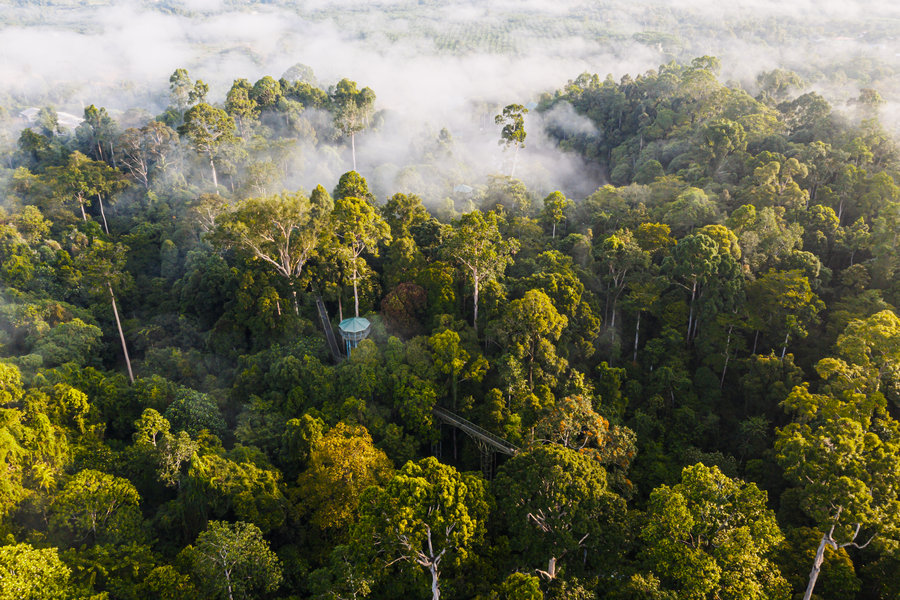
What's In This Guide?
The Maliau Basin Conservation Area is a super remote and diverse area of uninhabited forest that is effectively sunken into a massive crater-like area in Sabah, Malaysia .
The region protects a huge 588 sq.km of jungle that is regarded as some of the last relatively untouched wilderness in the world.
The area has never been logged or continuously inhabited by people, and the first expeditions into this extremely remote region only started as recently as 1988.
What Makes it Unique?
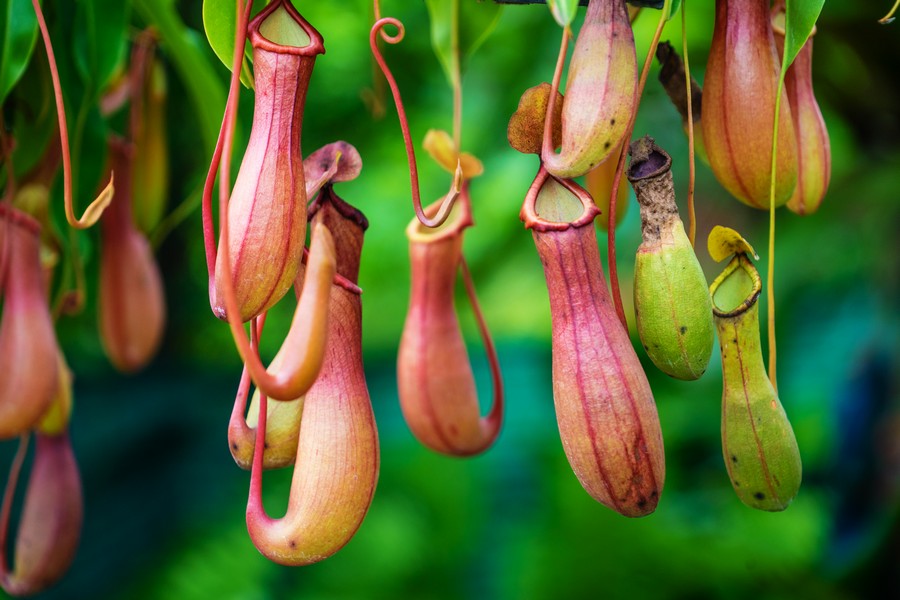
The Maliau Basin was originally a plateau. Over time it eroded away in the middle leaving behind a crater-like shape.
The unique topography means that the nature here has been and remains very isolated. The region effectively has its own ecosystem where water runs down from the surrounding ridge into the basin and exists through only one stream at the south-east end.
The complete isolation means you will find a wide range of unique plants and animals that are only found and even thrive in this part of the world. The critically endangered Orangutans, near extinct Sumatran Rhinos, and Pygmy Elephants are just some of the animals you may be lucky enough to encounter.
That is not to mention the almost 1,800 known species of trees and plenty other unique plants such as the iconic monster Rafflesia Flower and carnivorous Pitcher Plant that exist here too.
For nature and outdoor travelers, the Maliau Basin Conversation Area is an absolute must visit destination, and one of my top places to visit in Sabah .
How to get to the Maliau Basin?
The Maliau Basin Conservation Area is located in the southern central region of Sabah, approximately 40 kilometers from the Indonesian border of North Kalimantan.
There are two ways to get to the Maliau Basin from tourist centers in Sabah:
- Depart Kota Kinabalu in the north of Sabah. The journey takes about 5 to 6 hours.
- Depart Tawau in the far south-east of Sabah. The journey takes about 4 to 5 hours.
In both cases, most of the trip can be made by a standard 2WD standard car. It’s once you pass the Maliau Basin Gate and make the 27 kilometer (1 hour) trip to the Maliau Basin Studies Centre that a 4WD is definitely required.
Note: the Maliau Basin Studies Centre is the first base camp where accommodation and other facilities are located within the park.
Exploring (Hiking) in the Maliau Basin
To experience the Maliau Basin you really need to venture into the jungle on a multi-day hiking expedition. There are various options that run for 4 or 5 days each and all should be booked well before you travel. I suggest these tours with Amazing Borneo starting around USD 1,300 per person all inclusive.
Hikes typically run a clockwise circuit around part of the Maliau Basin with stays at three far-flung jungle camps overnight: Nepenthes Camp, Agathis Camp, and Ginseng Camp.
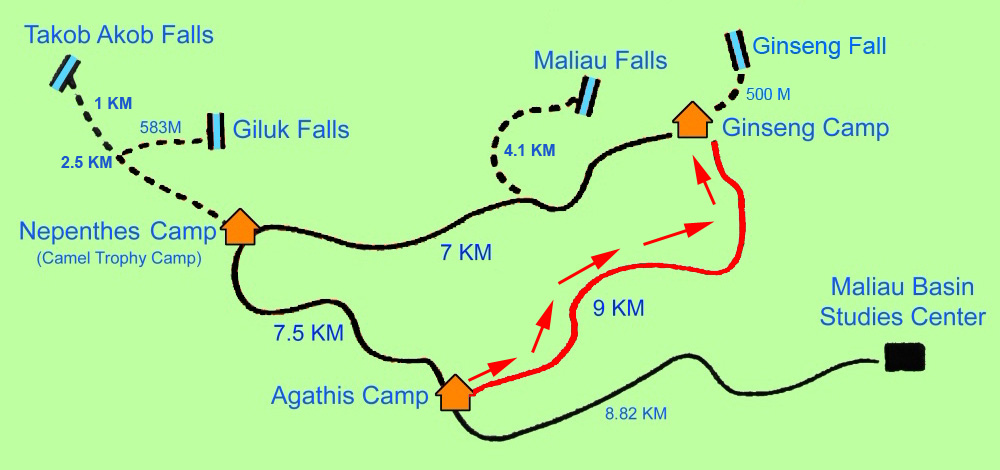
Each day you will hike between 7.5km and 9km at a minimum. There will be options to make additional hikes to a range of stunning waterfalls like Takob Akob Falls, Ginseng Falls, and the 7-tiered Maliau Falls , as well as walking through areas known for the Rafflesia Flower and Pitcher Plants.
Certain sections of the hike will be steep and difficult, with conditions made more strenuous by the hot and humid Sabah climate. You should be fairly fit and well equipped before making this trip, as the difficulty should not be underestimated.
Accommodation at the jungle camps is very basic consisting of hostel style bunk beds and squat toilets in the bathroom. This is not an experience for the luxury traveler but built for the intrepid and nature enthusiasts.
Short on time, or just prefer comfort? There are also quicker 2 Day / 1 Night tours to the Maliau Baisn . Typical itineraries depart Kota Kinabalu in the early morning with a stop at the rural town of Keningau along the way. Spend a night in the jungle at the more comfortable accommodation in the Maliau Basin Studies Centre, then explore the jungle on a shorter walk and take in the views from the Sky Bridge Observation Tower.

Best Time to Travel to the Maliau Basin
It is ideal time to travel to the Maliau Basin is during the dry season which goes from January to July. April and May are the driest and most comfortable months. That said, Sabah is never really dry and always seems to have incredibly high humidity levels.
The wettest months in Sabah are August and December. You’ll want to avoid these months as trekking for days in heavy rain just won’t be enjoyable.
Other Practical Tips
Food: there are no supermarkets or shops inside the Maliau Basin. Any food you want in addition to what is offered on the tours should be purchased in Kota Kinabalu or Tawau first, with a final opportunity to do some shopping at smaller towns along the way.
Clothing: Sabah is always wet, even in the dry season. Pack quick drying clothing, a waterproof backpack cover to protect your electronics, and leech socks.
Shoes: Decent hiking boots are a must-have. I highly recommend the North Face Futurelight boots, they’re waterproof, light, and provide decent ankle support.
First Aid: Hydration tables, Antiseptic cream and Band-aids,
Travel Insurance: You will need coverage including helicopter evacuation before starting your trip. Get a free quote (and the cheapest coverage) with WorldNomads.
Where to After the Maliau Basin?
Haven’t skipped legs day in years? Go climb Mount Kinabalu the tallest mountain in Southeast Asia.
Want to explore the world’s best reef? Dive the amazing reefs around Sipadan Island east of Semporna.
Island hopping on the agenda? Slow down and hit up Sabah’s remote Mantanani Islands .
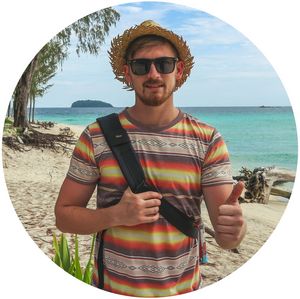
Let me show you how to travel Asia better, further, and easier than you can imagine. The highest waterfalls, remote islands, best street food, and plenty more! Josh Shephard
Follow on Instagram for Daily Travel Secrets

Try My Free Asia Travel Itinerary Builder!
It's totally 100% amazingly free (for now).
Send To A Friend!
Nearby Destinations For You!
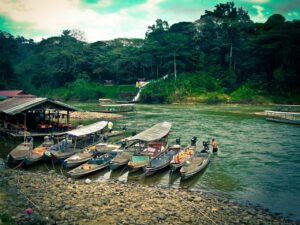
Exploring Taman Negara National Park (Hiking Trails, Caves, and River Rapids)
Taman Negara National Park, nestled in Malaysia’s heartland, is a national treasure. This ancient rainforest sprawls across Pahang, Kelantan, and Terengganu, inviting explorers to experience
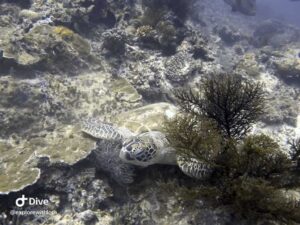
The Ultimate Diving Guide to Sipadan Island, Malaysia
Sipidan Island in Malaysia’s state of Sabah is regularly ranked as one of the world’s best dive destinations. This small island, formed by living corals
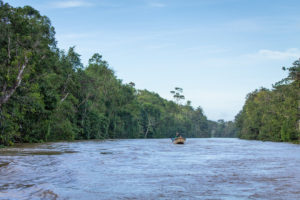
Exploring the Belum Rainforest, Malaysia’s Amazing Unspoiled Wilderness
Belum Rainforest, tucked in the northern part of Peninsular Malaysia, stands as an unspoiled paradise, where nature thrives. This ancient rainforest with a broad biodiversity
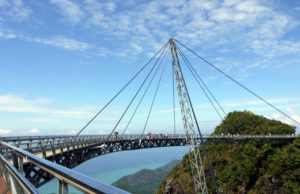
3 Days in Langkawi, An Easy Step-by-Step Itinerary
Langkawi is a Malaysian archipelago of almost 100 islands where you will find amazing beaches, waterfalls, and plenty of nature.
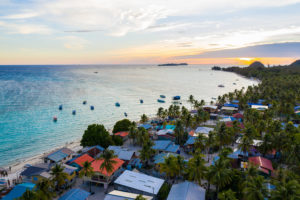
Don’t Miss the Amazing Mantanani Islands of Sabah
Discover countless diving opportunities and pristine beaches at the amazing Mantanani Isalands. Remote and secluded, yet just under three hours from Kota Kinabalu!
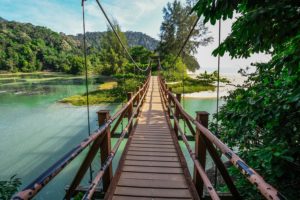
3 Days in Penang – A Step by Step Penang Itinerary
This three day Penang itinerary will take you to amazing beaches, scenic lookouts, loads of food, and wandering through the streets of Old Georgetown.
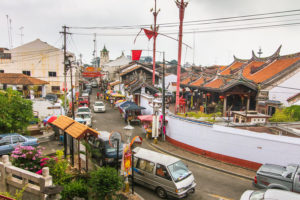
7 Easy Things to do in Melaka, Malaysia
Once Southeast Asia’s top trading port, now a UNESCO World Heritage site. Melaka combines the influences of Dutch, Portuguese, Chinese, and Japanese cultures into a very diverse town.
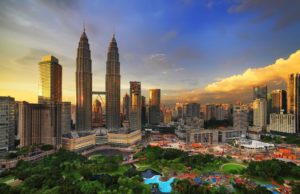
9 Great Things to Do in Kuala Lumpur in 2020
9 Great Things to Do in Kuala Lumpur Are you planning to visit Kuala Lumpur soon and looking for creative ideas about things to do
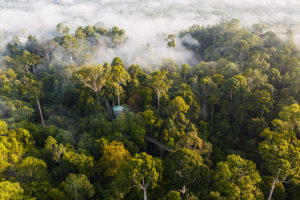
12 Awesome Things to do in Sabah Right Now!
Top Things to do in Sabah, Malaysia Sabah is a super diverse region of Southeast Asia, crammed into a relatively small area. Hike Mount Kinabalu,
Where Will You Go?
Search from over 150 blogs posts covering Asia, Pacific, and Europe.
Travel Resources
Is Travel Insurance Worth It?
What To Pack For Thailand
Cheap Travel Tickets for Asia
Follow Me on Social!
Built with the flexibility of Elementor Pro and the hosting speed of Cloudways .
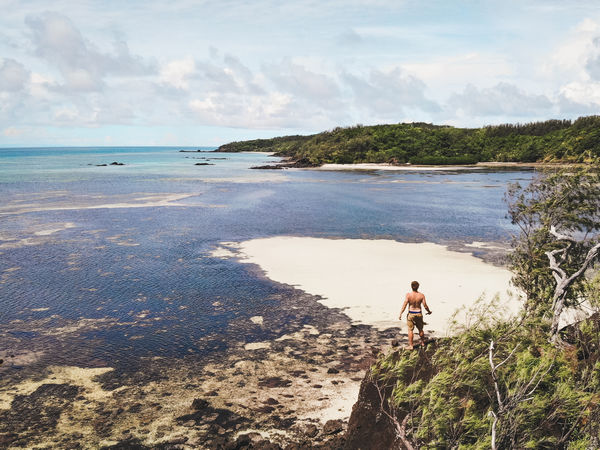
Discover Places Like This
Follow me on instagram.
for my personal insider travel tips
Maliau Basin Conservation Area
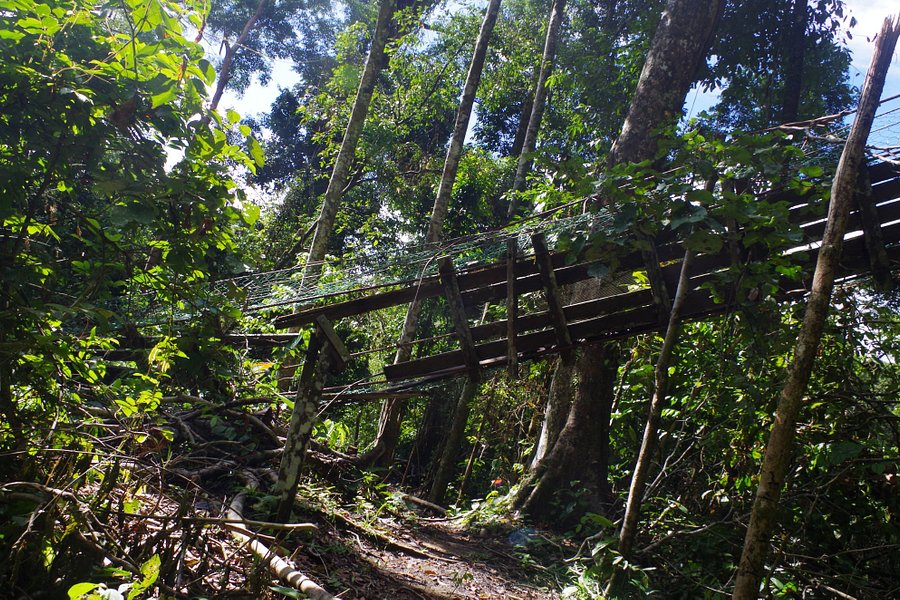
Most Recent: Reviews ordered by most recent publish date in descending order.
Detailed Reviews: Reviews ordered by recency and descriptiveness of user-identified themes such as wait time, length of visit, general tips, and location information.

Also popular with travelers
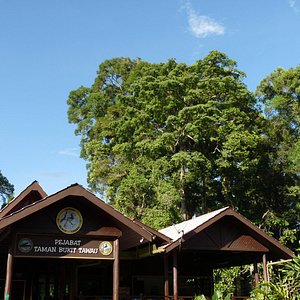
Maliau Basin Conservation Area - All You Need to Know BEFORE You Go (2024)
- Sun - Sat 8:00 AM - 5:00 PM
Borneo Expedition: Maliau Basin - Sabah's Lost World Trek
8 days | trek pristine, prehistoric wilderness in ‘sabah’s lost world’.

Deep in the heart of Borneo’s Sabah lies a land so wild, rugged and isolated that its beauty has been seen by few people. Welcome to the glorious Maliau Basin, a circle of lush forest and waterways rimmed on all sides by steep cliffs and embankments. Our 8-day trekking expedition takes you into this protected, restricted-access area to discover wild orchids and cascading waterfalls set in forest so green it seems to glow. With a homestay in a historic village and a well-earned night in a hotel bookending a three-and-a-half-day trek, this trip is for people seeking active adventure, natural splendour and a personal challenge.
Trip overview

- Spend three-and-a-half days trekking in one of the most pristine self-contained environments on earth, parts of which are still yet to be explored.
- Begin your adventure with a homestay with a Dusun family in Tambunan, including a local village tour to a house filled with headhunter skulls.
- The myriad waterways that flow into the basin’s Maliau River have created dozens of known waterfalls. Take in their hidden beauty during your trek, including the seven gorgeous tiers of Maliau Waterfall.
- Wonder at the bizarre flora that has adapted to this environment, like ‘ant plants’ that survive and grow by feeding on the waste of the ants that live on them.
- Tourism to the basin is restricted, which means after this trip you’ll be part of a very exclusive group of people to have experienced the majesty of this wilderness.
- The three-and-a-half-day trek in the Maliau Basin will be very challenging, even for experienced trekkers. Sections involve scaling vertical ladders and scrambling for hours at a time. You will need a high level of fitness and mental fortitude in order to participate in this adventure. The reward for those who are up to the task? Exploring where few people (and even fewer foreigners) have ever set foot.
All travellers who enter the Maliau Basin Conservation Area with the intention of hiking must have travel insurance that includes emergency helicopter evacuation.
- Porters are available at extra cost during the trek, but this trip does not include porters in the price.
- During the trekking portion of this trip, you will sleep in basic camping huts on stretchers or bunk beds. Toilets will be squat style during this time. There are multiple nights without showers while on the trek.
- You will need to bring quality shoes made for hiking in wet and slippery conditions. Our local experts recommend a local shoe colloquially known as the ‘kampung Adidas. These are similar to rubber soccer boots with spikes, and your leader can help you purchase these. You must also bring a hat, a reusable water bottle, a water purifying method, leech socks (or two pairs of football socks which can also be bought locally) and sunscreen.
- Did you catch that comment above about leech socks? Yep, leeches thrive in damp environments, so the many waterways of the basin are a haven for the critters. You’ll need to dress to minimise skin exposure, keep strong insect repellent handy and have a tolerant attitude to creepy crawlies. Doubling up long football socks is a great way to protect yourself from leeches.
Selamat Datang! Welcome to Borneo, Malaysia. Your adventure begins with a welcome meeting at 6 pm this evening. If you arrive early, you can immerse yourself in the history of this intriguing city between the Borneo jungle and the South China Sea at the Sabah State Museum.
- Hotel (1 night)
There are no meals included on this day.
It’s very important that you attend the welcome meeting as we will be collecting insurance details and next of kin information at this time. If you are going to be late please let your travel agent or hotel reception know. Ask reception or look for a note in the lobby for more information on where the meeting will take place.
You'll wake with excitement for your first full day of Intrepid adventure today. And, if it's the right time of season, we'll kick things off with a walk near the Tambunan Rafflesia Centre in search of the famous Rafflesia Flower, the largest flower in the world, with a local guide leading the way. Then, we'll bid farewell to the modernity of Kota Kinabalu and make your way to tonight’s homestay, located in the district of Tambunan. You'll arrive in Sunsuron Village and meet your Dusun hosts. While the government counts the Dusun people as part of the larger Kadazandusun indigenous group, they have a culture distinct from the Kadazan people. In the afternoon, you'll join a walking tour of the village and explore a local bamboo house and skull house. After some time discovering the sights here, you'll get a chance to cool off with a refreshing dip in a local river. This evening, feast on delicious home cooked treats.
- Homestay (1 night)
- Tambunan - Tambunan Rafflesia Center
- Tambunan - Kampung Sunsuron village tour
The group will be split among multiple local homes, all within walking distance of each other. All rooms are twin share and each home has one to three bedrooms. As we are staying with locals, the style and facilities vary from home to home. Some rooms have en suite toilets while others are in the main house. Toilets may be either squat or sit down style.
After breakfast this morning, depart for the Maliau Basin Conservation Area by private vehicle. Today's journey is on the longer side, so it’s a good idea to have a book, podcast, or some questions ready for your leader about the history of the area to pass the time. Arrive in the basin in the late afternoon and settle in at the Study Centre, a research base where you will spend tonight in dormitory-style accommodation. Later head to the Maliau Observation Tower. From here you’ll enjoy panoramic views over the area you’ll spend the next several days exploring.
- Hostel (1 night)
- Maliau Basin - Maliau Rim Observation Tower
Today’s driving time is approximately 6-7 hours including lunch break.
The next three days will be spent trekking through wilderness. Please note that the hiking will be strenuous, and you will need a high level of fitness in order to participate in this adventure.
During the trekking portion of this trip you will sleep in basic camping huts on stretchers or bunk beds. Toilets will be squat style. Food on the trek will be simple and filling. Think rice, eggs, canned food and simple curries.
Porters are available at extra cost during the trek, but this trip does not include porters in the price. You will be able to stow your main luggage at the study centre before you depart on your trek. Please bring a day pack suitable for hiking and carrying essentials. Please see the Packing List for more info on what to bring with you.
After breakfast, make the drive to the starting point for your trek in Agathis camp and then listen to a briefing from a local trekking guide or ranger before starting the hike to Nepenthes Camp. Your trekking adventure begins with the most difficult portion, a seven-and-a-half-kilometre hike, uphill to the rim of the basin (elevation 1300 metres). Depending on the conditions, the time spent hiking today will be around 6 hours. You'll hike over dense detritus while surrounded by towering trees, looking out for the incredible insects, flowers and mammal species that live among them. Today you'll encounter your first set of metal ladders, there will be quite a few of these over the next couple of days. These are not for the novice trekker, you will need to have an adventurous spirit. These ladders are fixed to the ground, rock or tree trunks which help you to climb the steep terrain. Some ladders along the trail can be almost at a 90 degree angle. There are also fallen tree trunks used to cross the rivers. But don't worry, while the going will be tough, you’ll be rewarded by the immense beauty of the environment. If time permits, it may be possible to stop at terraced Giluk Falls or cascading Takob Akob Falls. You'll arrive at Nepenthes Camp in the late afternoon or early evening.
- Camping (under basic shelter) (1 night)
- Maliau Basin - Stargazing activity
- Maliau Basin - Trek from Agathis Camp to Nephentes Research Station - Free
Today's hiking distance is about 7.5km long and will take between 5-6 hours to complete.
Today you’ll get the chance to check out not one, not two but three stunning waterfalls. And what's best is you’ll hike your way to each one, making the cascading reward at the end even more worth it. After about 2 hours of trekking you’ll reach the first falls, Takob-Akob Falls, which plunge 38 metres into the rainforest below. Next up, hit the trail towards Fowzi Waterfall where you’ll sit down for a picnic lunch and enjoy the views. Finally, you’ll discover Giluk Waterfall, with an easy trek to finish the day. This evening you’ll head back to your camp at Nepenthes Camp to relax and rest your weary legs before another big day on the trails tomorrow.
- Maliau Basin - Takob Akob Falls, Fowzi Falls & Giluk Falls trek
Today's hiking distance is about 10km long and will take between 6-7 hours to complete.
Today’s trek is to Maliau Waterfall, continuing to Ginseng Camp in the evening. This 10-kilometre hike follows a relatively gentle trail to the seven-tiered falls. Listen out for the calls of Borneo gibbons, which are plentiful in the area (though hard to spot). Depending on recent rainfall, you may hear the thunder of the falls before you see them. The highest tier is 28-meters-tall, with each section set a fair distance forward from the last, making this a captivating sight.
- Maliau Basin - Trek to Maliau Falls & Ginseng Camp
Today's hiking distance is about 16km long and it will take up to 10 hours to complete.
Set off in the morning and begin the final leg of the nine-kilometre trek to Agathis Camp (approximately 5—6 hours). Arrive at the camp hut at around 1 pm. Make the return drive by private vehicle to Kota Kinabalu and arrive at the hotel by 7 pm. Treat yourself to a shower, then choose whether to join your group for an optional final dinner together.
- Maliau Basin - Trek from Ginseng Station to Agathis Camp
Today's hiking distance is about 9km long and will take up to 6 hours to complete.
You will be reunited with your main luggage today, as our driver will bring them to the transport pick-up point. We recommend leaving a change of clothes in your main bag in case you want to change out of any wet clothes immediately. The first opportunity for a shower will be back at your hotel in Kota Kinabalu.
Your adventure comes to an end after breakfast.
7 breakfasts, 5 lunches, 5 dinners
Private mini van, on foot
Hotel (2 nights), Homestay (1 night), Dormitory (1 night), Camping under basic shelters (3 nights)
Dates and availability
Important notes.
1. A single supplement is available if you’d prefer not to share a room on this trip. The single supplement excludes Days 2,3,4,5, and Day 6 where you will be in shared accommodation and is subject to availability. Please speak to your booking agent for further information. 2. The trek in the Maliau Basin will be very challenging, even for experienced trekkers. Sections involve scaling vertical ladders and scrambling for hours at a time. You will need a high level of fitness and mental fortitude in order to participate in this adventure 3. It is a condition of entry to the Maliau Basin Conservation Area that all hikers have insurance cover that includes emergency helicopter evacuation. You must take proof of this with you on the trip. 4. Drone usage is not permitted, and DLSR must be declared on arrival at the Conservation Area and a permit acquired for use (100 MYR per camera). 5. No styrofoam, polystyrene containers or canned foods are permitted in the Conservation Area and all litter must be brought out. 6. Malaria can be a risk in this area. Ensure you take precautions against mosquitoes.
Want an in-depth insight into this trip? Essential Trip Information provides a detailed itinerary, visa info, how to get to your hotel, what's included - pretty much everything you need to know about this adventure and more.
Check back later or explore reviews for similar trips.

- Mount Kilimanjaro
- Mount Kenya
- Mount Toubkal
- Mount Aconcagua
- Mount Everest
- Mera Peak and Island Peak
Mount Kinabalu
- Himalayan Mountains
- Borneo treks
- Nepal treks
- Moroccan Atlas treks
- Treks in East Africa
- Trek in Europe
- Wildlife Safaris
- School Expeditions
- Family Holidays
- Medical Electives
- Private Expeditions
- Indonesia and Papua
- Experiences
- Trip Finder
- Trip Leaders
- Sustainable Tourism
- Adventure blog
- Add a review
- Trip reviews
Ask Us A Question...

Orou Sapulot and Murut homestay and the Maliau Basin Sabah's Lost World
- Sabah's Lost World, Maliau Basin
Dates & Bookings
Sabahs lost world - the maliau basin.
This is a nine-day journey into Borneo rainforest to visit remote Murut communities , climb the limestone pinnacle rising above the tree canopy and trek into the depths of the Maliau Basin to the heart of what is Sabah’s Lost World and cross the rest of Sabah through the Danum Valley reserve and fly out from Lahad Datu or Tuwau.
Starting in the coastal capital of Kota Kinabalu, this traverse of Sabah ventures inland to the Orou Sapulot region to experience the Murut communities and family homestays, exploring the famous 800ft limestone pinnacle Batu Punggul and learning about their historic headhunting heritage, and negotiating the winding waterways on an exhilarating river excursion. The journey continues on old logging roads deeper into Sabah’s centre and a four-day jungle trek into the mystical Maliau Basin.
A crater of primary forest, distinctive wildlife and striking waterfalls, the Maliau Basin is a dense jungle wilderness, and with no roads, an area only explored by foot. An excellent destination for jungle trekking and wildlife spotting, nature explorers will love this trip for discovering the wealth of natural beauty on offer. A highlight includes a trek to the famous Seven Tier Maliau Falls. From here the adventure finishes at the airstrip at Tuwau for the flight back to Kota Kinabalu. You can read more about how challenging the Maliau trek is on our blog, as is the main facts about the basin .
Sabahs Lost World Itinerary
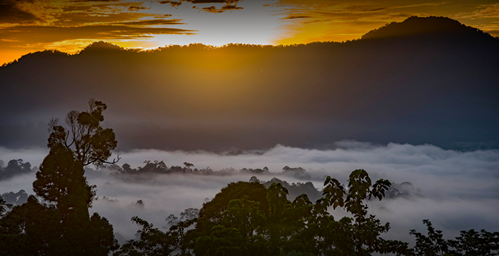
What Gear Do I Need to Visit Borneo?
For this trip you you will need good trekking boots which are lightweight and have ankle support, quick drying synthetic materials to wear, good sun protection like a broad rimmed hat, and a sleeping bag liner. During the day when trekking try cycling shorts and light trekking trousers or shorts with synethic T-shirts or light shirts, and a hat. Take a small towel for your face during hiking since it will be hot and humid. Keep a dry set of long sleeved clothes to change into at camp or the lodge. You don't need a lot of changes of clothes for jungle treks, and it's easy to rinse off damp clothes in the river and dry them out quickly in the sun for use again. Take sandals for the evening and long socks. It is important to cover up in the evenings and at dawn. Take a rucksack for the day hikes and a duffle bag. In your daysack you will carry a dry set, water bottle, camera and not much else.
Click our Borneo kit tip page to learn more about what type of kit you should bring with you to Borneo.
When is the best time to visit Borneo (click here for details) ?
Fitness for trekking in Borneo
To trek the land of Maliau Basin requires good physical fitness as the trails range from easy to steep and the terrain can be challenging. This adventure involves three days of trekking and lots of up and down quite steep hills, so it is recommended that visitors are reasonably fit and able to endure 6 to 8 hours of trekking per day. Remember to take it easy, pace yourself and enjoy the surroundings. The heat and humidity can be overwhelming at first but after a few days your body acclimatises to this environment.
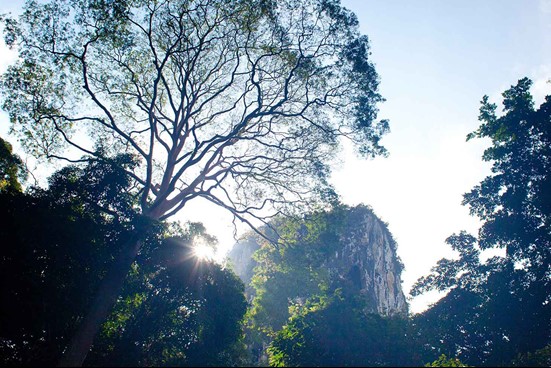
Though a porter is provided to carry food supplies, trekkers are responsible for carrying their own personal belongings and water, unless they are willing to pay an extra fee for additional porters. Trekkers stay at campsites equipped with basic facilities where your guide will officially be the ‘jungle chef.’
Camping in Maliau Basin
The rainforest is a surprisingly clean and pure place to visit. The canopy offers excellent shade from the intense sun keeping temperatures cooler than in the cities. However, it can be very humid and you will need to continually drink water. It is important to bring 2-3 litres of water with you and have frequent sips of water during the trek. You may want to use rehydration salt or tablets in your water to replenish loss of minerals to avoid muscle cramp. There is piped water at Agathis Camp and Ginseng Camp, and at Lobah Camp, which is the highest point of the trip, the water source is collected from rain water and is first used for drinking and cooking, then for cleaning and showers.
Sleeping is either in hammocks which we can supply or in basic huts on mattresses. You will need to bring a sleeping sheet or very light sleeping bag. The facilities are quite basic, and generally we recommend using hammocks.
Staying at a homestay in Borneo
After leaving Kota Kinabalu, you will be staying in homestays in the Orou Sapulot region with the Murut community. These homestays are comfortable but simple guest houses run by local families and will have beds with mattresses and bedding, and clean cold water bathrooms. You will have a separate room to the family, but may have to share with other guests in some cases.
Dos and Don'ts In The Maliau Basin Conservation Area
- No hunting is allowed
- Fire arms are absolutely forbidden.
- No collecting or trapping of any plant or animal specimens
- No slashing of vegetation or cutting of new trails
- No graffiti on rocks or trees
- All litter / rubbish must be brought out
- Visitors must only stay in the designated campsites
- Campfires can be lit only under the supervision of Rangers
BORNEO ADD-ON TRIPS
Before or after your trip there are also a number of optional Add-on trips / activities, or hotels that you may like to take advantage of to extend your holiday, or just to cover accommodation before or after joining us. Some of the options are shortened versions of some of our main Borneo trips, others are adventure or relaxng wind downs in their own right. These can be found on the 'More Information' tab on this trip page and the options include:
- A 3D2N ascent of Mount Kinabalu .
- 4D3N trek / climb of Mount Mulu , which is one of Borneo’s toughest - harder and more adventurous than Mt Kinabalu.
- 3D2N visit to some luxury in the Kawag Nature Lodge in Danum Conservation Area for relaxation and wildlife viewing.
- A visit to the tropical islands off the coast of Sandakan including glamping on Turtle Island or Libaran (or a bespoke diving trip to Sipadan Island).
- 2D2N visit to the Hibiscus Beach Resort , which is a stunning and idyllic boutique beach chalet set in a secluded cove on the Kudat peninsula on the northern tip of Borneo.
- 3D2N Big Fin Beach resort for snorkelling, diving, paddle boarding or relaxing at this private and secluded beach resort, just off the coast of Kota Belud, near Kota Kinabalu.
- 3D2N add-on trip to the Danum Valley Conservation Area , staying at the Danum Valley Field Centre, with guided treks through primary rainforest.
- 4D3N trek into the interior of Sarawak to live with the last nomadic tribe in Borneo, the Penan .
- 4D3N add-on with visits to the Sepilok Orangutan Centre and the Kinabatangan River for stunning wildlife safaris.
- 3D2N treat with a night at the prestigious and award-winning Borneo Rainforest Lodge in Danum Valley Reserve.
- Additional nights accommodation in Kota Kinabalu or for sightseeing and visiting the islands, staying in the Hotel Sixty 3 .
Why Choose Adventure Alternative for Borneo trips?
- We tailor our trips to the more unusual destinations on Borneo, and we have many years of experience managing unusual itineraries and destinations for all types of groups and individuals. We tend to avoid the mainstream packages offered by most local tour operators and like to use our expertise and knowledge to help people get the most out of the country.
- Our staff at Adventure Alternative Bornoe spend time researching new locations and activities to ensure that you will visit the most exciting and adventurous destinations, far from any hordes of other travellers.
- Adventure Alternative is built on a model of ethical business practices and a responsible travel ethos. Our awards for ' Best Personal Contribution' in 2009 and 'Best for Poverty Reduction' in 2013 highlight our commitment to these principles.
Sabah's Lost World Detailed Itinerary
Maliau basin: 'sabahs lost world' cost £2395.00.
This cost is based on minimum two people with a single person supplement of £450.00. Bespoke dates are acceptable and there are options for additional tours to extend your holiday.
Please contact us first before booking, so that we can availability and if there are others in the group.
- Accommodation throughout the trip in shared twin rooms unless otherwise requested
- All meals listed in detailed itinerary (B,L,D)
- 4x4 or minibus/car transport between destinations including airport transfers and transfer to Tuwau at the end
- Park fees, camping fees and park rescue fees
- In country team staff including an AA Borneo guide for the Maliau Basin section, and in-house guides for Sapulot
- 6% service tax paid only for hotel accommodation
- 6% sales tax for all holiday expenses
- Internal flights
- Personal Travel Insurance
- Personal Spending Money
- Hotel tax of 10RM (~£2.50) per night paid in cash at check in (only for hotel and lodge accommodation)
Deposit of £100.00 is required to book your place with balance due six weeks prior to the trip start date. We recommend obtaining travel insurance immediately after booking your trip.
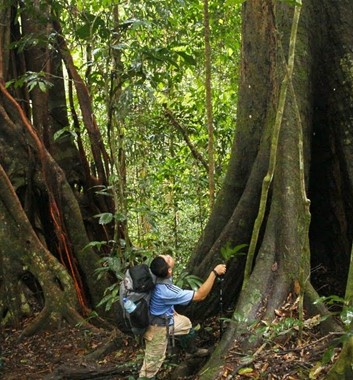
3D2N trek up Mount Kinabalu:
Day 1 - Transfer to Kinabalu park, twin/double room in Sutera lodge. Evening walk to see fireflies and pitcher plants. Day 2 - Check into Park, meet guide and start ascent. Overnight inLaban Rata lodge with buffet meal provided. Day 3 - Summit Mt Kinabalu and descend back to park gate, arriving afternoon and transfer back to KK.
Our price includes booking the climb for you, two transfers, accommodation at the park chalet and in the Laban Rata mountain hut and all meals on the mountain.
Price excludes payments to be made directly to Sabah Parks: entry fee, climbing permit, park guide and porter, insurance and internal transfer which is a cash payment of around £90.00 per person, plus a group fee of £70.00 for the Sabah park guide for up to five people. Breakdown on the cost tab of the Mount Kinabalu page .

Borneo Rainforest Lodge, Danum
3D2N stay at the prestigious Borneo Rainforest Lodge in Danum Valley Reserve. Guided safari walks and nature treks, plenty of wildlife viewing and relaxing in comfort surrounded by the pristine jungle environment. Check in 1400, check out 1130. Peak season 1st March - 30th April & 15th July - 15th October. Price is for a standard twin/double room with fan, in-house guide, one night drive, return transfers to and from Lahad Datu and permits. Not included: tourism tax of 6% for all trips (paid in cash), a peak season surcharge of 106RM per person and private specialist guides or extended night drives. Please check first for availability of rooms before booking.

Hotel 63, Kota Kinabalu
Good quality boutique hotel in the middle of Kota Kinabalu, easy walking to the riverfront, shopping malls and boats for day trips to the islands. Price is for a standard double or twin room and includes breakfast and wifi and service tax.

Hibiscus Retreat, Kudat
3D2N in a beach chalet for two people set in a secluded cove on the Kudat peninsula on the northern tip of Borneo. Perched on a small cliff top with unrivaled views of the South China Sea, Hibiscus Beach Retreat is a chalet perfect for couples. Price is for bed and breakfast only; local activities can be arranged on location. Flights are not included, there is a limited connection from Sandakan or KK, and there is a car transfer from KK which takes 5 hours.
Choose a scheduled date or contact us to set up private dates or a bespoke itinerary. The minimum deposit is £100.00 and the balance is due four weeks before travel.
- Duration 9 days or 12 days
- Numbers 2 minimum
- Comfort Moderate to Tough
- Accommodation Lodges, Homestay, Camps
- Top 10 Facts about Borneo’s Maliau Basin
- How challenging is a Maliau Basin Trek?
- Practical Information
- General Information
- Penan Tribe
- Borneo Preparation
- Borneo clothing advice
- Borneo Culture Tips
- Maliau Basin
- Avoiding malaria
- Travel vaccinations
- When is the best time to visit Borneo?
- Danum Valley - Trip Add-on
- Penan Tribe Trek - Trip Add-on
- Mount Mulu - Trip Add-on
- Mount Kinabalu - Trip Add-on
- Kawag Nature Lodge - Trip Add-on
- Borneo Rainforest Lodge - Trip Add-on
- Hibiscus Beach Retreat - Trip Add-on
- KK's Hotel Sixty-3 Add-on
- Big Fin Beach Resort - Trip Add-on
- Sepilok / Kinabatangan River - Trip Add
- Borneo Wildlife Tour, Sabah
- Mount Kinabalu trek
- Borneo Bike and Hike Challenge
Maliau Basin (Sabah’s Lost World)
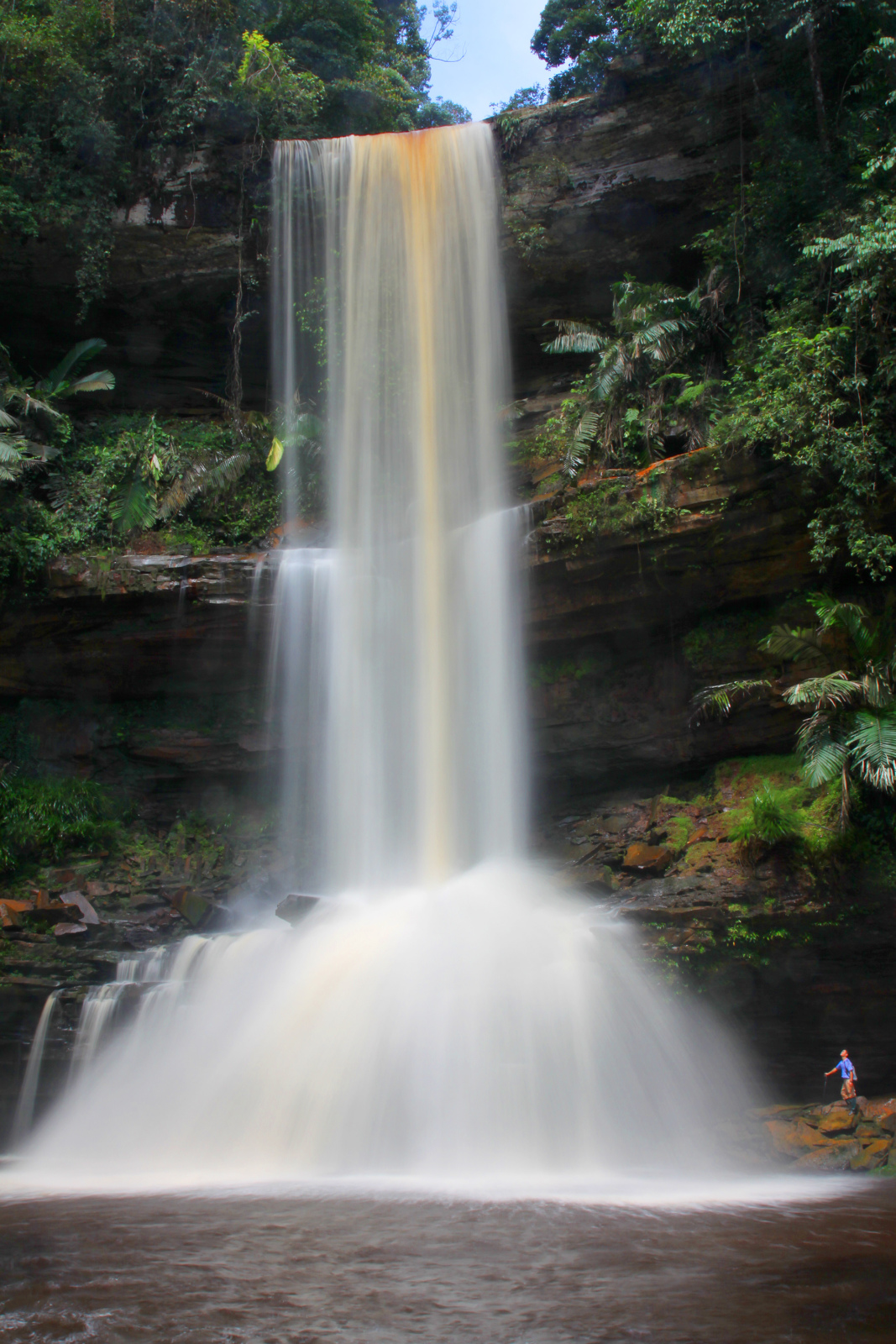
“Nature explorers will simply love the Maliau Basin as it is an excellent site for jungle trekking and bird watching. It contains an unusual assemblage of 12 forest types, comprising mainly of lower montane forest dominated by majestic Agathis trees, rare montane heath forest and lowland, and hill dipterocarp forest. The highlight of the adventure is to trek the majestic 7 tiers Maliau Falls.”
The diverse ecosystem makes an excellent jungle experience. At night, visitors may also take a night drive for wildlife spotting. Water babies can also take a dip in the beautiful waterfall.
Visitors must obtain permission to enter the Maliau Basin in advance from Yayasan Sabah. Also bear in mind that Maliau Basin is in a remote, atavistic and isolated area with limited access, communications and safety facilities.
Pre-arrangement with local tour operator is advised. The Maliau Basin expedition tour is usually packaged for 4 days 3 nights or 5 days 4 nights with physical requirement range from medium to strenuous.
Product Contact
Inno Travel & Tour Services Sdn Bhd Block E, Unit 28, 3rd Floor, KK Times Square, 88100 Kota Kinabalu, Sabah, Malaysia.
- +60 88 212 828
- [email protected]
- [email protected]
- sabahholidays.com
Other Attractions around Tongod
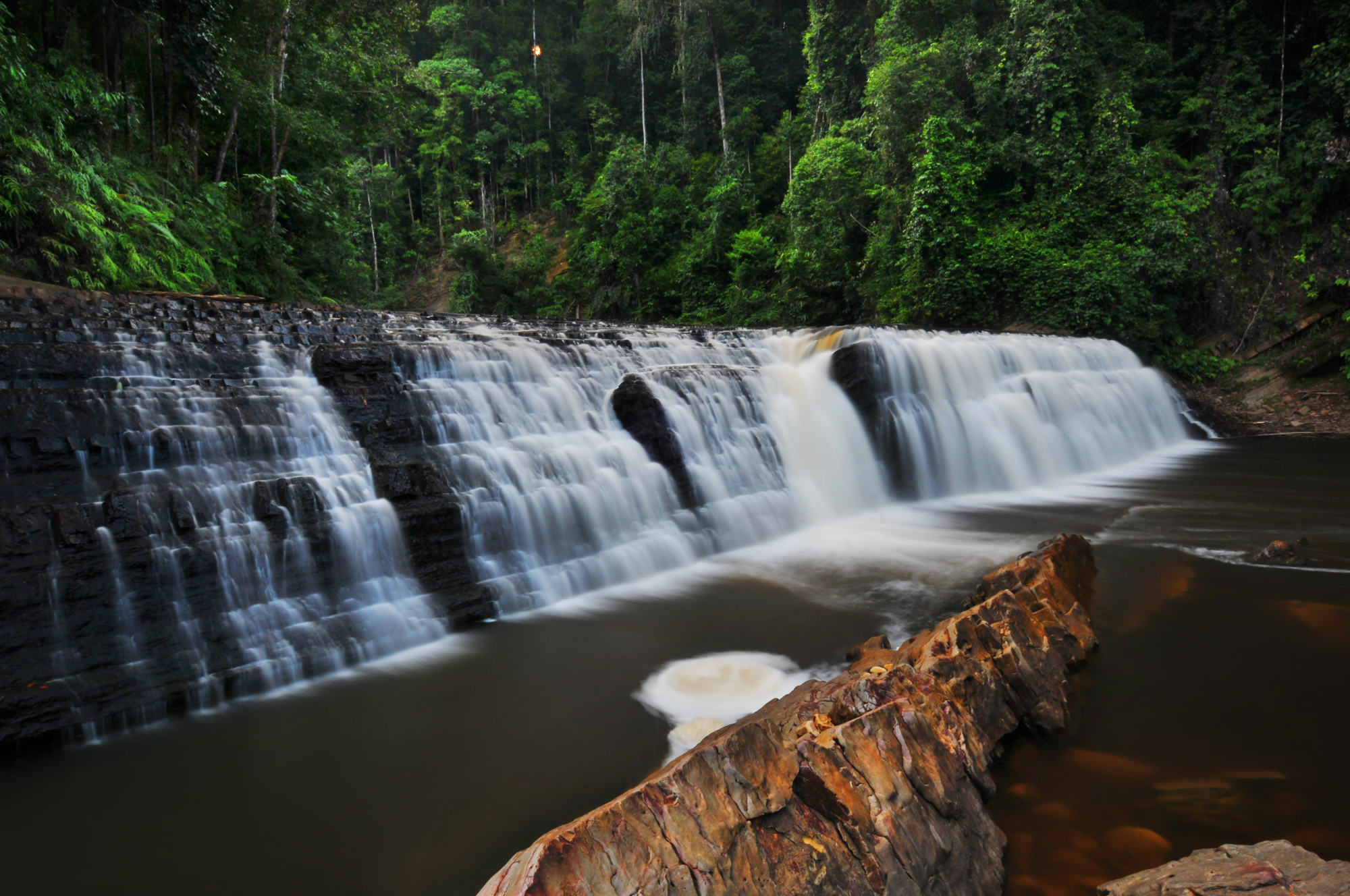
- About Borneo
- Sarawak Tours
- Island Tour Packages
- Mount Kinabalu FAQ
- Mount Kinabalu Trail Map
- Via Ferrata Trail Map
- Danum Valley FAQ
- Maliau Basin Tours – Jungle Expedition
- Sandakan Wildlife Tours
- Crocker Range Park
- Tabin Wildlife Reserve
- Nature Tour Package
- Wildlife Borneo Tour Packages
- Hiking in Borneo
- Adventure Climbing
- Multi Days Tours
- Tailor Made Tours

Exploring the Hidden Gem of Borneo: A Comprehensive Guide to Maliau Basin
Borneo is a land of lush forests, misty mountains, and unique wildlife, making it a top destination for adventurers and nature lovers. However, while many visitors flock to popular spots like Mount Kinabalu and Sepilok Orangutan Rehabilitation Centre, there is another hidden gem in Borneo that is just waiting to be discovered: Maliau Basin.
Maliau Basin, also known as the “Lost World of Sabah,” is a vast wilderness area located in the northeastern part of the island. This pristine rainforest boasts an incredible diversity of flora and fauna, including over 80 species of mammals and 300 species of birds. In addition to its incredible biodiversity, Maliau Basin is also home to a number of stunning natural features, such as waterfalls, caves, and hot springs.
Despite its incredible beauty and biodiversity, Maliau Basin remains largely unknown to the outside world, and only a handful of adventurous travelers have had the opportunity to explore its wonders. However, for those who are willing to venture off the beaten path, Maliau Basin offers an unforgettable wilderness experience that is second to none.
If you’re interested in exploring this hidden gem of Borneo, this comprehensive guide to Maliau Basin will provide you with all the information you need to plan your trip. From getting there to what to bring and where to stay, we’ll cover everything you need to know to make the most of your adventure.
Getting to Maliau Basin can be a bit of a challenge, as the area is located in a remote part of Sabah and requires a four-wheel drive vehicle and some off-road driving. However, for those who are up for the adventure, the journey is well worth it. Once you arrive at the Maliau Basin Conservation Area, you’ll be greeted by friendly rangers who will help you plan your itinerary and provide you with a map of the area.
The trek itself covers a distance of approximately 46 kilometers and takes around 4-5 days to complete, depending on your pace.
The trek starts with a journey to the Maliau Basin Study Centre, which serves as the starting point for the trek. From here, the trail leads through dense rainforest, with towering trees and lush undergrowth. As you make your way along the trail, you will come across a variety of wildlife, including orangutans, gibbons, and hornbills, among many others.
One of the highlights of the trek is the opportunity to visit several stunning waterfalls and natural pools, which provide a refreshing break from the humid jungle conditions. The seven-tiered Maliau Falls, in particular, is a breathtaking natural wonder that is sure to leave you awe-struck.
The trek also takes you through a range of different ecosystems, including lowland dipterocarp forest, montane forest, and sub-alpine meadows. This diversity of environments means that you will encounter a wide range of flora and fauna, from giant trees to tiny orchids, and from colorful butterflies to rare birds.
Along the trail, you will stay in basic accommodations, typically consisting of wooden huts. While the facilities may be basic, they offer a unique and immersive experience, allowing you to connect with the natural surroundings and truly appreciate the wilderness setting. One of the highlights of any trip to Maliau Basin is exploring the various hiking trails that wind through the rainforest. These trails range from easy strolls to challenging treks that require a high level of fitness, but all offer the chance to see some of the incredible wildlife and natural features of the area. Be sure to keep an eye out for the elusive clouded leopard, one of the rarest and most beautiful big cats in the world.
In addition to hiking, there are plenty of other activities to enjoy in Maliau Basin, it is also a potential birdwatching destination. One of the most popular attractions in the area is the Maliau Basin Skybridge, a 400-meter-long suspension bridge that offers stunning views of the rainforest canopy, and of course the ‘Great Maliau Falls’
If you’re planning a trip to Borneo and are looking for an off-the-beaten-path adventure, Maliau Basin is a must-see destination. With its incredible biodiversity, stunning natural features, and remote location, it offers a wilderness experience that is truly one-of-a-kind. So pack your bags, lace up your hiking boots, and get ready to explore the hidden gem of Borneo! Click here to view the itinerary .
- About Sabah
- Booking Terms
- Jalan Imbaan, Kampung Baru Putatan, 88100 Kota Kinabalu, Sabah MALAYSIA
- Hotline : +60 14 205 1269
- Email : [email protected]
TOUR DESTINATIONS
- Sabah Tours
- Maliau Basin Tours – Jungle Expedition
- Danum Valley – Orangutan tour
- Diving Sabah
- Family Packages
Outback Venture is a specialized Borneo Tour company based in the heart of Malaysian Borneo’s most accessible and diverse tourism region Sabah , Kota Kinabalu. Fully licensed with extensive first-hand experience from a team of local insiders, we craft bespoke adventures that will help you make the absolute most out of your precious time…. and live out your wildest dreams.
Select Currency
- MYR (Malaysian Ringgit)
- SGD (Singapore Dollar)
- USD (United States Dollar)
- KRW (Korean Won)
- CNY (Chinese Yuan)
- THB (Thailand Baht)
- GBP (Pound Sterling)
- AUD (Australian Dollar)
- JPY (Japanese Yen)
- PHP (Philippine Peso)
- BND (Brunei Dollar)
4D3N Borneo Jungle Trek - Maliau Basin (Sabah's Lost World)
Tour highlights.
- Jungle Trekking and exploration of Sabah's Lost World Maliau Basin
- Discover untouched rainforest and changing forest vegetation bounded by escarpment reaching over 1,675M above sea level
- Breathtaking views of Maliau rainforest in the morning
- Visit spectacular 7-tiered Maliau Waterfalls
- Experience Amazing Wildlife and Bird Watching
- Jungle Night Drive or Night Walk
Choose Your Activity
Select Package Option and Local Operator
≻ ≻ ≻ 1 Package Options
What's included, what's excluded.
Crave for an experience of an adventure jungle trekking with the natural beauty and astounding scenery of Borneo’s last great wilderness, is Sabah’s Lost World Maliau Basin. This awe-inspiring biological wonderland is arduous to reach, and well suited for those who do not mind being away from the city comforts and are adequately fit.
What is so astounding about Maliau is its absolutely untouched rainforest that grows within the Basin areas with its forest vegetation that changes composition with altitude, Maliau Basin bounded by escarpment reaching over 1, 675 Meters above sea level where stands an utterly different health forest structure altogether.
It is a haven to experience Maliau Basin, trekkers with keen interest in bird watching easily lost track of time with the numbers of birds sighting it has to offer. Then there is for those who take keen in nature photography, the magnificent beauty of Maliau Fall is the highlight that also offers refreshing cool swim after a tired day trek.
Be astonished with the chance of seeing the diversity of mammal here, where gibbons’ call filled up the early morning and small but easily spotted Red Leaf monkeys swinging high above the canopy. Another fascinating mammal to look out for is the flying lemur. This peculiar mammal is an arboreal climber and glider with webbed feet and claws.
Presently Maliau Basin tour involves a five-day round trek from the nearest road access. It is an all camping jungle trekking expedition, with a low-impact adventure and wildlife tourism concepts. Maliau Basin awaits those adventurous at heart to experience her enthralling wonders and be lost in its natures splendor.
Did You Know?
Maliau Basin is not a crater or an extinct volcano; it is an uplifted plateau which has eroded in the middle giving it its saucer-like shape. There is only one river draining out of the whole Basin - the Maliau River! Because of its unique geological formation of sandstone & mudstone, Maliau is thought to have the highest number of waterfalls anywhere in Malaysia!
Recommended Attire
- Quick Dry T-shirt
- Trekking Pants
- Comfortable Trekking Shoes/Boots
- Leech Socks
Things You Might Want to Bring
- Change of Clothes and extra socks
- Waterproof Backpack
- Trekking Pole
- Insect Repellent
- Water Purification Tablets
- Personal First Aid Kit and Medication
- Personal Toiletries
- Porter Fees
- Water Bottle
- Sleeping Bag
Things You Should Know
- This tour is not recommended for children under 12 years old as it is much physical demanding during the tour.
- This trek is not suitable for the faint-hearted as there are four vertical ladders to traverse.
- Special permission is needed and separate charges are levied for professional photography or filming.
- Guest is to be accompanied by guide at all times and not allowed to wander on their own.
- The camp is very basic and you must be prepared to rough it out. However your meals will be well-taken care of.
- Humidity is high in the jungle, hence you must drink enough water to prevent dehydration throughout the trekking.
- The tour can be done throughout the whole year. That being said, dry season is usually between March to October.
- Tipping is like giving a hug. Although it’s never expected, it’s always very much appreciated.
Important Things to Note
- This tour package is based on join-in basis of shared guide and transportation.
- Activities are subject to weather conditions, and may be re-organised to best meet operational situations.
- We reserve the right to alter routes, timetables, itineraries and accommodation should conditions beyond our control render it necessary.
- All guests must purchase Personal Travel Insurance that covers emergency helicopter evacuation and submit to us a copy of the policy.
- Guest must submit to us a latest fitness certificate confirmed by physician or doctor. You need to have a good physical fitness as you are required to be outdoor most of the time.
Need Assistance ?
Make use of Sabah Travel's complimentary service to plan your travel with us.
5.0 1 reviews
Booking overview, limited offer.

MALIAU BASIN

The 390 km2 (39,000 hectares) Maliau Basin (Sabah’s Lost World) was originally part of a 10,000 km2 (one million hectares) timber concession belonging to Yayasan Sabah (the Sabah Foundation), an organization formed in 1966 through an Enactment by the State Legislative Assembly with the purpose of improving the standard of living and education of Malaysians in Sabah. In 1981 Yayasan Sabah voluntarily designated Maliau Basin (Sabah’s Lost World) as a Conservation Area for research, education, and training, along with Danum Valley Conservation Area that is further to the east.
The basin was ‘officially discovered’ in 1947, by a pilot. But it was not until 1988 that the first major scientific expedition organized by Yayasan Sabah and WWF Malaysia took place. The Murut, who traditionally inhabit the area but never settled in the forbidding basin have since time immemorial organized a yearly hunting expedition to the rich grounds of Maliau, and know of the seven-tiers waterfall, the Maliau Falls (picture) at its heart – but they also know of many more stories and legends that surround the place.
While all of this region is rugged, the saucer-shaped Maliau Basin (Sabah’s Lost World) is distinguished by its almost circular perimeter, sharply delimited on all sides by cliffs or very steep slopes up to 1,500m in height, making it insurmountable on foot from most directions. The highest point is thought to be Gunung Lotung on the north rim, which is over 1,600 m in elevation but has yet to be accurately surveyed. Resembling a volcanic caldera, the 25 km diameter Basin is a sedimentary formation comprised mainly of gently inclined beds of sandstone and mudstone.
The Basin represents a single catchment and is drained by a set of radiating tributaries of the Maliau River, one of which descends a magnificent series of waterfalls, known as Maliau Falls. Numerous smaller waterfalls have also been discovered throughout the Basin. The Maliau River then drains through a gorge out of the southeast of the Basin into the Kuamut River, which in turn feeds into the Kinabatangan, the longest river in Sabah.
After the 1988 scientific expedition, other parties showed their interest, but it was mainly in its rich coal deposits. However, international pressure became increasingly strong to preserve the world-unique area. In 1997 the Sabah State Assembly gazetted Maliau Basin as a Class I Protection Forest Reserve and increased its size from 39,000 to 58,840 hectares to include the outer northern and eastern escarpments and Lake Linumunsut . In 2000 intensive field surveys started as part of the preparation of the Maliau Basin Conservation Area Management Plan.
The first major expedition to Lake Linumunsut (Sabah’s only true lake) in the northern part of Maliau was conducted in 2001. By now, only about 25% of the total area has been mapped, and less than 10% have been studied intensively. Yet, the Basin has already yielded more new species of plants and animals than many other places over many more years of studies! In 2002 we celebrated the groundbreaking for the Maliau Basin Studies Centre Site by HRH Prince Henrik of Denmark and Tan Sri Datu Khalil bin Datu Haji Jamalul, the Director of Yayasan Sabah.
Now, talks are underway that the Maliau Basin may become Malaysia’s third World Heritage Site.
Visitors to Maliau Basin Conservation Area are welcome, but access is strictly controlled and permission to enter must be obtained in advance from Yayasan Sabah.
Extreme Jungle Treking
Maliau Falls
Large Flora and Fauna
Virgin Rainforests
Share This Amazing Location!
Related projects, kiulu river.
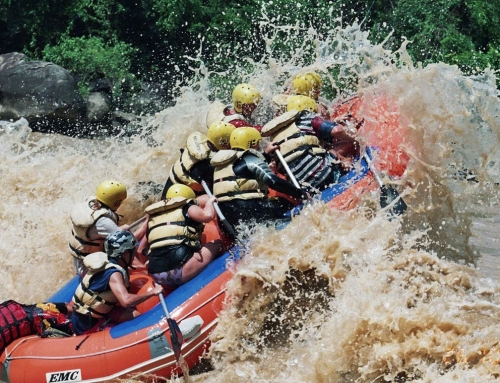
PADAS RIVER
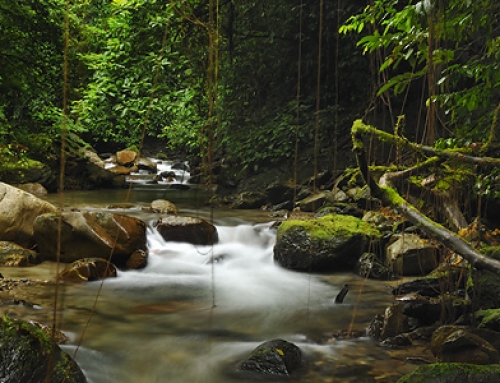
CROCKER RANGE PARK
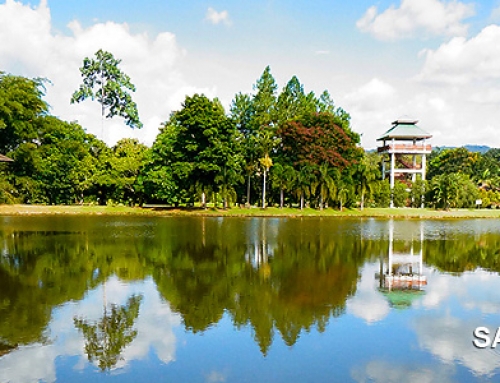
TENOM – SABAH AGRICULTURE PARK
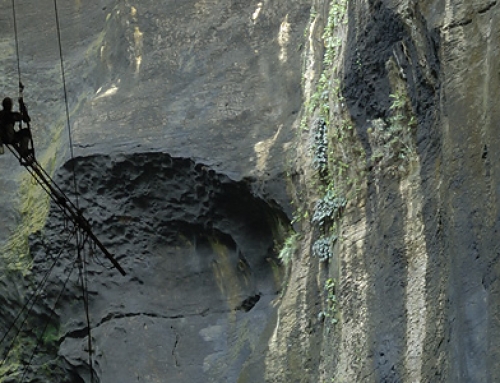
GOMANTONG CAVES
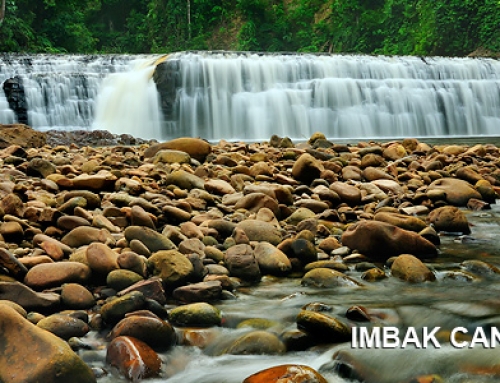
IMBAK CANYON CONSERVATION AREA
- Maliau Basin
MALIAU BASIN
The Maliau Basin is a place set on a sprawling 588.4 square kilometers land in Tawau, at the South Central Part of Sabah. It contains an unusual assemblage of 12 forest types, comprising mainly of lower montane forest dominated by majestic Agathis trees, rare montane heath forest and lowland, and hill diperocarp forest. The highlight of the adventure is to trek the majestic 7 tiers Maliau Falls. Keen visitors must, however, obtain a permission to enter the Maliau Basin in advance from Yayasan Sabah. Also bear in mind that Maliau Basin is a remote, atavistic and isolated area with limited access, communications and safety facilities. Nature explorers will simply love the Maliau Basin as it is an excellent site for jungle trekking and bird watching. At night, visitors may also take a night drive for wildlife spotting. Water babies can also take a dip in the beautiful waterfall. Trips to the Maliau Basin are best done in large groups. A 5-day, 4-night stay at Maliau Basin costs RM2730 nett for 2 pax adults (Malaysian) and RM3610 nett (non-Malaysian). For a group of 8 to 12 people, the rate for adults is RM1450 nett (Malaysian) and RM2270 (non-Malaysian). The rates in Ringgit Malaysia (RM) are inclusive of meals (breakfast, lunch and dinner), returned transfer (overland – Tawau to Agathis Camp), conservation and user fee (Campsites), rental of VHF radio, forest ranger cum radioman and guide. Maliau Basin Conservation Area is reachable by road either via Tawau or Keningau. The journey is on four wheel drive and depends so much on the weather as most of the journey is on logging roads to reach the Maliau Basin Security Gate. Journey from both Tawau and Keningau to the Security Gate of Maliau Basin Conservation takes 5 hours; the distance from Tawau to Maliau Basin Conservation Security Gate is 190 kilometers.
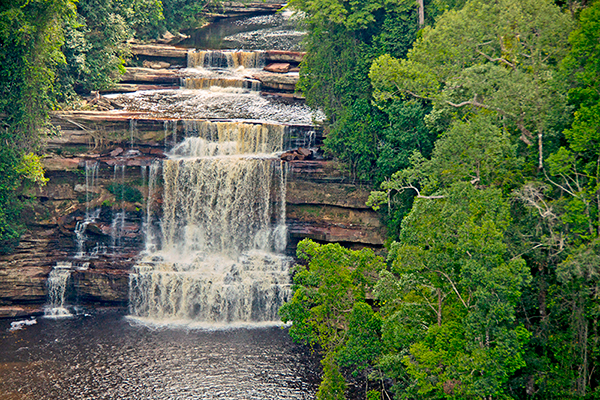
Recommended Tours
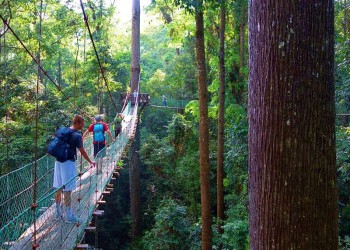
Borneo Jungle Trek - 4D3N Maliau Basin (Sabah's Lost World)
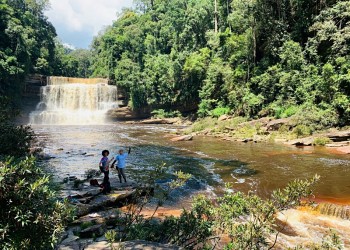
Borneo Jungle Trek - 5D4N Maliau Basin (Sabah's Lost World)

Instant Book Now 👍 Limited Time Best Deals
- About Sabah
- Getting to Sabah
- Quick Facts about Sabah
- People and Culture
- Things to Do in Sabah
- Moving Around Sabah
- About Malaysia
- Hotels & Resorts
- e-Guide Book (Free Download)
- Calendar of Events
- Malaysia Public Holidays
- Living Cost
- Flight Schedule Recommendations
- Food Directory
- About Sarawak
- Getting to Sarawak
- Quick Facts about Sarawak
- Things to Do in Sarawak
- Moving Around Sarawak
- Sarawak Maps
- Sarawak Calendar of Events
- Beach Resorts
- Island Resorts
- Kota Kinabalu City Hotels
- Mount Kinabalu Huts
- Kinabalu Park Hotels
- Kundasang Ranau Hotels
- Sandakan Hotels & Kinabatangan Lodges
- Tawau & Semporna Hotels
- Lahad Datu Hotels
- Kudat Hotels
- Danum Valley - Borneo Rainforest
- Tabin Wildlife Resorts
- Papar Resorts
- Kuching Hotels
- Mulu Hotels
- Miri Hotels
- Daily One Day Tours
- Mount Kinabalu Packages
- Mount TrusMadi Packages
- Wildlife Adventure
- Borneo Cycling Tours
- Sea Adventure (Snorkeling & Diving)
- PADI Diving Courses
- Jungle Trekking Adventure
- Sipadan Diving
- Free and Easy Tours
- Family Packages
- Honeymoon Packages
- Education Tours
- Corporate Incentive Tours
- Adventure & Sports
- Relaxing Islands
- Cultural Experiences
- Full Package Tours (Multiple Days)
- North Borneo Dinner Cruises
- Kinabalu Park Packages
- Kinabatangan Packages
- Danum Valley Packages
- Most Popular
- Bako National Park
- Danum Valley
- Discover Sabah Multiple Days
- Kinabalu Park
- Kinabatangan (Sukau/Bilit)
- Kota Kinabalu City
- Kudat Tip of Borneo
- Mount Kinabalu
- Mt Kinabalu Via Ferrata
- Mount Trusmadi
- Mulu Pinnacles & Caves + Miri
- Orou Sapulot
- Sipadan Island
- Tabin Wildlife Reserve
- Turtle Islands
- Sabah & Sarawak Dual States
- Transportation Services
- Mount Kinabalu Climb Packages
- Introduction to Mount Kinabalu
- Accommodation in Mount Kinabalu
- Via Ferrata
- Tips for Climbers
- Things to Bring
- Mount Kinabalu Video
- Maps and Trail
- Introduction
- Snorkeling Packages
- Diving Packages
- Diving Sites
- Diving Video
- General Information
- Meetings & Conventions
- Corporate Team Building
- Testimonial
- Mount Kinabalu Videos
- Video Gallery
- Why Travel With Us
- Life @ Amazing Borneo
- Awards & Recognition
- Sustainability
- Our Tour Guides
- How to Book
- Terms & Conditions
- Payment Options

Call us now: + (60) 88-448409 Email: [email protected]

You can view your booking, download your itinerary anywhere and anytime you want

MySabah.com
Travel guides to Sabah, Malaysia Borneo

Part 2 of 8. Trip to Maliau Basin, Sabah’s Lost World – Day 1
Continued from Part 1…
After a month of waiting, finally, it was the day to go to Maliau Basin. Though I had been preparing and looking forward to this trip, I still felt nervous when the moment came. In the morning of day 1, our group gathered in Kota Kinabalu. There were 5 persons in the group, i.e., me, Ms. S, Ms. D and Mr. T, and our guide Mr. J, an experienced naturalist who had been to Maliau many times.
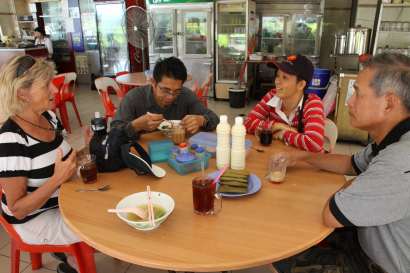
After we put our bags on our 4-wheel, we departed at 8:30am. Maliau Basin Conservation Area is located in south central Sabah, about 40 KM north of the Kalimantan border. FYI, there are two ways to go to Maliau Basin by land:
- From Kota Kinabalu: go to the Keningau town and proceed to the east for 160 KM. You will pass by Sook, Nabawan and Sapulut (Sepulot). It took about 5 to 6 hours.
- From Tawau: Maliau Basin is about 190KM at the west of Tawau. The ride takes 4 to 5 hours. (this was the only option when the new south-north “Keningau-Tawau” road was not available before 2008)
- If you are rich, charter a helicopter to take you there in no time (do invite me!).
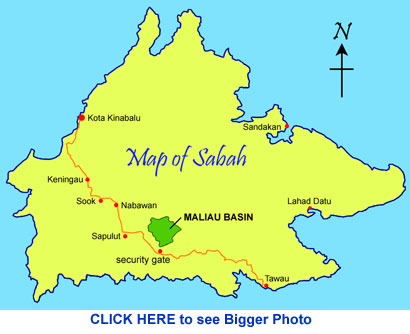
Stop over in Keningau Town
We arrived Keningau town around 11am, and we saw many logging trucks on the way. Some of us purchased Kampung Addidas (Village Addidas) shoes. Kampung Addidas is rubber shoe that has studs at the bottom and it is waterproof, making it the most suitable trekking shoe in the rainy and muddy conditions in tropical rainforest. It is only RM6 to RM8 a pair, very cheap but work better than your hundred-dollar hiking shoes.
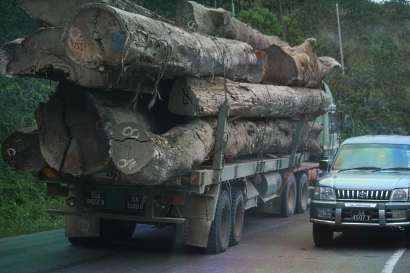
After we had our lunch in Juta Hotel, we went to Millimewa Supermarket to buy food supply. Since there is no restaurant deep inside the forest of Maliau, we have to carry and prepare our own food. We bought one week quantity of food supply consisted of rice, noodle, bread, can food, fruits, vegetables, fish, chicken, eggs, coffee & tea, salt & sugar, cooking oil, spices, drinking water, etc. Then we continued our road trip to Maliau Basin.
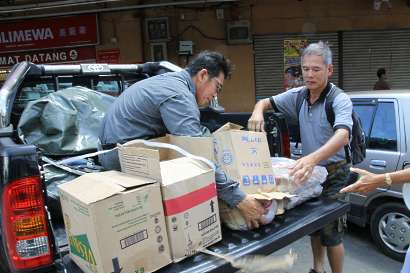
There is no petrol station between Keningau and Maliau Basin, so make sure your oil tank is full enough (don’t forget you also need gas for return trip). If your car breaks down, there is no phone line, and you will be in trouble. There is no toilet too.
Road to Maliau Basin
( Updated: May 2016) A few years ago, a road trip to Maliau Basin required 4-Wheel Drive because of the gravel road in bad condition. Now most of the road from Keningau Town to the gate of Maliau Basin is paved and highly accessible by sedan and small cars.
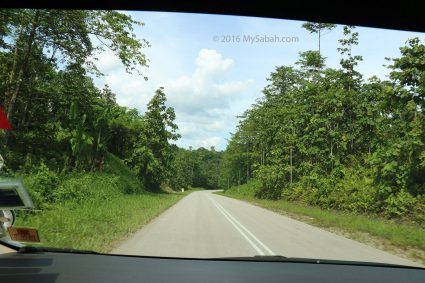
Personally I give this road a score of 70%. Overall, this asphalt road is quite ok, but you have to stay vigilant and be careful of potholes, uneven surface and slow logging trucks that show up from time to time.
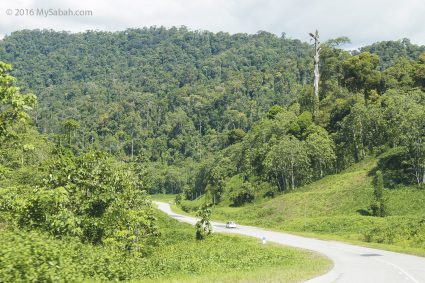
The 30-Km stretch of road between Nabawan and Sapulut (Sepulot) Town is poorly constructed, so it isn’t a very smooth ride on this section.
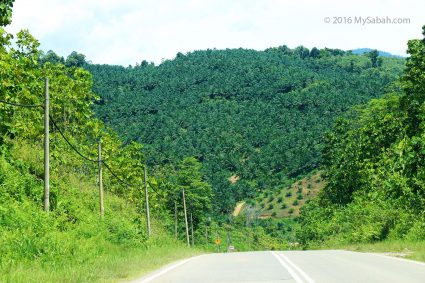
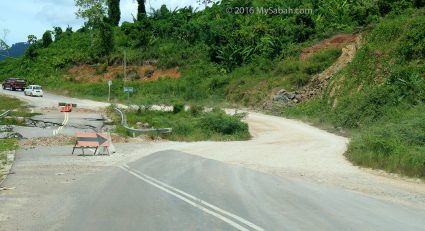
Though there are some damages, 95% of the road is in ok or good condition.
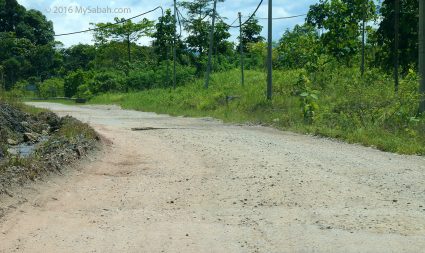
Please note the 27-Km road between the gate of Maliau Basin and its Studies Center is not fully sealed, so you might still need a 4-Wheel Drive, just to be safe.
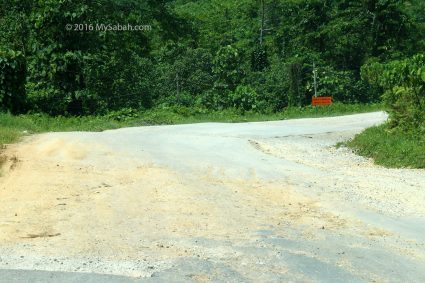
Maliau Basin Studies Center (MBSC)
We reached the security gate of Maliau Basin Conservation Area at 3:30pm. The gate is 300 Meters above the sea level and Maliau Basin is still 27 KM away. We registered at the gate for permission to enter.
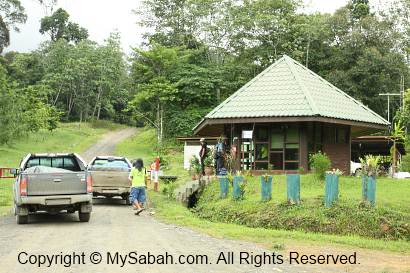
Maliau Basin Studies Centre (MBSC) is about an hour drive from the Maliau security gate, and that’s the place where we stayed for the first night. The road to MBSC is unpaved and can be very slippery and muddy after rain. Your car has a very high chance of stranded in the mud if it is not a 4-wheel drive. And the driver has to keep vigilant on the road condition at all time. Our car slipped once and almost fell down the slope. It was so close man…
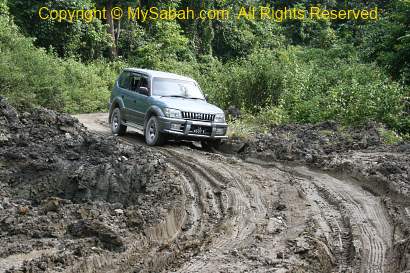
The forest view along the road is pleasing. We saw many fresh dung that belong to wildlife such as wild ox, elephant and deer. We saw a few Sambar Deer, the largest deer species in Sabah. They looked at our car briefly, with curiosity, before fleeing into the jungle.
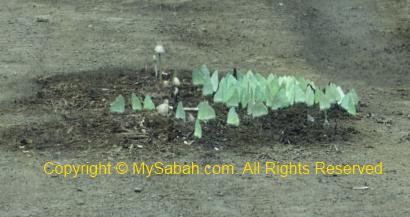
Maliau Basin Studies Centre (MBSC) is a big area consists of hostel, rest houses, administration & registration office, souvenir shop, conference room, laboratory and gallery. The buildings are wooden structure and look modern.
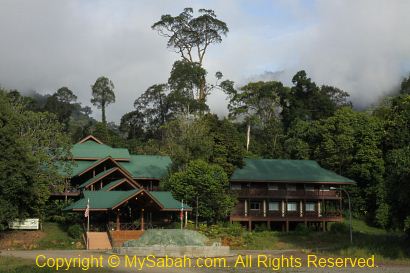
Below is a 2.5-minute video of Maliau Basin trip:
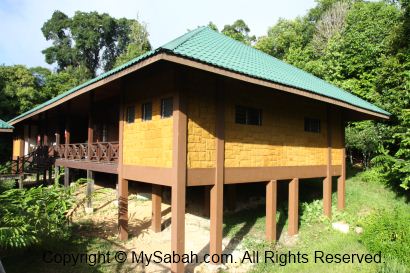
Our hostel is quite spacious and comfortable, and it is split into male and female sides at each side. Each side has its toilet and bathroom. There are about 6 sections at each side; each section has two double-deck bunk beds (for 4 persons) and one ceiling fan, a luxury dormitory setting.
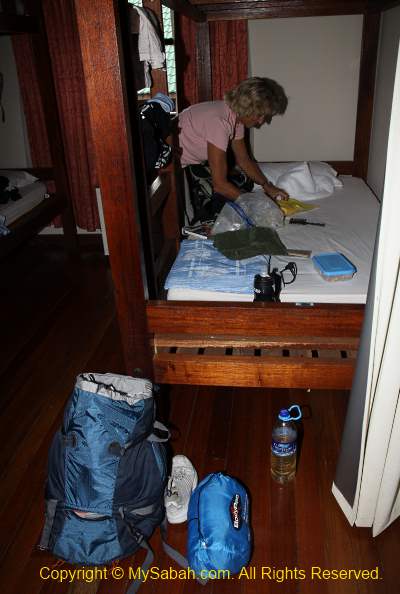
The hostel is very simple and has no TV and air-conditioning, but in the next few days, we find that this hostel is the best accommodation in Maliau! There is no other guest, except a wild boar wandering outside. FYI, 013 (Maixs) and 019 (Celcom) have mobile phone signal in MBSC. I am using the Digi (016), and I don’t know where is the fucking yellow fat man (mascot of Digi).
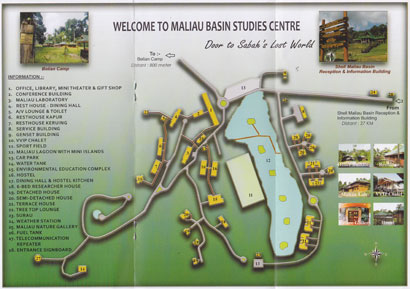
1st Evening in Maliau
After we checked in and unpacked our stuffs, it was about dinner time. We “tried” to cook “something” and called it a dinner. My lesson is – it is highly recommended that your group has at least one member who can cook, unless you bring your mom with you.
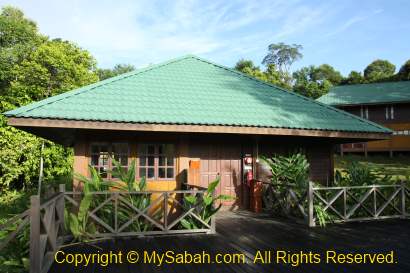
Above: the dining hall with kitchen. The kitchen inside is very well-equipped and has most things you need, e.g. cooking utensil, wok, rice cooker, gas stove, spoons & forks, plates & bowls, desks & chairs (for about 20 people), big & small knife, cutting board, cups, refrigerator, dish washing detergent.
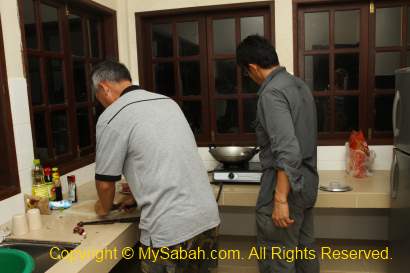
After the dinner, we attended a 1-hour video presentation of introduction to Maliau Basin and facilities at 8pm. The video gave us an overview on the geography, terrain, flora and fauna of Maliau Basin and the Do & Don’t. Then we had a discussion with the ranger to decide the number of porters we need. The porters will carry our food as well as our bags (up to 12 KG per porter).
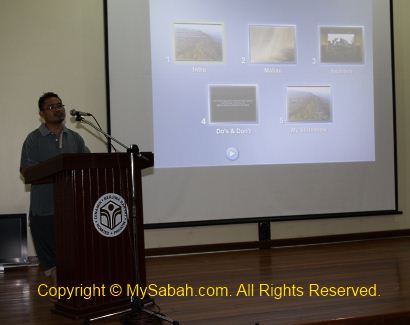
Before we went to bed, we divided the food into a few rations that to be carried by the porters to different camps (2 days in Ginseng Camp and 1 day in Nepenthes Camp). Again, a person who can cook will help a lot, coz he can plan the food menu and know the exact quantity of food for each ration. FYI, every camp has water supply, so you don’t need to carry one week of water supply with you.
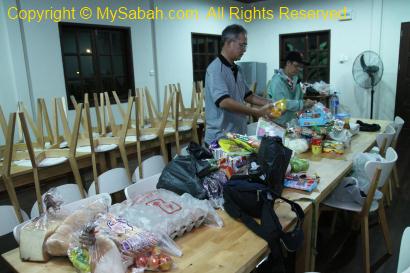
>> Next Article (Part 3)
Photos taken in Maliau Basin, Sabah, Malaysia Borneo
All Articles of Maliau Basin Trip: Part 1. Introduction to Maliau Basin Part 2. Day 1 in Maliau Basin Part 3. Day 2 in Maliau. Trekking to the 1st camp Part 4. Day 3 in Maliau. Maliau Waterfall Part 5. Day 4 in Maliau. Entering the garden of pitcher plant Part 6. Day 5 in Maliau. Skybridge & Night Safari Part 7. Day 6 in Maliau. Leaving Maliau Part 8. Conclusion & Notes
More Photos
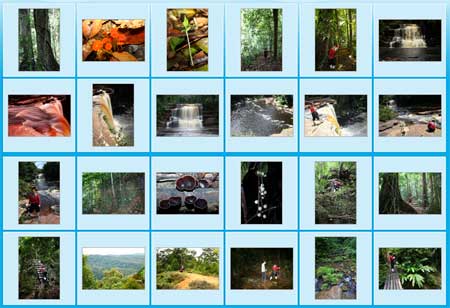
You might also like
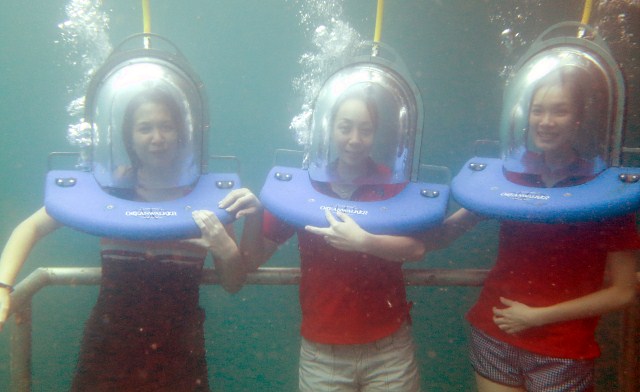
Sea Walking at the Largest Pontoon of South East Asia (Borneo Reef World)
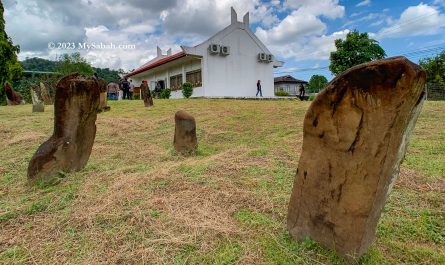

Pogunon Community Museum and the Secrets of the Dead
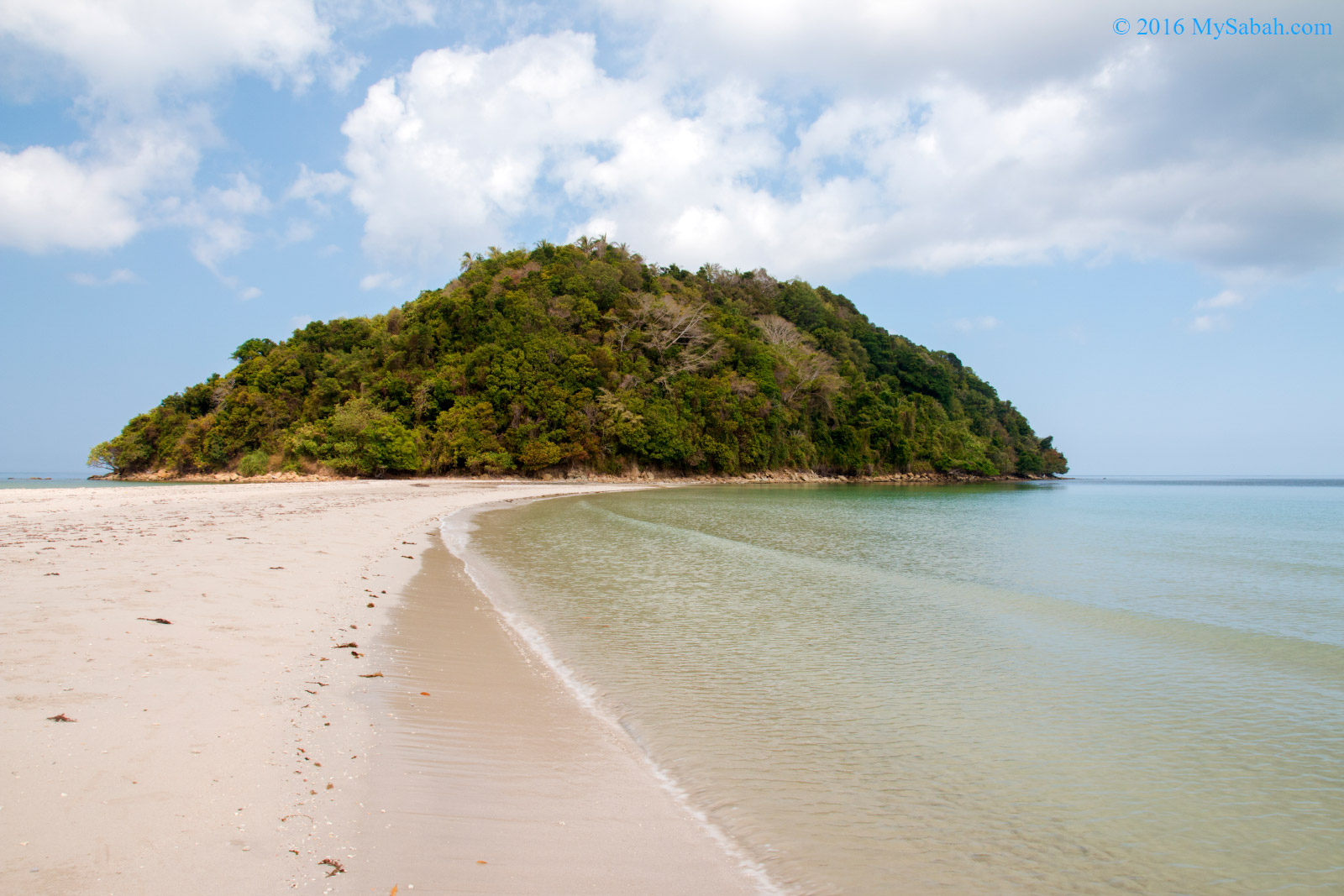
Kelambu, One Island and Two Beaches
4 thoughts on “ part 2 of 8. trip to maliau basin, sabah’s lost world – day 1 ”.
Finally, the much awaited posts on Maliau Basin. 🙂 Wow, you were so lucky bumping into deers and all even before you hitting deep into the jungle. So sad we didn’t see much of them when we were there. Enjoy reading this so much, can’t wait for the next post. 🙂
hi jipp, glad that u r the 1st commenter. sorry 4 d delay. coz i was researching maliau & read some books about it. compare to your light-hearted & interesting blog on maliau, mine is boring & lengthy lah..
I agree that the road to the Maliau Basin is really awful. When I was there 2 years ago it was a lot worse than it looks in your photos. I’ve heard it’s been improved a little bit since then, though. PS Just discovered this blog, I really like it! It’s nice to see a Sabahan who loves nature every now and then.
Hi Alessio, it’s great that thing is getting better. I also heard the road between Keningau and Maliau has improved a bit. Oh yes, I’m a nature enthusiast. My body will itch if I don’t go to forest over a month, lol.
Leave a Reply Cancel reply
- Skip to primary navigation
- Skip to main content
- Skip to primary sidebar
- Skip to footer
Explore the world with Singapore Airlines
Welcome to Sabah’s Lost World, a mysterious area clouded in obscurity
The uncharted wilderness of the Maliau Basin is turning to tourism to help preserve its hidden treasures
Story By Jacinta Lim
Published On June 22, 2021 Updated On August 24, 2021
*On World Rainforest Day, we bring back an old story that casts the spotlight on the enormous and ethereal forested hollow of Maliau Basin.
The winding tarmac road into Maliau Basin Conservation Area (MBCA) is flanked by the odd unmanned bulldozer. As far as the eye can see, this is the only sign of human life. On each side of the road, emerald rainforest stretches to the horizon. From the undergrowth, the cicadas’ mating siren is urgent and haunting, and overhead, the powerful thumping of hornbills’ wings evokes Pterosaurs in flight. It is easy to see why this place is known as “Sabah’s Lost World”, a real-life Jurassic Park – minus the dinosaurs.
Maliau Basin is one of very few places in the world that has never been inhabited by humans. The basin, around six hours’ drive south of Kota Kinabalu , is a saucer-shaped area covered in thick rainforest in excess of 390 square kilometres, enclosed by a steep escarpment that rises to a formidable 1,600 metres high.
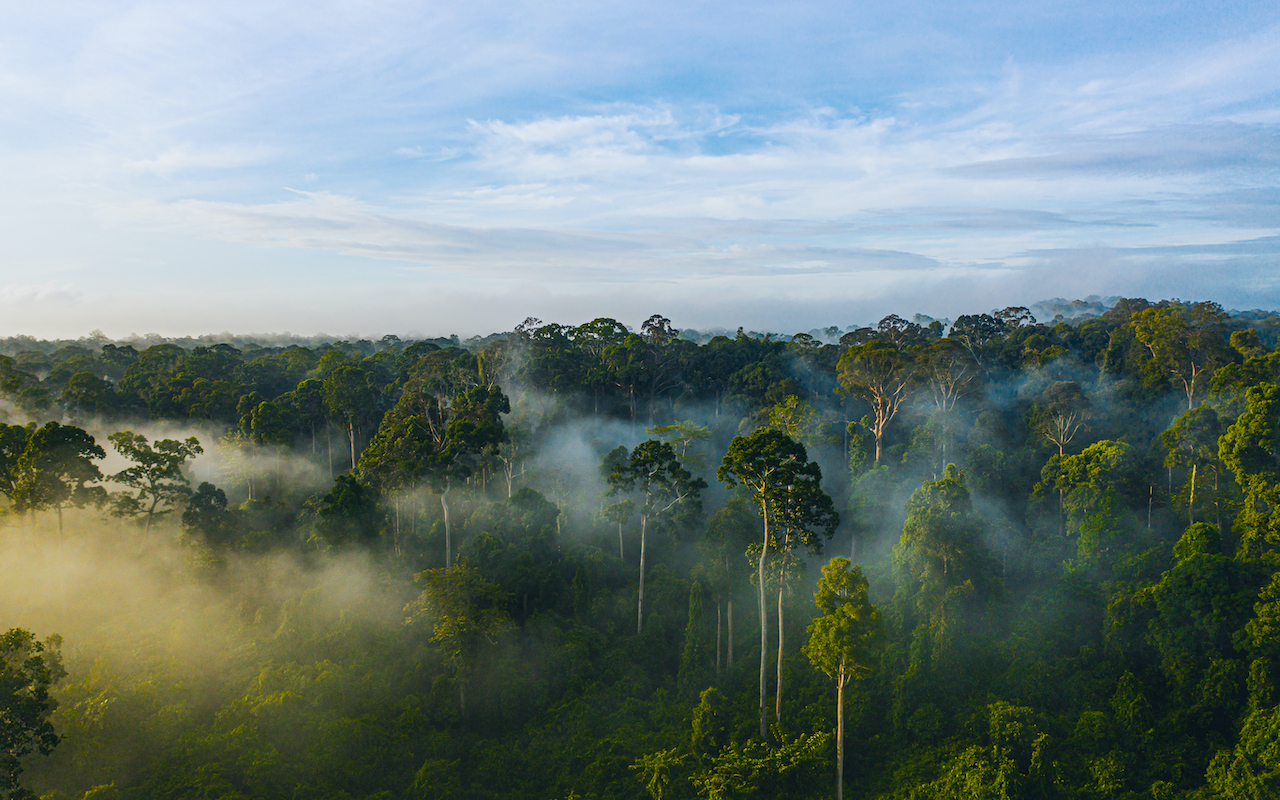
This remote region was only discovered in 1947 when a light aircraft almost crashed into the mist-shrouded rim. The serendipitous encounter didn’t generate much interest at the time, and the area slipped back into cloud-covered obscurity. It was only in 1988, when a full scientific expedition was organised by the state-sanctioned Sabah Foundation and WWF Malaysia, that news of this remote region began to trickle out to the wider world.
Peter Feilberg, executive director of NEPCon, a Danish NGO, has been researching the basin since 1999. The soft-spoken conservationist gets visibly excited when talk turns to the significance of the region. “Even if you go deep inside [the] Amazon, there have been quite a lot of people actually living inside the forest, having small-scale agriculture production, hunting and so on. You don’t see any traces [of human activity] inside Maliau Basin, which makes it really unique on a global scale.”
This huge bowl of pristine forest is surrounded by two buffer zones. Combined, they make up the MBCA. The buffer zones comprise over 1,300km² of forested land, which had previously been worked on by loggers. However, in 1997, the land was designated by the Sabah state government as Class 1 protected forest and in March 2016, it was officially gazetted as national heritage by the Malaysian government.

The road that brings visitors into the conservation area ends at the final buffer, a sprawling area of sparkling ponds, trees in autumnal shades and wildlife in every direction. As dusk begins to settle, a hornbill pair flits from tree to tree to find a spot to nest, while wild boars trot idly by. Soon darkness blankets us, and our flashlights illuminate muscular, dusty-brown sambar deer emerging with their young to graze.
Beyond the buffer zones, the forest-cloaked basin is accessible only by foot. The noise that accompanies us on our trek is immersive and constant, as if welcoming us to a different realm. High up in the canopy is a family of gibbons swinging wildly from tree to tree, with raucous whooping laughter accompanying their every move. The now-familiar sound of wings overhead is interspersed with the hurried patter of animal feet on the forest floor. One of the basin’s many waterfalls roars in the distance.

The scene changes as one forest type ebbs into the next. As we move further, the lowland forest with sparse, soaring trees gives way at higher elevation to the dwarf forest, where carnivorous pitcher plants make their home on the sides of dense, stunted trees. Shartner Liew, our Sabahan nature guide who has the lean physique of an endurance athlete, darts through the forest like a child in a toy shop. He examines every tree carefully, in the hope of finding camouflaged insects, and introduces each tree species to us with great reverence. Each tree has a story to tell. The strangler fig tree that sends its buttress roots sprawling across the forest floor tells a tale of dominance. The centuries-old Agathis tree that grows like a pillar of the Pantheon tells the story of time.
However, when we peer more closely, we see another narrative – one of human interference. At eye-level, carved into the bark of some of the trees, are large markings. Some are indecipherable, like hieroglyphs, while others are letters from the alphabet. One tree has S, A, N, T, A, L, E and T carved vertically into its trunk. These messages are the poachers’ coded way of communicating with one another in the rainforest, making up a modern-day treasure map.
“One of the big threats to Maliau Basin is the roaming gangs of poachers that go around the protected areas looking for a tree species called Aquilaria,” Feilberg says. “On a per-kilo basis, it’s the most expensive thing you can buy in this world. Much more expensive than gold.”

Deep in the rainforest, just off the trail, we come across a pale, lanky tree. Its trunk is bare and dotted on it are a smattering of pea-green moss and irregular white patches. It is an entirely unremarkable tree and we probably wouldn’t have noticed it if not for the dramatic, deep wound inflicted in its trunk, as if by an axe. It dawned on us that we were looking at the Aquilaria tree. One of my fellow trekkers, a young British lawyer, remarks ominously, “This feels like the last frontier of the battle between man and nature.”
The Aquilaria tree has been hunted to near- extinction because of a quirk of natural biochemistry. When the tree is damaged, by insects or humans, it can react to the wound by producing a protective resin. When the resin soaks into the tree’s bark, it produces agarwood or oud, known locally as gaharu, a scented bark that is one of the world’s rarest and most expensive commodities. Through poachers, agarwood is smuggled from Sabah’s Lost World to China, the Middle East, Japan and Europe where it is used for incense, for perfume by top luxury brands, and even as a store of value, like gold.
The months that these poachers spend in the Maliau Basin don’t just cause harm to the Aquilaria trees but also result in considerable damage to the ecosystem. Jadda Suhaimi, the manager of MBCA, tells us that the poachers, known to the locals as gaharu hunters, tend to travel very light and hunt for their food in the rainforest. They are also believed to be helped by people within the local community, who provide them with directions and food supplies. Rahimatsah Amat, chief executive of Sabah Environmental Trust, a local NGO, has been closely involved with enforcement work at Maliau Basin. A renowned Sabahan wildlife ecologist who speaks with the endearing familiarity of a close relative, he explains there has been a shift in recent years in the locals’ relationship with the rainforest.
Before, the locals saw the area as a resource. They would occasionally hunt a wild boar for a festival or catch a fish for dinner. This had minimal impact on the ecosystem as the wildlife regenerated quickly, outpacing the communities’ needs. However, with economic development in recent years, people have started seeing the forest as a commodity. In order to afford modern comforts such as electricity and phones, they turn to poaching.
Rahimatsah believes one way to solve the problem of poaching is to develop tourism in the region. He reasons that developing infrastructure in the buffer zones, in areas where hotspots for illegal entry have been identified, will encourage travellers to visit. “When there are people here on a 24-hour basis, thieves [will] think twice about going,” he says.
Recognising that some may bristle at the idea of a protected area being developed for tourism, he assures us this is actually good news for conservation. As the buffer zones had previously been logged, the work required to develop them for tourism includes landscaping and the planting of trees. This not only makes the surroundings more attractive, it encourages the return of wildlife to the area.

Part of the conservation work also includes the construction of the Maliau Basin Studies Centre, a complex of timber huts built in the buffer zone to facilitate both research and tourism. Indeed, the presence of the huts doesn’t seem to bother the wildlife. Under the cloak of night, the glittering eyes of a civet cat shines out from under the long wooden walkways and the resident sunbear emerges to scour for its evening snack.
The second and more critical approach, Rahimatsah says, is employing local communities to help protect the rainforest, which not only gives them a way to bridge their income gap but also ensures they have a vested interest in preserving the basin. “Conservation isn’t just about scientists doing work on the ground. It’s about communities as a whole working together. If [local communities] have jobs, incidents of illegal poaching and support for the gaharu hunters will diminish.”

Suhaimi says that in recent years, many members of the nearby tribes have been employed at MBCA in a variety of jobs, including forest rangers, housekeepers and drivers. Clearly, the involvement of local communities does not stop there. When we first arrived at the conservation area, we crossed paths with a group of spirited children on a school trip from a local village. Their chattering stopped abruptly as they excitedly point out a trogon perched on a tree overhead, its blood-orange feathers glinting in the dusky rays of evening sun. Perhaps in time, these children, too, will be part of conservation efforts to preserve this extraordinary place.
After three days of trekking, I emerged from the rainforest at midday, filled with an exhilarating sense of possibility. While it was a thrill to visit a place so unexplored and hidden, the paradox of Maliau Basin is that in order to preserve it for future generations, it cannot remain unknown for long.
The information is accurate as of press time. For updated information, please refer to the Ministry of Foreign Affairs’ website .
To learn more about Singapore Airlines flights, visit singaporeair.com .
SEE ALSO: Saving Kota Kinabalu’s underwater refuge
This article was originally published in the June 2018 issue of Silkwinds magazine and updated on 22 June 2021.
Recommended
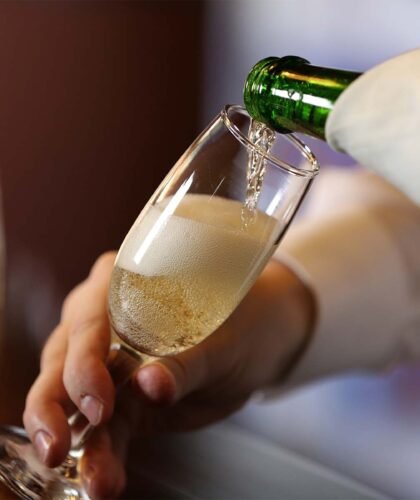
Fantastic bubbly and where to find them in Singapore

9 coastal drives that will inspire you to hit the road
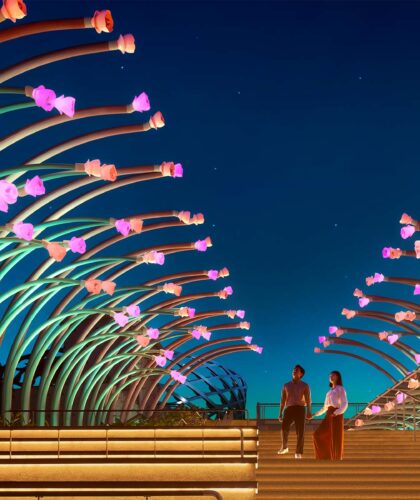
Sightseeing
7 top things to try on Sentosa island
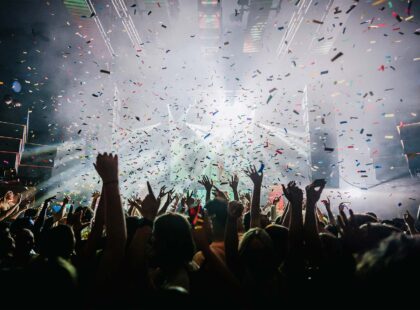
Bars & Clubs
7 places to party in Perth when night falls
- Advertise With Us
- Singapore Airlines
- SingaporeAir Mobile App
- Privacy Policy
- Conditions of Access
- New York City
- Inspiration
- Journey with SIA
- Explore Our Cabins
- Get Insider Insights
- Discover Our Partners
- Footprints Across Asia
- New Zealand
- Philippines
- Turkmenistan
- Contact Us!

Singapore couple travel blog on exploring the less beaten paths of the world

4D3N Maliau Basin Jungle Trek in Sabah
sunriseOdyssey / Malaysia , travelogue / amazing borneo , malaysia , maliau basin , maliau falls , sabah , trek / 0 Comments
For all of you nature/jungle trek fans, you will love it here at Maliau Basin in Sabah! We did a total of 4 days jungle trek and enjoyed ourselves thoroughly! Thankfully, no leeches as it was the dry season. Beware though, Maliau Basin is famous for their leeches especially during the wet season! 4 days of just being out there in nature, what a great way to heal our soul.
“I go to nature to be soothed and healed, and to have my senses put in order.” – John Burroughs
Day 1: Kota Kinabalu – Maliau Basin Studies Centre
We spent the most of day 1 in a car driving actually, about 5-6 hours in total. Cos it’s a long long way from the city to Maliau Basin! There’s a reason why this place is also known as the “lost world of Sabah”. But at least the ride was very comfortable and we were pretty much used to long car rides after our Footprints Across Asia journey 🙂
Our first stop was at Keningau Town where we had our breakfast. We then continued on our journey to the Shell Maliau Reception where we had our lunch and briefing about the Maliau Basin.
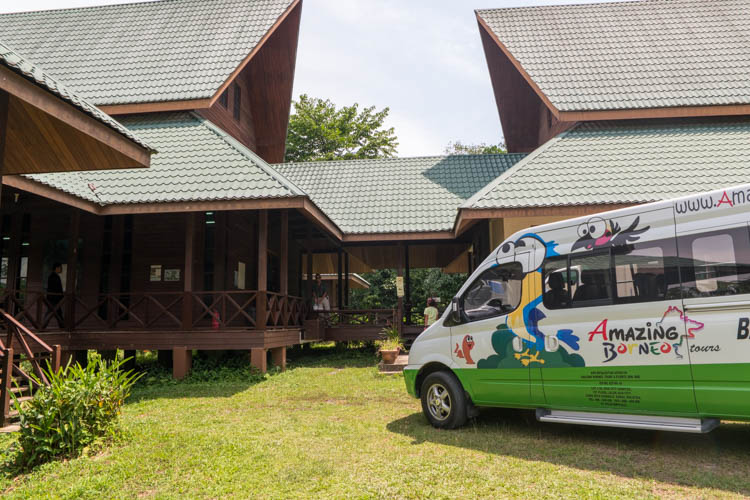
We really like the funky design on the Amazing Borneo van! Very eye catching!
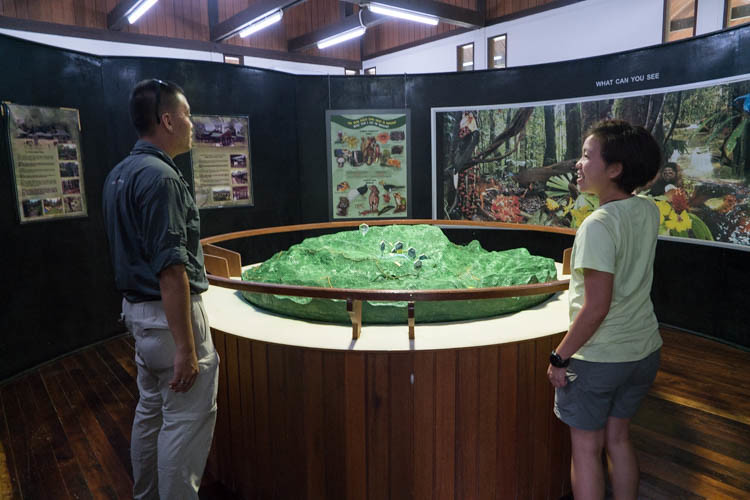
Short briefing about Maliau Basin by our guide, Ryan, at the Shell Maliau Reception.
Here was also where we changed from our van to a 4 wheel drive as the route to the Maliau Basin Studies Camp (MBSC) was really bumpy and uneven!

En route to Maliau Basin Camp! Deep into the forest, here we go!
Upon reaching MBSC where we will be staying for our first night, we were immediately greeted by wildlife! We were at the lobby of the MBSC when suddenly we heard a loud flapping noise and a big bang! Poor thing, apparently this hornbill lost its way and flew right smack into the door of the souvenir shop! Must have been such a fright for this bird.
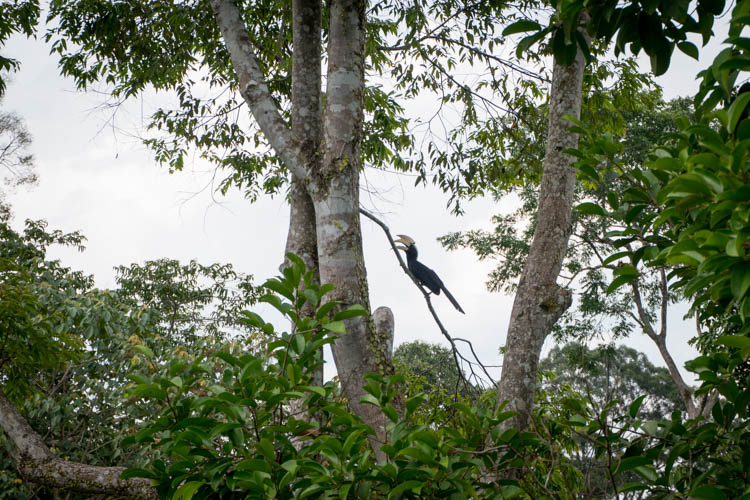
The poor hornbill that flew right smack into a door at the lobby!
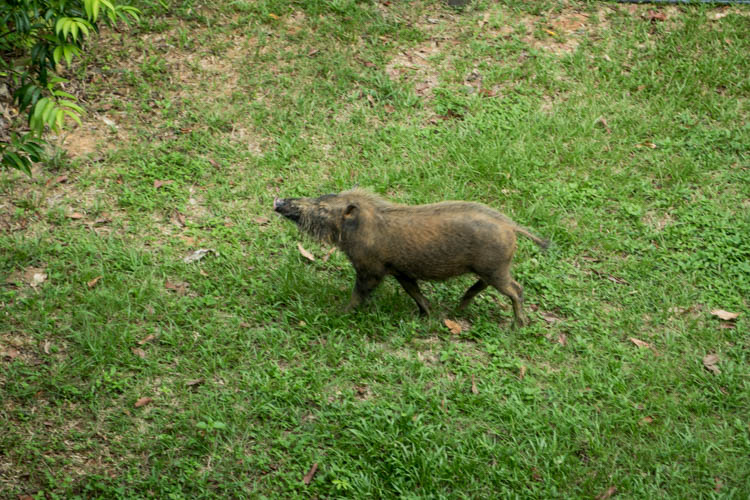
And look what we spotted right below the hut where we’ll be staying at!
Tip: If you ever encounter any raging wild boar, run as fast as you can in a zig-zag line! Apparently they can’t turn their necks and can only run straight. heh.
Here’s our cozy room for the night, not too bad at all. Definitely exceeded our expectations. There’s even hot water here! But of course, no wifi.
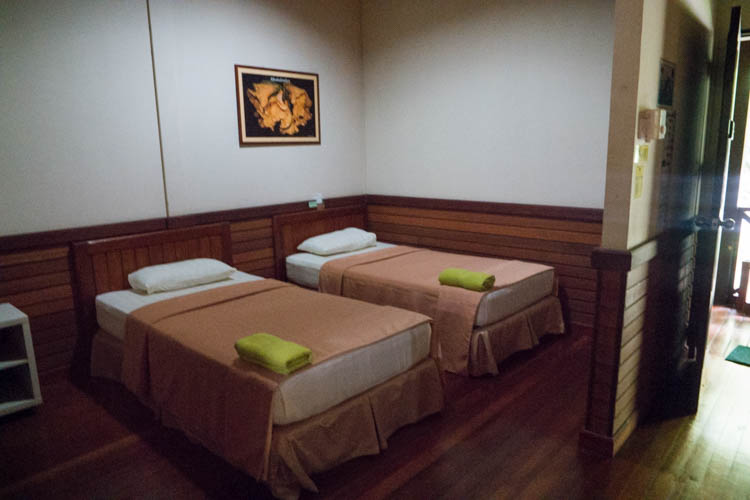
We were supposed to go for the Sky Bridge (treetop canopy walk) but it was closed for maintenance. So we decided to chill and took a short walk to admire the view of the beautiful Maliau river instead. You can’t really see from the photo, but the water was actually reddish brown in colour! As our guide put it, it looked like “teh-o” (tea without milk). It’s not dirty actually, the colour’s due to the minerals from the decomposing plants that seeped into the river.
Oh and while we were admiring the river, we spotted a baby wild boar and its mother crossing the river! It was too far to take a photo of them though.
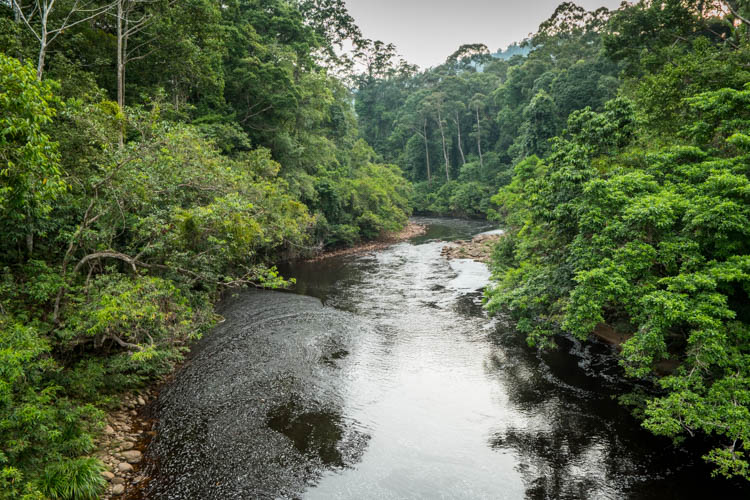
Amazingly, the whole of Maliau Basin only has 1 river to drain out all of its water reserve!
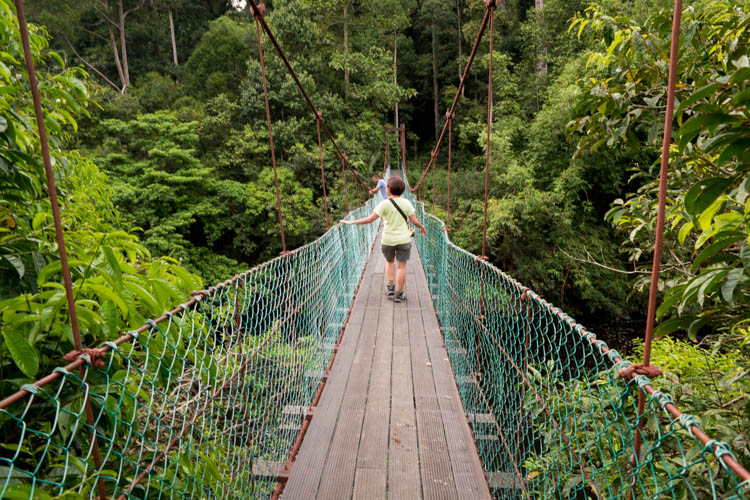
The shorter bridge that was supposed to led us to the Sky Bridge.
Sumptuous dinner! We really weren’t expecting anything like that, but wow, the chefs at MBSC were really awesome! Oh and while we were enjoying our dinner, there was a fruit bat flying around the dining hall right above our heads in circles. Part and parcel of nature I guess.
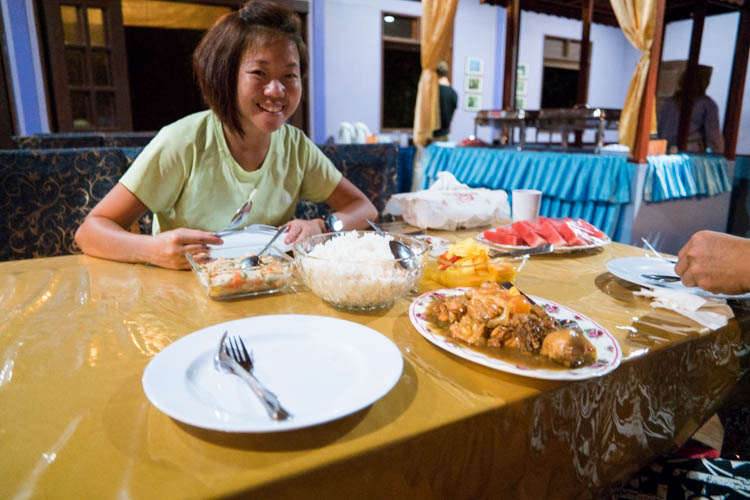
We were surprised that the MBSC had a auditorium within their premises! Not bad at all, fully equipped with a projector and air conditioning. We had to watch a 15 minutes video about the Maliau Basin, it felt like the video was done many many years ago though, time for an updated version!
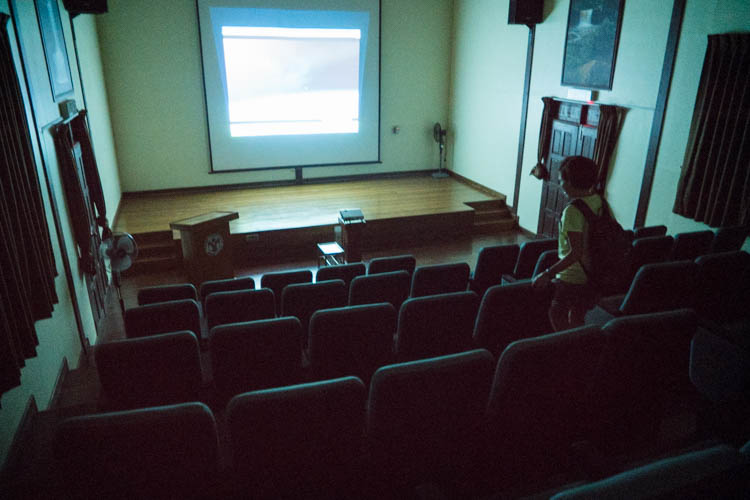
Video screening at the auditorium of Maliau Basin Studies Camp
Woohoo, highlight of day 1! The night drive into the forest to spot some nocturnal wildlife! Exciting!
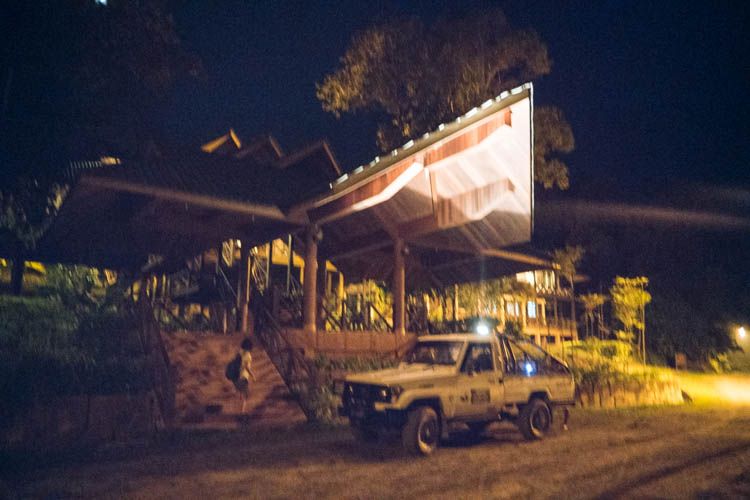
Night drive to spot some wildlife!
And look what we spotted! A very cute Buffy fish owl! We also spotted quite a few flying squirrels, civets, Samba deers. But it was too dark and they were moving too fast for us to capture a clear shot of them. The owl was the only one that stood so still for our photo 🙂
Fun Fact: Do you know that an owl has extremely sharp claws? Our guide shared with us that one of his colleague used his bare hands to rescue an injured owl that was lying on the ground and ended up getting scratched very badly by the owl! It was so deep that you could almost see the bone and he ended up having a very infected wound as the claws were full of germs and had to be admitted to the hospital.
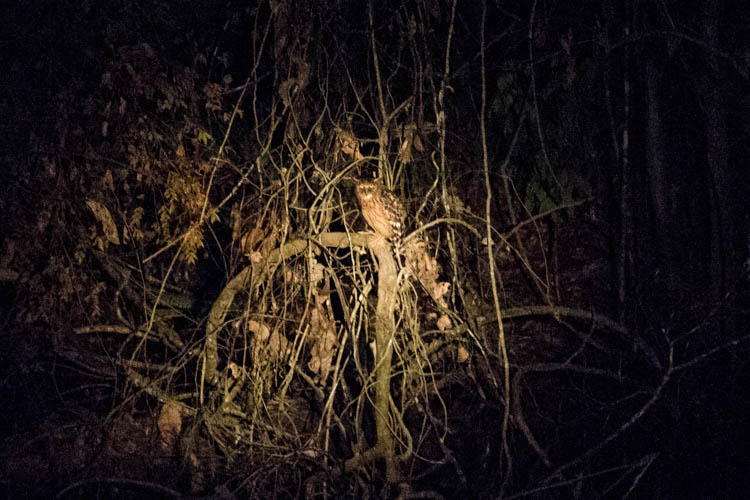
That sums up the end of our first day in Maliau Basin. Kinda a relaxing day to prepare us for the long trek the next day!
Day 2: Maliau Basin Studies Centre – Agathis Camp – Ginseng Camp (9km/6 hours)
From the MBSC to Agathis Camp , we took the 4 wheel drive and because of the vastly improved road conditions, we took only 30 minutes compared to 1.5 hours in the past.
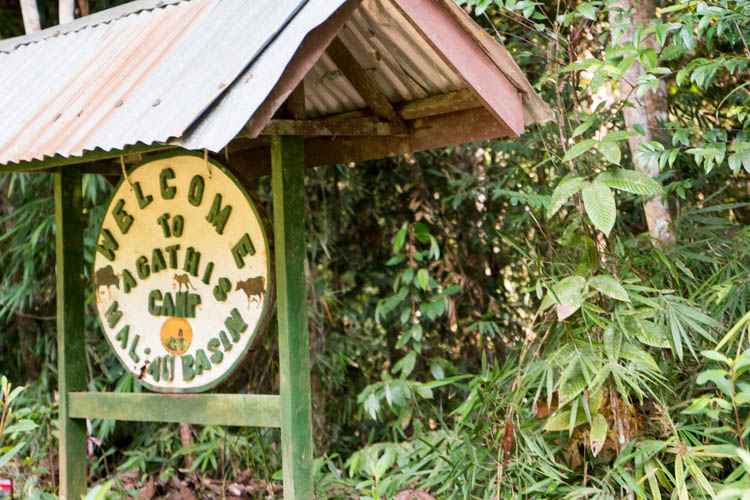
At the start of our trek proper, Agathis Camp.

Sadly, the Agathis Camp is no longer in use as it was destroyed by the elephants about 2 months ago.
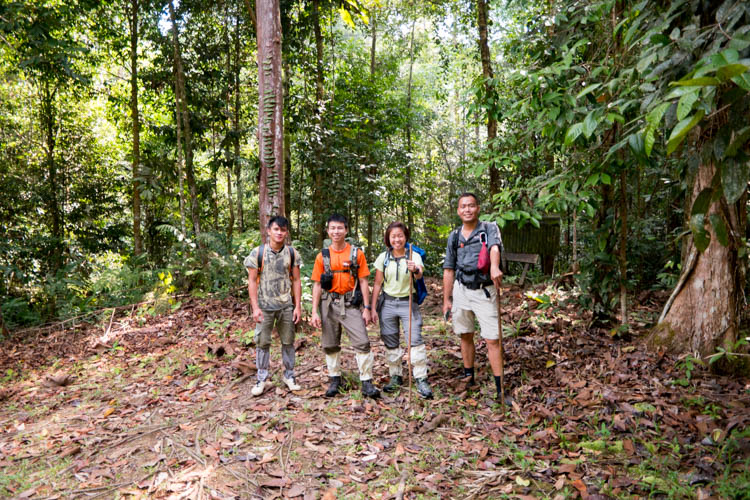
All ready to start our jungle trek!
I know our outfit looks damn cool. Haha but no choice, because we didn’t want to get infested with leeches!
Tip: To avoid leeches, use leech socks! (The white fabric that we’re wearing below our knees) You wear it over your normal socks before wearing your shoes. Also, tuck in your shirts to prevent any sneaky leeches from crawling in!
Apparently Maliau Basin is infamous for their leeches, especially during the wet season! Thankfully we were there during the dry season (Mar to Oct) and it has not been raining for the past few days when we were there. Hence we only spotted maybe less than 10 leeches in total during the entire trek?
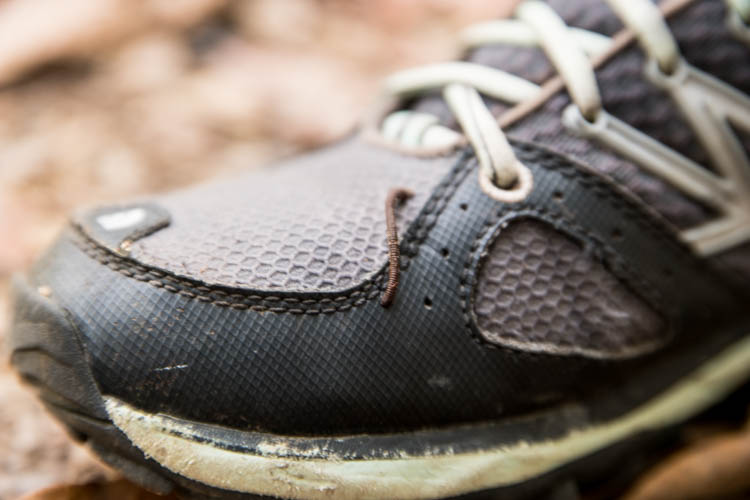
Sneaky sneaky leech, looking for a way to enter my shoe!
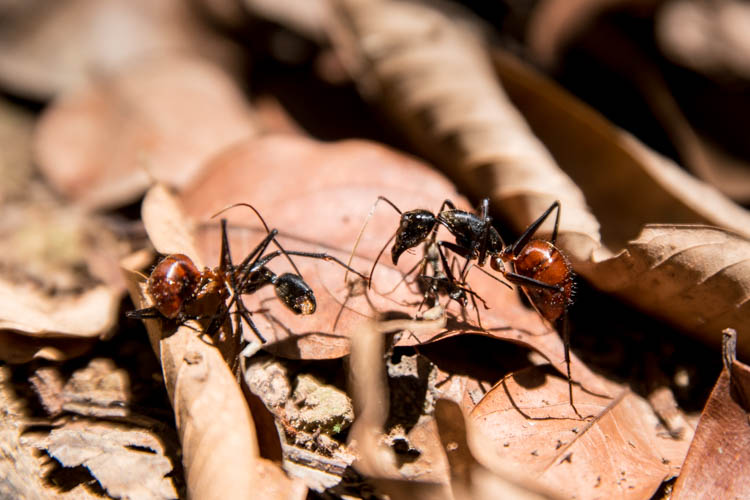
GIANT sized ants everywhere! (Omg, the ants were at least 3cm long!)
We really enjoyed learning about the different types of trees while trekking. The tree in the right photo below was a huge Agathis tree which is very commonly found in the Maliau Basin forest. That’s why one of the camp was named after this tree. There were aplenty of spiraling lianas (left photo below) along the trail too!
We also spotted some gibbons swinging wildly from tree to tree and even caught a glimpse of the huge helmeted hornbill! Ryan taught us how to identify different types of animal/bird calls and it was very fun practising whatever we’ve learnt along the way. It really does feel like Geography coming alive! 🙂
“Let nature be your teacher.” – William Wordsworth
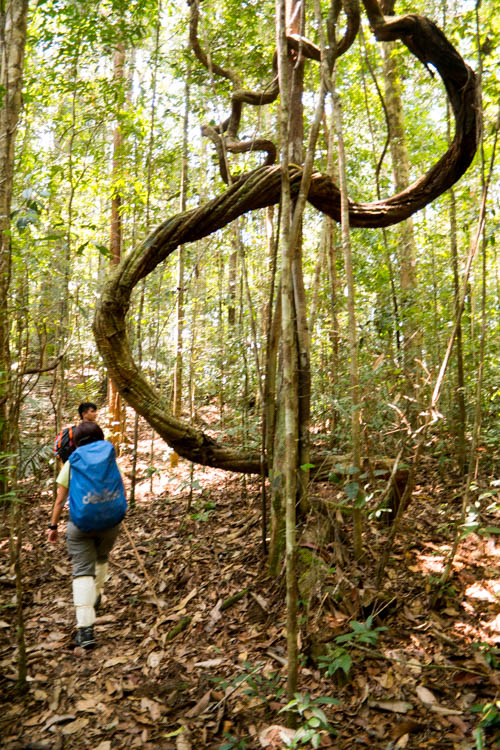
Everyday we will have pre-packed lunch which our porters prepared for us.
Reminder: Leave no trash behind! We brought back our plastic containers and utensils and reused them again for the next day’s lunch.
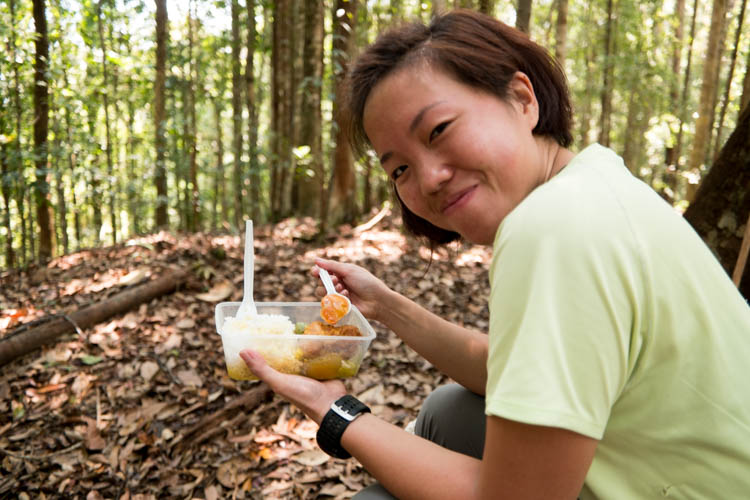
Finally, after around 6 hours of trek, we reached the Ginseng Camp which will be our crib for our second night!
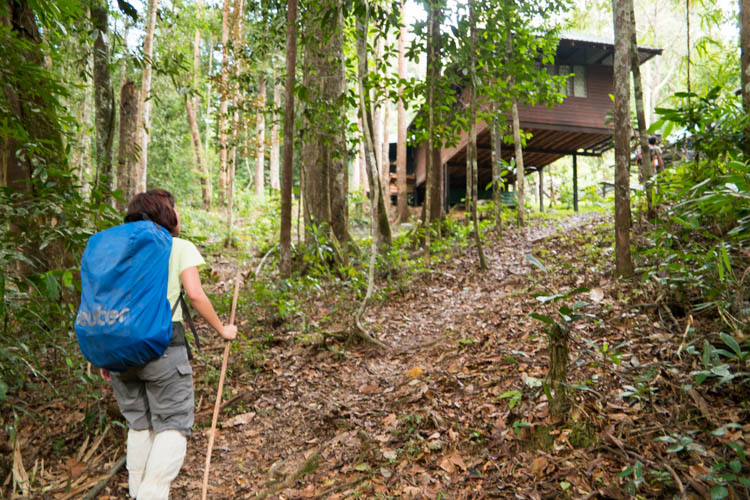
Finally reached Ginseng Camp!
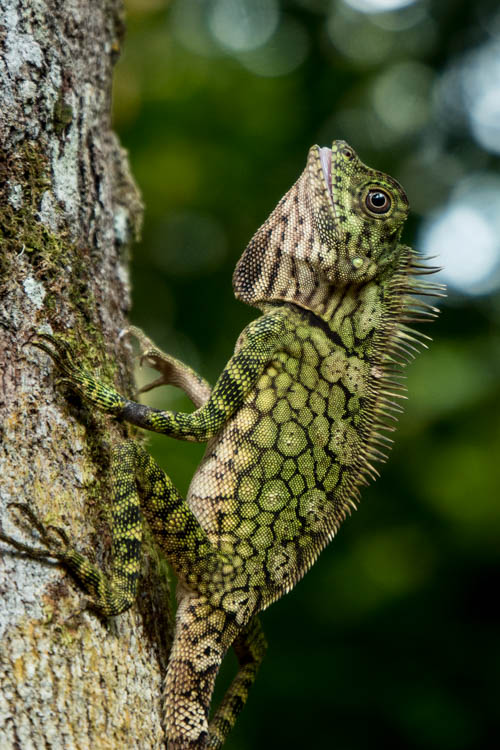
Spotted a Bornean angle-head lizard climbing up a tree near the Ginseng Camp!
We did a short 20 minutes trek to the nearby Ginseng Falls but sadly, due to the recent dry spell, the falls has been reduced to a tiny fall.
Tip: Be careful on your way down to the Ginseng Falls! Lots of slippery rocks with moss on it.
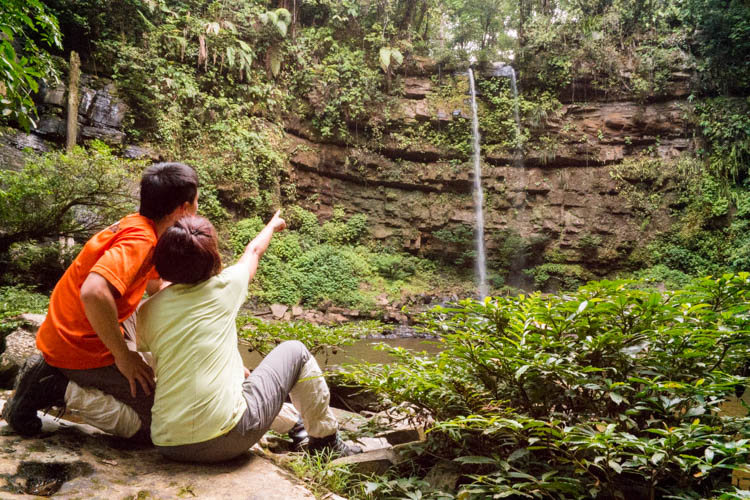
Ginseng Falls of Maliau Basin in Sabah
Again, never have we enjoyed such a feast in the middle of a forest before. 4 different dishes complete with a fruits dish! Very very delicious! Shiok!
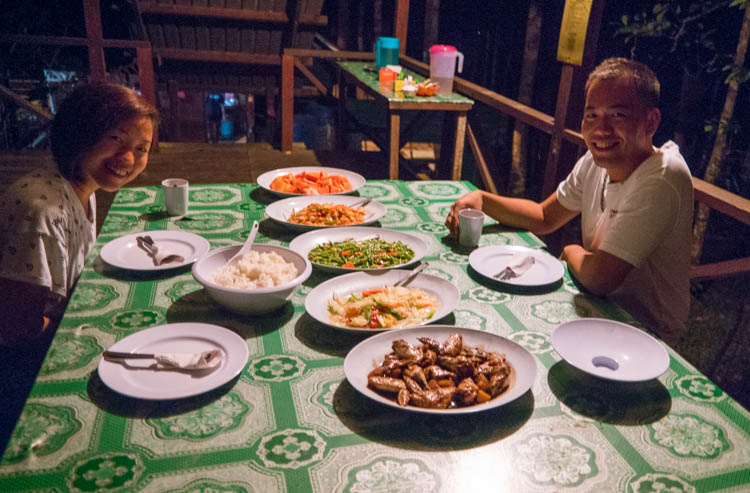
Day 3 & 4: Ginseng Camp – Maliau Falls – Ginseng Camp – Agathis Camp (19km/9.5 hours)
According to Ryan, the third day was the most challenging out of our entire 4 days Maliau Basin trek. The first 500m ascend was really steep, but subsequently it was quite flat. The toughest parts were at the start and the last 2km when trekking down to the falls.
We really enjoyed the wildlife in Maliau Basin. As we were trekking, we heard some branches cracking and falling. We though it was a deadfall, but when we turned around, we realised that it was a bunch of playful Red Leaf Monkeys swinging around the canopy! Too far to capture a clear shot of them though.
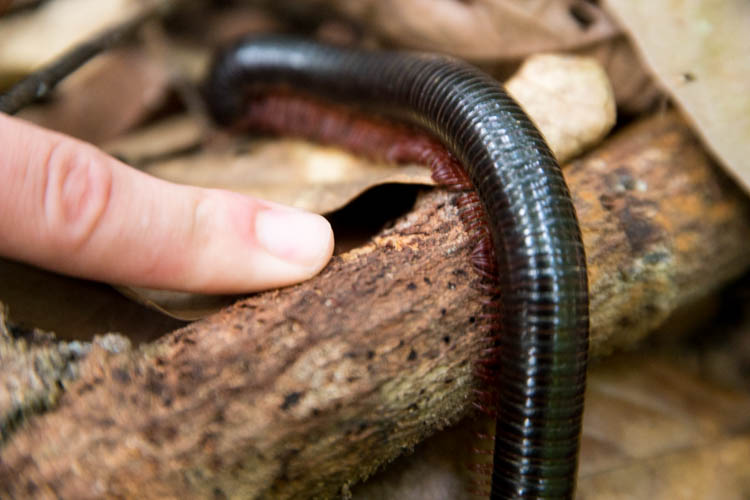
Hello giant millipede! It was super huge and at least 15cm long!
Do you know, the giant millipede above might not be poisonous but it’s able to shoot out a liquid that can blind you?

Fun fact: Any idea how to tell if a wild mushroom is poisonous or edible? Well, if it’s still looking so pretty and untouched, it means it’s most likely to be poisonous since none of the forest animals/insects have eaten it!
Some parts of the trek were slightly more challenging as you have to climb up/down via the wooden ladder. But definitely nothing compared to the crazy terrain at Mt Trusmadi !
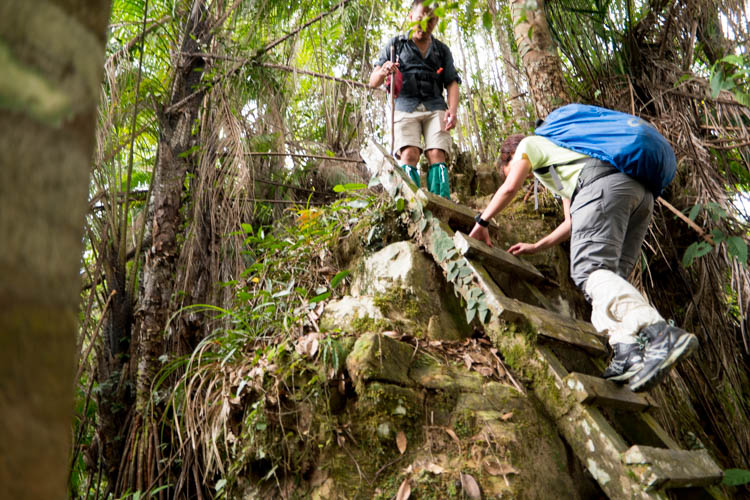
Ryan spotted a small Rat Snake and was trying to point it out to us!
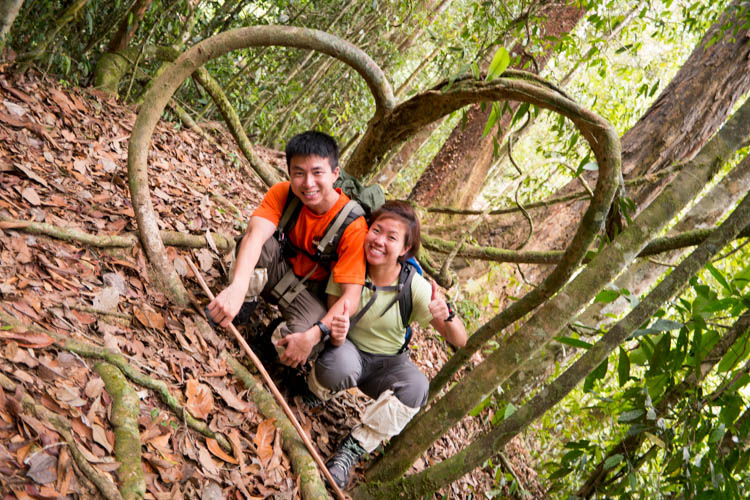
Tip: During the last 2km of descend to the Maliau Falls, be very careful as it’s really slippery! We were there during dry weather and it was still very slippery, can’t imagine how it’d be like during the wet season!
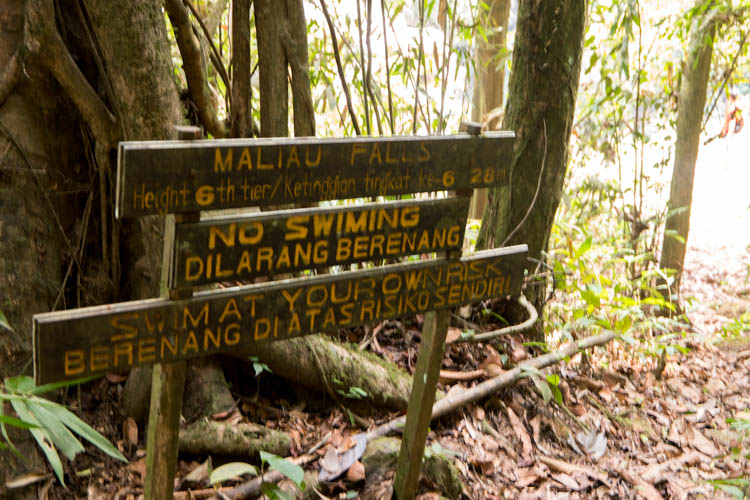
And here it is, the majestic 7 tiered Maliau Falls ! You have to be there to experience it for yourself. It’s even more beautiful during the wet season when the falls is much larger than this! Imagine finding this amazing falls hidden deep inside a forest!.
“Nature itself is the best physician.” – Hippocrates

So that sums up our 4 days trek in the Maliau Basin! We enjoyed ourselves thoroughly and this nature break was definitely much needed for our souls. 4 days of just us and nature, no distractions from the world outside.
Essential Information
How to book this tour We booked our 4D3N Maliau Trek with Amazing Borneo . Note that the standard package is usually 5D4N but due to time constraint, we did the 4D3N trek instead. Usually we prefer travelling independently but for certain activities, you will definitely need to book a tour. For the Maliau Basin trek, it’s not very accessible and just to get to the starting point, you need at least 4-6 hours of drive. Even if you decide to rent your own vehicle, it’s going to be quite costly. For us, we had a fuss free experience with Amazing Borneo because they settled everything from the transport, hiring of porters (to carry our food/water, to cook for us), guide, permits, accommodation, food and logistics.
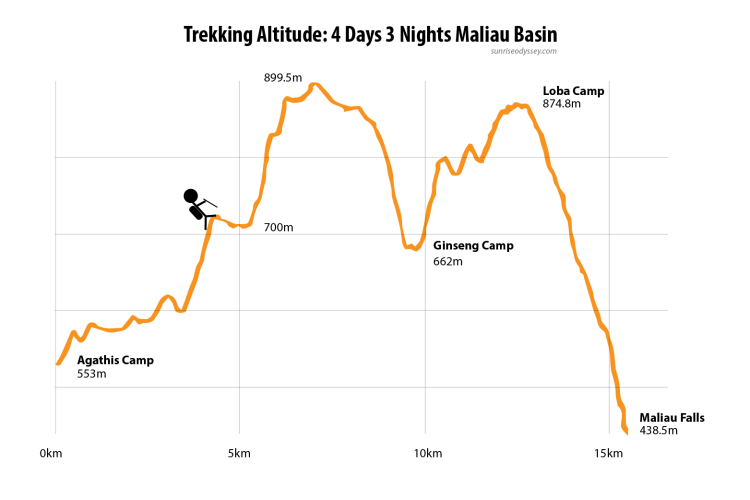
Here are some stats from our hike!
When was the last time that you fully immerse yourself in nature? Share with us your experience in the comments below! 🙂
Also don't forget to follow us on instagram and facebook for our latest updates.
A photo posted by Sunrise Odyssey (@sunriseodyssey) on Oct 16, 2014 at 5:36pm PDT
A photo posted by Sunrise Odyssey (@sunriseodyssey) on Mar 6, 2015 at 1:16am PST
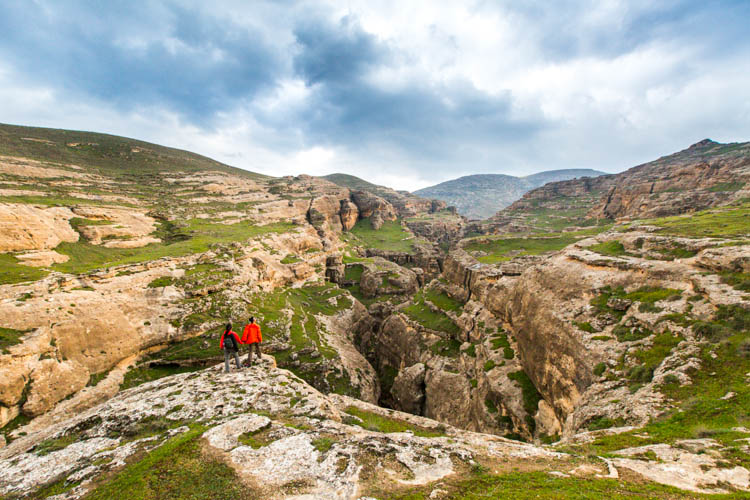
Why travelling budget is not for everyone
How we survived on a $30/day budget when travelling overland from China across Asia to Europe!
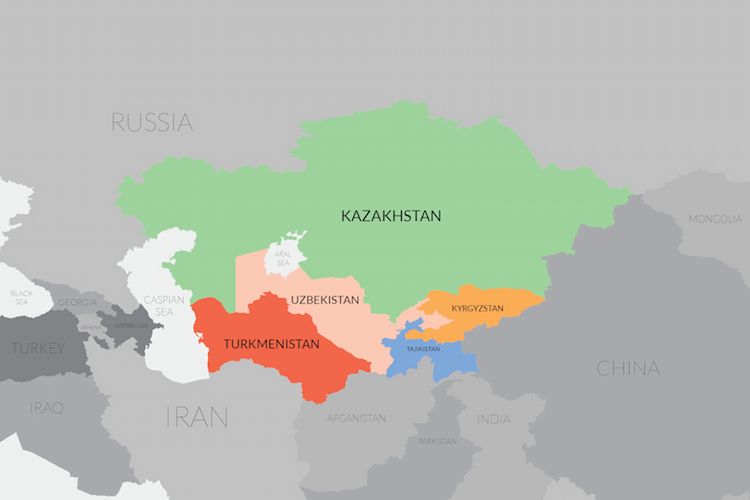
Sunrise Odyssey’s Guide to Travelling Central Asia
The grand question of it all when it comes to Central Asia, where in the world is it? The next grand question of all is, is there even anything to do there? Well, we were asking ourselves the same question, because honestly before we embarked on this trip, we have also never heard of these(…)
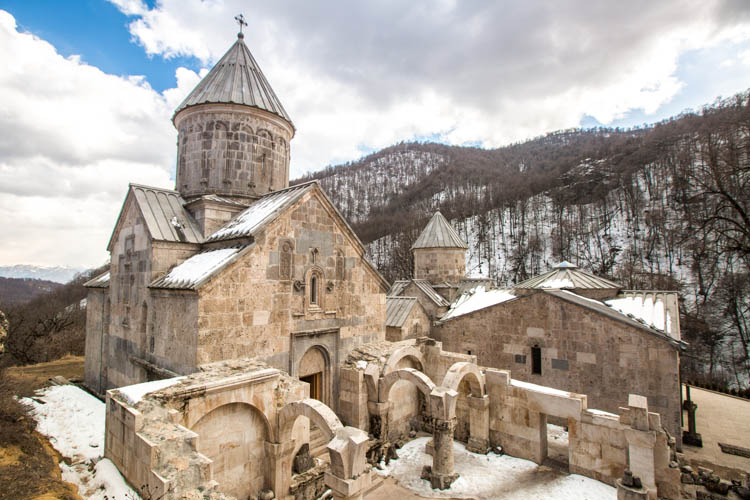
10 Most Beautiful Churches in Armenia That You Must Visit
If you’re deciding which churches to visit in Armenia, here’s our take on the 10 most beautiful churches in Armenia that you must visit.

Look up in Iran – Fascinating Ceiling Designs That You Don’t Want To Miss [Photos]
Absolutely gorgeous ceilings that we witnessed when travelling Iran. Next time when you travel Iran, don’t forget to look up!
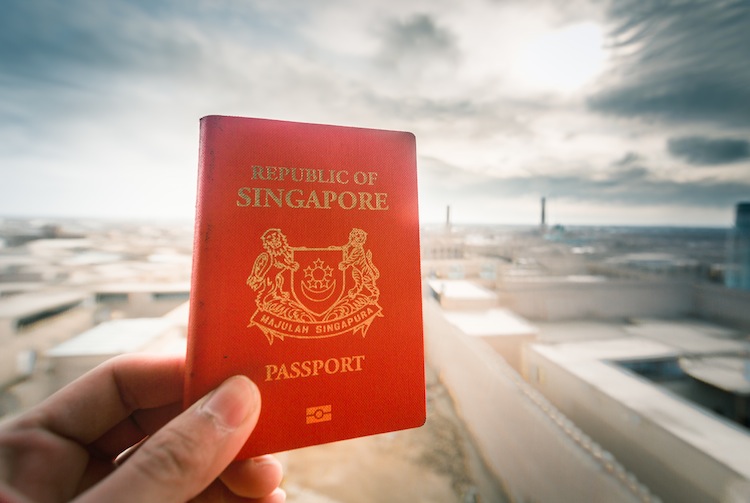
7 reasons why it’s so awesome to travel as a Singaporean
We’re blessed to be able to call beautiful and safe country our home. Here are our 7 reasons why it’s so awesome to travel as a Singaporean!
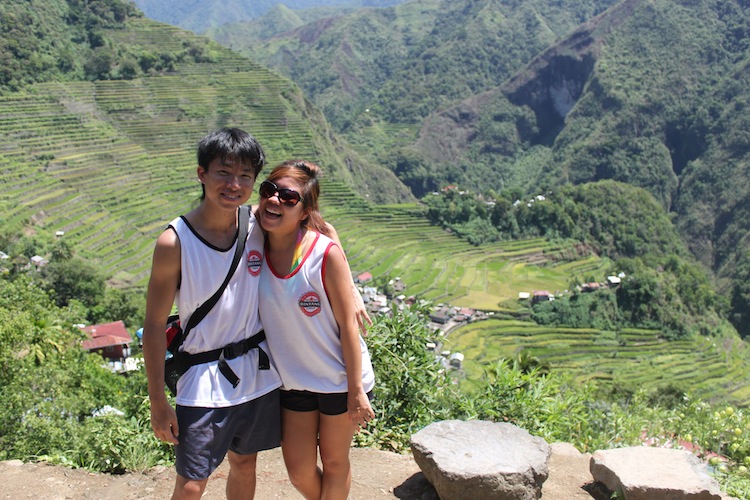
10 reasons why you should travel with your partner :)
Traveling is really one of the most amazing things that we’ve ever done together. The memories created will last a lifetime and these are moments that we will treasure forever.

5 Amazing Things To Do In Philippines
Thinking of travelling to Philippines? Check out our top 5 things to do in Philippines!

Our Experience on Climbing Mount Kinabalu
Here’s our honest experience on climbing Mt Kinabalu, what you can expect as well as some useful tips from us!

Climbing Mount Kinabalu Via Ferrata!
Here’s our experience on climbing Mount Kinabalu via the ferrata route, some useful tips as well as what you should bring for your ferrata activity!
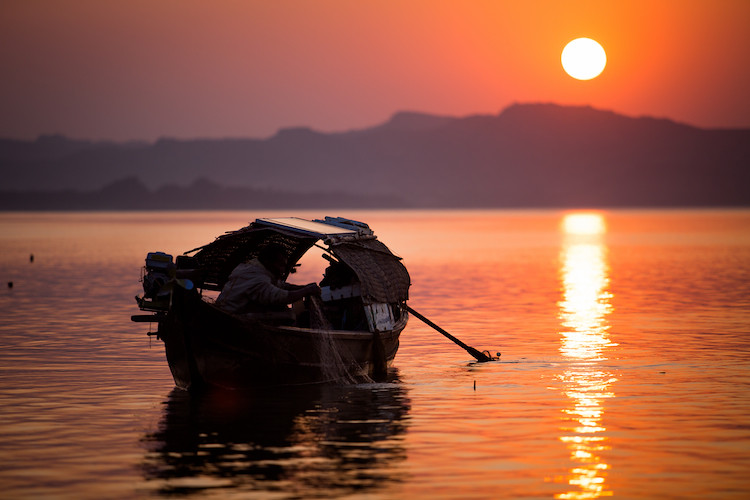
Detailed Overview of our 16 Days Backpacking Myanmar!
Overview of our route, transport mode and budget for our 16 days of travel in Myanmar!
Read previous post:
[Product Review] Samsung Galaxy A8 as the Ideal Phone For Travelling
Do you have a favourite phone for travelling? Here's what we feel about the Samsung Galaxy A8 as an ideal...
Maliau Basin, Sabah, Malaysia

In the East Malaysian state of Sabah, on the great island of Borneo, lies one of Malaysia's finest remaining wilderness areas, the mystical Maliau Basin. Bounded by a formidable escarpment reaching over 1,675m asl, the almost circular Basin encompasses reaching over 390 km 2 of pristine forest, a virtually self-contained ecosystem.
Things To Do
In addition to being an ideal place for research and environmental education, Maliau Basin Conservation Area is perfect for adventure jungle trekking, bird watching, nature photography, night drives to spot nocturnal wildlife, waterfall swimming and recreation and simply experiencing the thrill of being in a truly unspoilt wilderness.
Camps & Accomodation
Besides the chalet, resthouse and hostel accommodation facilities at Maliau Basin Studies Centre, Maliau offers a range of satellite camps linked by well-maintained trails. Belian Camp Belian Camp is about 25km drive from the Security Gate and within walking distance of Maliau Basin Studies Centre.
Pick up from your hotel in Sandakan, drive approximately forty mins to Sepilok Orang Utan Rehabilitation Centre. After registration, follow a guided boardwalk that will lead you
The City Tour includes a visit to Sandakan Memorial Park, which is adjacent to the site of the original Sandakan Prisoner of War (POW) Camp.
Rainforest Discovery Centre is situated within the famous Kabili-Sepilok Forest Reserve. The Exhibition Centre and the Plant Discovery Centre will bring you
The Labuk Bay Proboscis Monkey Sanctuary offers another perfect proboscis monkeys observation spot for any tourist who wants to have a closer look
Take a speedboat from Sandakan for about 15 minutes and reach Tanjung Aru Island. There, we are able to see stilt houses while we cruise along river.
Sepilok Orang Utan/Sandakan Nature City Tour. Pick up from your hotel in Sandakan, drive to Sepilok Orang Utan Rehabilitation Centre. 1000hrs,
Pick up from your hotel in Sandakan, drive to Sepilok Orang Utan Rehabilitation Centre. 1000hrs, witness the morning feeding of orang utans in the forest,
Pick up from your hotel in Sandakan, drive approximately forty minutes to Raiforest Discovery Centre, situated within the famous Kabili-Sepilok Forest Reserve.
Pick up from hotel in Sandakan, transfer to SJR for lunch. After lunch, drive overland to Bilit, Kinabatangan River, home to the 10 species of primates namely Proboscis monkeys,
Pick up from hotel in Sandakan, drive overland (2 ½ hrs) to reach Gomantong Cave to explore the largest limestone and bird nests cave in Sabah
Pick up from hotel and transfer to CQ Jetty for Selingan Turtle Island. This journey by motorised boat will take about 1 hour. After lunch, grab your mask,
Pick up from hotel and transfer to Jetty for Selingan Turtle Island. This journey by motorised boat will take about 1 hour. After lunch, grab your mask,
Pick up from hotel and drive overland (2½ hrs) to reach Gomantong Cave to explore the largest limestone and bird nests cave in Sabah
Meet on upon arrival at SDK airport or pick up at respective hotels as listed on above. Transfer to Sepilok Orang Utan Rehabilitation Centre,
2-day tour to Danum Valley Field Centre, starting from Lahad Datu. Places on itinerary includes Infapro Project Area and Bukit Atur. Pick-up at Lahad Datu Airport
3-day tour to Danum Valley Field Centre, starting from Lahad Datu. Places on itinerary includes Infapro Project Area, Tembaling Waterfall and Bukit Atur.
4-day tour to Danum Valley Borneo Rainforest Lodge (BRL), starting from Lahad Datu. Places on itinerary includes Coffin Cliff, Fairy Falls, Serpent Falls and Danum River.
Sandakan/Sepilok Orang Utan Rehabilitation Centre/Sepilok Jungle Resort. Meet on upon arrival at SDK airport or pick up at respective hotels as listed on above.
Sandakan/Sepilok Orang Utan/Rainforest Discovery Centre/Sepilok Jungle Resort. Meet on upon arrival at SDK airport or pick up at respective hotels as listed on above.
Meet on upon arrival at SDK airport or pick up at respective hotels as listed on above. Transfer to Sepilok Jungle Resort (SJR). Unpack yourself, freshen up. Take a 5 mins.
Meet on upon arrival at SDK airport or pick up at respective hotels as listed on above. Transfer to Sepilok Jungle Resort (SJR). Unpack yourself, freshen up.
Meet on upon arrival at SDK airport or pick up at respective hotels as listed on above. Transfer to Sepilok Jungle Resort (SJR). Then, take a 5 mins.
3 Days, 2 Nights
3-day tour to Maliau Basin Conservation Area, starting from Kota Kinabalu. Places on itenary includes MBSC, Agathis Camp, Nephentes Camp.
5 Days, 4 Nights
5-day tour to Maliau Basin Conservation Area, starting from Kota Kinabalu. Places on itenary includes MBSC, Agathis Camp, Nephentes Camp, Maliau Waterfall, Ginseng Camp.

Maliau Basin Conservation Area
Maliau Basin conversation Area is one of Malaysia's finest remaining wilderness areas. Bounded by formidable escarpment reaching over 1,675 metres above sea level, the almost circular Basin encompasses 390 km of pristine forest, a virtually self-contained ecosystem, never permanently inhabited and with large areas still remaining to be explored and document. Remarkably, the whole Basin is a single huge water catchment, drained by one river only, the Maliau river, which flows out through a gorge in the southeast of the Basin, joining the kuamut River, and eventually the kinabatangan River, Sabah's longest and most important waterway.
Given that the area is in the wet tropics, and its special geology that is extremely conducive for selective weathering, crucial for waterfall have been discovered throughout the Basin, one of which is the magnificent 7-tier Maliau Falls. Located in the northern part of Maliau Basin is lake Linumunsut, through to be Sabah's only non ox-bow freshwater lake. Here, one can find fossilized marine gastropods from 16-17 million years ago when the lake area was once a coastal zone.
In 1981, together with Danum Valley, Maliau Basin was made a conservation Area within the yayasan sabah's long term forest Management Plan, to remain unlogged for conservation, education, research and recreation. While Danum Valley flourished into a world-renowned tropical research centre, Maliau Basin has remained in the shadows as Sabah's Lost World'
In 1997, Sabah state Legislative Assembly designated Maliau Basin Conservation Area as a Class 1 (protection) forest Reserve and extended it to its present size of 588.4 km by incorporating forested land to the esdt and north of the Basin. The management committee, which was gazette pertaining to this is the forest (maliau Basin conservation Area) Rules, 1998. The same Gazette legally established the role of yayasan sabah as the manager of the area.
Yayasan Sabah, sabah Forestry Department and the Ministry of Tourism, Culture and Environment, Universiti Malaysia Sabah Sabah wildlife Department, Sabah parks, sabah Museum, Universiti Kebangsaan Malaysia (UKM), forest Research Institute of Malaysia (FRIM), Universiti Putra Malaysia (UPM), Universiti Malaysia Sarawak (UNIMAS), the state department of environmental protection, the district offices of Tongod, Nabawan and Keningau as well as the Tawau Municipal Council, among others are members of the Management Committee.
The area was further gazetted as a cultural (conservation) Heritage Site on 19 May 1999 under the cultural heritage (conservation) enactment 1998, thereby strengthening its protection status. Buffer zones surrounding the whole conservation area also add to its protection.
Collaboration
In 1999, a 4-year project was initiated between Yayasan Sabah and DANIDA (Danish International Development Assistance), resulting in the preparation of a Strategic anagement Plan for Maliau Basin Conservation Area, and the establishment of Maliau Basin Studies Centre at the southeast edge of the Basin for research, conservation, education and eco-tourism purposes. Generous sponsorship has come from Swedish company IKEA who funded a vehicle, satellite camps, trail and bridge construction, observation towers and the Maliau "Sky Bridge" while Sabah Shell Petroleum Limited sponsored the construction of Shell Maliau Basin Reception and Information Building.
With over 70km of marked trails, only about one third of Maliau is open to visitors and less than half the Basin has been explored by researchers so far. Maliau Basin Conservation Area is a remote location safety procedures must be followed. These include having insurance which covers emergency helicopter evacuation for those trekking into the forest, being accompanied by Maliau rangers while on the trails and rental of VHF radios. Hunting is absolutely forbidden, and rules concerning the conservation of the area such as no collection of specimens without written permission, must also be strictly adhered to.
Waterfalls & Lakes
Maliau Basin contains many outstanding natural features, including probably the greatest number of waterfalls anywhere in Malaysia. The most famed of these is the spectacular 7-tiered Maliau Falls on the Maliau River, the highest fall of which is a magnificent 28m.Maliau is also the home of the fabled Lake Linumunsut, Sabah's only non-oxbow lake, situated below the outer banks of the northern escarpment.
Maliau Basin contains an unusual assemblage of forest types, comprising mainly of lower montane forest dominated by majestic Agathis tress, rare montane heath forest and lowland and hill dipterocarp forest. These lowland forests are rich in dipterocarps, legumes (kooonpassia, parkia), and fruit tress (wild species of rambutan, terap, starfruit, mangosteen, durian, belunu and bambangan (one species, mangifera bullata, is a first record for Borneo), and as a consequence the wildlife is both rich and diverse. Aquilaria malaccensis, the source of the sweet-smelling 'gaharu' or aloewood that has been used as incense since anciet times, is also recorded from the Basin. Inside the Basin itself along the alluvial flats and lower slopes of the central valleys, about 11% is covered in lowland dipterocarp forest, which grades gradually into hill dipterocarp forest on the slopes and ridges. The giant parasitic flower, Rafflesia tengku-adlinii, was found in this forest in 1998, only the second record for this species.
Maliau Basin conservation Area, including the buffer zones, has an impressive mammal list. More than 80 mammals out of Borneo's total of 221 have so far been recorded from the entire area, including the first sabah record for the Least Horseshoe Bat, and possibly of the Black-eared Pygmy Squirrel, as well as a sighting of the almost extint golden-red Bay Cat, which is restricted to the island of Borneo. Clouded Leopard, as well as the Bornean Pygmy Elephant and Borneo's willd ox,the Banteng.
The most abundant large mammal in the conservation Area (outside the Basin itself) is probably the sambar dear, of which five to ten are nearly always spotted along the access road during night drives. An important finding of mammal surveys in maliau was a significant population of small wild cats. These are the rare Flat-headed and Marbled Cats,and the commoner Leopard Cat. The much larger Clouded Leopard appears to be present both inside and outside the Basin. These have also been records of the almost legendary golden-red Bay Cat. The sun Bear has been recorded both inside and outside the Basin. The Borneon Gibbon, whose distinctive calls resound through the forest canopy at dawn, and the Red Leaf Monkey, is commonest primate both inside and outside the Basin.
Satellite Camp Accommodation
Besides the chalet, resthouse and hostel accommodation facilities at Maliau Basin Studies Centre, Maliau offers a range of satellite camps linked by well-maintained trails. Belian Camp Belian Camp is about 25km drive from the Security Gate and within walking distance of Maliau Basin Studies Centre. It comprises a camping ground with space for 20 double tents, a large kitchen, toilets cum showers, and an attractive pavilion. Located in logged lowland dipterocarp forest near the banks of Maliau River, Belian Camp is close to an educational nature trail and an impressive canopy walkway, also known as Maliau "Sky Bridge".
Nephenthes Camp (Also known as Camel Trophy Camp)
Nephenthes Camp / Camel Trophy Camp is a two-storey building complete with bunk beds, showers and solar electricity, which can accommodate up to 15 visitors. Constructed by the participants of Camel Trophy in 1993, it was the first permanent camp within the Basin and is located strategically at the meeting point of lower montane forest and the rare and unusual montane heath forest on Maliau's southern plateau. A 33m high observation platform near the top of a large Agathis borneensis tree provides an opportunity to observe birds at close range and allows breathtaking views of the surrounding forest canopy and the beautiful Takob Akob and Giluk Falls are within 2 hours walk.
Ginseng Camp
Constructed in 2005 near to the impressive 27m high Ginseng Falls and about 5-6 hours walk from Agathis Camp, this substantial camp can accommodate up to 20 visitors, and has hammock-style beds and toilets cum showers.
Located near the top of a hill with a 230 degrees panoramic view of the Basin's rim, Lobah Camp is approximately 2km from the well-known Maliau Falls, and serves as a much-needed stopping point for visitors from Ginseng and Camel Trophy Camps, before arriving at the Falls.
Seraya Camp
Four to six hours walk from Belian Camp, Seraya Camp is located on what is expected to be the most important trail in MBCA in the future, as most visitors to Maliau Falls will spend the night here. Trails around Seraya Camp also pass a rare Rafflesia tengku-adinii site. Other satellite camps in remote locations such as Rafflesia, Strike Ridge and Eucalyptus Camps are accessible to visitors only by helicopter.
VVIP Chalet
3 days 2 nights maliau basin, 5 days 4 nights maliau basin, half day sepilok orang utan rehabilitation centre tour, (approximately 3 – 3.5 hours).
Pick up from your hotel in Sandakan, drive approximately forty mins to Sepilok Orang Utan Rehabilitation Centre. After registration, follow a guided boardwalk that will lead you to the Feeding Platform, a chance for you to explore the lowland rainforest trees. Witness the feeding of orang utans, watch the scheduled video programme about the Orang Utan (25mins) at the Nature Education Centre, pay a visit to the Exhibition Hall. Depart Sepilok Centre for Sandakan and transfer back to respective hotels.
Raincoat (wet season Nov-Feb), cap/hat, insect repellent, sun cream, good walking shoes, socks, comfortable cotton T-shirt with long or short pant, binocular, camera and personal medications.
Half day Sandakan Nature City Tour
Highlights: Sandakan Memorial Park, Puu Jih Shih Buddhist Temple, St. Michael’s Church, Central Market, Agnes Keith Museum & English Tea House.
The City Tour includes a visit to Sandakan Memorial Park, which is adjacent to the site of the original Sandakan Prisoner of War (POW) Camp. The park commemorates the sacrifice and suffering endured by both Australian and British soldiers who were held by the Japanese as Prisoners of War between 1942 and 1945. The Puu Jih Shih Buddhist Temple, located on a steep hill top where you can have a magnificent view overlooking Sandakan Bay and the Town Centre. Then, continue to one of the oldest church in Sabah, St. Michael’s Church where you can see a century old building where Christianity is preached. Drive to the Central Market where you can see the local produce and fresh seafood being sold. Visit to the Agnes Keith Museum to learn about the life in the colonial days on Agnes & Harry Keith. Harry was the first conservator of the Forestry Department in Sabah and Agnes was the author of the three famous books called Land Below The Wind, Three Came Home and White Man Returns. Stop at the nearby English Tea House where you may have another spectacular view of Sandakan Nature City. Here, you may have your own choices of refreshment (own account).
Half day Rainforest Discovery Centre Tour (RDC)
Rainforest Discovery Centre is situated within the famous Kabili-Sepilok Forest Reserve. The Exhibition Centre and the Plant Discovery Centre will bring you a lot of information about the nature in the area. After that, a chance to walk on a suspension bridge and ending it with the only Canopy Walk (147 metres long) in Sandakan. The 28 metres above ground walkway allows you to walk among the rainforest giants such as the mengaris trees. Birdwatchers will be fascinated by this place as it has one of the rarest birds in Sabah, The Borneon Bristlehead and another 250 species of other birds like the Hornbills, Broadbills, Pittas and Kingfishers.
Half day Labuk Bay Proboscis Monkey Sanctuary Tour
The Labuk Bay Proboscis Monkey Sanctuary offers another perfect proboscis monkeys observation spot for any tourist who wants to have a closer look at these very unique primate. The sanctuary is located at the centre of the mangrove forest along the coastal land near Samawang Village at Labuk Bay, Sandakan. If you love taking close up pictures of the Proboscis Monkey, this is the best place. Currently there are 3 family groups and 1 bachelor group in the sanctuary. A chance to see Silver Leaf Monkey, Pig tailed Macaque, Oriental Pied Hornbill, Otter, White-bellied Woodpecker and Kingfishers too.
Fire Flies/Mangrove Cruise/Fishing Village Tour (Dinner)
Take a speedboat from Sandakan for about 15 minutes and reach Tanjung Aru Island. There, we are able to see stilt houses while we cruise along river. We will have a chance to walk around the village and have a simple tea break in one of the villagers’ house as part of a eco tourism plan for the area. During the cruise, a chance to spot wild animals like Proboscis Monkeys, Otters and Kingfishers. Wait for sunset while enjoying the peaceful surrounding during the cruise. When it starts to get dark at around 7.00pm, we will take a slow cruise and witness the fireflies lighting up the trees around us. After that, transfer for a local seafood restaurant to enjoy a seafood dinner which Sandakan is famous for. After dinner, transfer back to respective hotels.
Full day Sepilok Orang Utan/Sandakan Nature City Tour (Lunch)
Pick up from your hotel in Sandakan, drive to Sepilok Orang Utan Rehabilitation Centre. 1000hrs, witness the morning feeding of orang utans in the forest, watch the scheduled video programme about the Orang Utan (25mins) at the Nature Education Centre, pay a visit to the Exhibition Hall. Lunch enroute at Sabah Hotel. Afternoon, Sandakan City Tour includes a visit to Sandakan Memorial Park, which is adjacent to the site of the original Sandakan Prisoner of War (POW) Camp. The park commemorates the sacrifice and suffering endured by both Australian and British soldiers who were held by the Japanese as Prisoners of War between 1942 and 1945. The Puu Jih Shih Buddhist Temple, located on a steep hill top where you can have a magnificent view overlooking Sandakan Bay and the Town Centre. Then, continue to one of the oldest church in Sabah, St. Michael’s Church. Drive to the Central Market where you can see the local produce and fresh seafood being sold. Visit to the Agnes Keith Museum to learn about the life in the colonial days on Agnes & Harry Keith. Harry was the first conservator of the Forestry Department in Sabah and Agnes was the author of the three famous books called Land Below The Wind, Three Came Home and White Man Returns. Stop at the nearby English Tea House where you may have another spectacular view of Sandakan Nature City. Here, you may have your own choices of refreshment (own account). After tour, transfer back to Sandakan airport.
Full day Sepilok Orang Utan/Labuk Bay Proboscis Monkey Sanctuary Tour (Lunch)
(approximately 9 hours).
Pick up from your hotel in Sandakan, drive to Sepilok Orang Utan Rehabilitation Centre. 1000hrs, witness the morning feeding of orang utans in the forest, watch the scheduled video programme about the Orang Utan (25mins) at the Nature Education Centre, pay a visit to the Exhibition Hall. Lunch enroute. After lunch, transfer to The Labuk Bay Proboscis Monkey Sanctuary that offers another perfect proboscis monkeys observation spot for any tourist who wants to have a closer look at these very unique primate. The sanctuary is located at the centre of the mangrove forest along the coastal land near Samawang Village at Labuk Bay, Sandakan. If you love taking close up pictures of the Proboscis Monkey, this is the best place. Currently there are 3 family groups and 1 bachelor group in the sanctuary. A chance to see Silver Leaf Monkey, Pig tailed Macaque, Oriental Pied Hornbill, Otter, White-bellied Woodpecker and Kingfishers too.
Full day Sepilok Orang Utan/Fire Flies/Mangrove Cruise/Village Walk Tour (Lunch/Dinner)
Pick up from your hotel in Sandakan, drive to Sepilok Orang Utan Rehabilitation Centre. 1000hrs, witness the morning feeding of orang utans in the forest, watch the scheduled video programme about the Orang Utan (25mins) at the Nature Education Centre, pay a visit to the Exhibition Hall. Lunch enroute at SJR. After lunch, visit Sepilok for the second feeding and then proceed to Sandakan Town.
Late afternoon, take a speedboat from Sandakan for about 15 minutes and reach Tanjung Aru Island. There, we are able to see stilt houses while we cruise along river. We will have a chance to walk around the village and have a simple tea break in one of the villagers’ house as part of a eco tourism plan for the area. During the cruise, a chance to spot wild animals like Proboscis Monkeys, Otters and Kingfishers. Wait for sunset while enjoying the peaceful surrounding during the cruise. When it starts to get dark at around 7.00pm, we will take a slow cruise and witness the fireflies lighting up the trees around us. After that, transfer for a local seafood restaurant to enjoy a seafood dinner which Sandakan is famous for. After dinner, transfer back to respective hotels.
Full day Sepilok Orang Utan/Rainforest Discovery Centre Tour (Lunch)
Pick up from your hotel in Sandakan, drive to Sepilok Orang Utan Rehabilitation Centre. 1000hrs, witness the morning feeding of orang utans in the forest, watch the scheduled video programme about the Orang Utan (25mins) at the Nature Education Centre, pay a visit to the Exhibition Hall. Lunch enroute at SJR. After lunch, visit Sepilok for the second feeding and then proceed to Rainforest Discovery Centre.
Full day Rainforest Discovery Centre/Labuk Bay Proboscis Monkey Tour (Lunch)
Pick up from your hotel in Sandakan, drive approximately forty minutes to Raiforest Discovery Centre, situated within the famous Kabili-Sepilok Forest Reserve. The Exhibition Centre & the Plant Discovery Garden will bring you a lot of information about the nature in the area. A chance to walk on a suspension bridge and ending it with the only Canopy Walk (147 metres long) in Sandakan. The 28 metres above ground walkway allows you to walk among the rainforest giants such as the mengaris trees. Birdwatchers will be fascinated by this place as it has one of the rarest birds in Sabah, The Borneon Bristlehead and another 250 species of other birds like the Hornbills, Broadbills, Pittas & Kingfishers.
After lunch, transfer to The Labuk Bay Proboscis Monkey Sanctuary that offers another perfect proboscis monkeys observation spot for any tourist who wants to have a closer look at these very unique primate. The sanctuary is located at the centre of the mangrove forest along the coastal land near Samawang Village at Labuk Bay, Sandakan. If you love taking close up pictures of the Proboscis Monkey, this is the best place. Currently there are 3 family groups and one bachelor group in the sanctuary. A chance to see Silver Leaf Monkey, Pig tailed Macaque, Oriental Pied Hornbill, Otter, White-bellied Woodpecker and Kingfishers too. After tour, transfer back to respective hotels.
Full day Rainforest Discovery Centre/Fire Flies/Mangrove Cruise/Fishing Village (L/D)
Pick up from your hotel in Sandakan, drive approximately forty minutes to Raiforest Discovery Centre, situated within the famous Kabili-Sepilok Forest Reserve. The Exhibition Centre & the Plant Discovery Garden will bring you a lot of information about the nature in the area. A chance to walk on a suspension bridge and ending it with the only Canopy Walk (147 metres long) in Sandakan. The 28 metres above ground walkway allows you to walk among the rainforest giants such as the mengaris trees. Birdwatchers will be fascinated by this place as it has one of the rarest birds in Sabah,
The Borneon Bristlehead and another 250 species of other birds like the Hornbills, Broadbills, Pittas & Kingfishers.
Full day Sandakan Nature City/Fire Flies/Mangrove Cruise/Fishing Village (Dinner)
Day tour kinabatangan river (lunch).
Pick up from hotel in Sandakan, transfer to SJR for lunch. After lunch, drive overland to Bilit, Kinabatangan River, home to the 10 species of primates namely Proboscis monkeys, langurs, macaques, orang utan, slow loris, western tarsier, 8 species of hornbills such as Rhinoceros Hornbill, Pied Hornbill, Black Hornbill, Helmeted Hornbill (50kg, 120cm), kingfishers, bubuls, trogons, flycatchers, sunbirds, broadbills, herons, mangrove snakes, vipers, estuarine crocodile, asian elephants and many many more wildlife. Upon arrival, a warm welcome by the staff followed by an afternoon tea with some local bites After a short briefing by the nature guide, take an afternoon cruise (4.00pm) along the Kinabatangan River (Sabah’s longest river at 560km) where you can observe wildlife on the boat itself. Upon arrival, a warm welcome by the staff followed by an afternoon tea with some local bites. After a short briefing by the nature guide, take a boat cruise (4.00pm) to view proboscis monkeys, birds & other wildlife at Kinabatangan River, the longest river in Sabah (560km). After the boat cruise, return to Sandakan and transfer back to respective hotels (arrival time at about 8.30+pm).
Day Tour Gomantong Cave & Kinabatangan River (Lunch)
Pick up from hotel in Sandakan, drive overland (2 ½ hrs) to reach Gomantong Cave to explore the largest limestone and bird nests cave in Sabah where millions of swiftlets make the cave their home. After cave, drive onwards to Bilit, by the Kinabatangan River. Lunch included at Bilit. 1530hrs, have an afternoon tea with some local bites After a short briefing by the nature guide, take an afternoon cruise (4.00pm) along the Kinabatangan River (Sabah’s longest river at 560km) where you can observe wildlife on the boat itself. After the boat cruise, return to Sandakan and transfer back to respective hotels (arrival time at about 8.30+pm).
Day Tour Gomantong Cave/Bats watching (Dinner)
Pick up from hotel in Sandakan, drive overland (2 ½ hrs) to reach Gomantong Cave to explore the largest limestone and bird nests cave in Sabah where millions of swiftlets make the cave their home. After visiting the cave, wait at the cave entrance to witness the feeding of the Bat Hawk on millions of bats that merge out from the cave in search for food. After that, transfer back to Sandakan and dinner will be served in a local restaurant. After dinner, transfer back to respective hotels (arrival time at about 9.30+pm).
1D/1N Selingan Turtle Island Tour (Fullboard)
Day trip selingan turtle island with lunch (upon request only).
Pick up from hotel and transfer to Jetty for Selingan Turtle Island. This journey by motorised boat will take about 1 hour. After lunch, grab your mask, fins and snorkel and head to the beach where you can find lots of juvenile marine life or you can choose to relax or sun bathing by the beach. By 1530 hrs, depart island and return to mainland. Transfer back to respective hotels.
1D/1N Gomantong Cave/Kinabatangan River & Morning Cruise Tour (Fullboard)
2d/1n gomantong cave/kinabatangan river/morning cruise & ox-bow lakes (fullboard), 2d/2n gomantong cave/kinabatangan river/morning cruise & ox-bow lakes (fullboard), 2d/1n sepilok orang utan/kinabatangan river/gomantong cave/sandakan city (fullboard), 2d/1n sepilok orang utan/labuk bay proboscis monkey/sandakan city tour & sepilok jungle resort (fullboard), 3d/2n sepilok orang utan/kinabatangan river/morning cruise & ox-bow lakes & gomantong cave/sandakan city (fullboard), 3d/2n wonders of nature - turtle island/sepilok orang utan/kinabatangan river/morning cruise & gomantong cave/sandakan nature city (fullboard), 4d/3n sepilok orang utan/kinabatangan river/morning cruise & ox-bow lakes & gomantong cave/sepilok jungle resort/sandakan (fullboard), 3d/2n the turtle tour (fullboard), 3d/2n the primates tour (fullboard), 4d/3n the jungle tour (fullboard), 5d/4n the absolute wildlife tour (fullboard), the ultimate sandakan tour (fullboard).
- 3 factors why investors love Sabah (May 24, 2012)
- RM37.1m for Sarawak tourism projects (May 23, 2012)
- 4WD challenge to boost tourism (May 21, 2012)
- Pioneering travel industry figureheads discuss the future of business travel (May 18, 2012)
- Tourism Malaysia hold roadshows in Australia (May 14, 2012)
- Tourism Ministry To Focus On Social Media (May 10, 2012)
Trade fair scheme launched to acknowledge tourism related business premises
Aussies get a taste of penampang culture, durian - the 'king' of fruits, sabah as the bird sees it, 4wd challenge to boost tourism.
New Straits Times, Monday 21 May, 2012
KOTA KINABALU: In a bid to promote friendship and tourism, more than 150 four-wheel-drive (4WD) buffs completed a 1,100km expedition that covered Sabah, Sarawak and Brunei recently.
The inaugural Pan Borneo 4WD challenge, with the theme "Heritage to Heritage", was flagged off by Tourism, Culture and Environment Minister Datuk Masidi Manjun at Mount Kinabalu National Park on April 29 and ended at Mulu National Park in Miri, Sarawak, on May 4.
Sabah Four Wheel Drive Association president Edward Lingkapo said yesterday 60 vehicles took part in the six-day expedition. "About 35 per cent of the route were off-road.
"We also stopped at tourist spots along the way to promote them," he said of their journey, which covered Kuala Penyu, Lawas, Temburong in Brunei, Limbang, Miri and Mulu.
"The purpose of the expedition was to open doors for 4WD enthusiasts in Sabah, Sarawak, Brunei and Peninsular Malaysia to get to know each other better." He said the response was overwhelming.
Lingkapo also revealed that the next Pan Borneo 4WD challenge would be more challenging as the association planned to stretch the off-road route to 50 per cent.
He added that the association would also play host to the Borneo Safari, one of the oldest 4WD competition in the country, in the final week of October.
3 factors why investors love Sabah
New Straits Times, Monday, May 24, 2012
KOTA KINABALU: SABAH'S political stability, sound policies and focused economic directions are three key factors that have caught the attention of the country's business community. Associated Chinese Chambers of Commerce and Industry of Malaysia president Tan Sri William Cheng Heng Jem said this here yesterday after leading a delegation for a meeting with Chief Minister Datuk Seri Musa Aman.
"Rapid economic development has taken place in Sabah. It looks different and the economic landscape is different," Cheng said, adding that the three factors were prerequisites investors looked for in a country or state.
"Sabah is rich in natural resources, such as timber, minerals, oil and gas. However, what is important is it takes the right leadership to take the state to greater heights." Cheng said tourism and agriculture, including aquaculture, were doing well in the state and had the potential to grow. "I am also told that Sabah has strong environmental conservation laws. "This is also good in terms of ecotourism."
Meanwhile, Musa said investors were interested in Malaysia because of the conducive atmosphere, good government policies and stable politics under the able leadership of Prime Minister Dauk Seri Najib Razak. He said the environmental laws on conservation had a long-term positive impact on the overall development of the state.
"Protecting the forests, phasing out logging and focusing on reforestation means that future generations can once again have tropical rainforests, which had been logged, in 30 to 40 years' time." Similarly, he said a clean and unpolluted environment helped to draw investors to Sabah.
Citing a United States-based multinational company, Darden Incorporated, he said the food giant had committed about US$2 billion (RM6.3 billion) to develop lobster farming off the coast of Semporna because the water was not polluted.
"They also told me that another important reason why they chose to invest here was because of the prevailing economic and political stability in Malaysia."
Pioneering travel industry figureheads discuss the future of business travel
International Travel Daily News, Friday, May 18, 2012
The Global Business Travel Association (GBTA) announced the speakers for the ‘Luminaries of Travel CEO’ panel to be held on July 24th, during GBTA Convention in Boston, Massachusetts. Trip Davis, President and Senior Associate Dean for external relations of the Darden School Foundation will moderate the panel with leaders of major travel suppliers including Barney Harford, CEO of Orbitz Worldwide, Luis Maroto, President and CEO of Amadeus, and Arne Sorenson, President and CEO of Marriott International, Inc. The panel is made possible by BMO Financial Group.
These luminaries will tackle crucial questions about the future of business travel including the changing supplier landscape and the new generation of business travelers. They will engage in an insightful dialogue about technological advances, industry consolidation and growing demands for sustainability shaping the industry.
“These panelists have a real inside view into the supply side of the travel industry. Their insights will be invaluable for the travel managers, meetings professionals and procurement leaders tasked with managing the important relationships affecting their travel programs,” said Michael W. McCormick, Executive Director and COO of GBTA. “This is one of the marquee panels at GBTA Convention and we’re excited to hear from them.”
Trip Davis is the President and Senior Associate Dean for external relations of the Darden School Foundation. As an award winning entrepreneur and executive in travel technology and data services, Trip is a visionary and driving force in the travel industry. He built two successful technology services firms which have been enablers of online travel, now the largest ecommerce category. He is the co-founder and Chairman of TRX, a global leader in travel technology and data services. TRX processes travel transaction data from over 400 sources in 50 countries he led the company from a start-up to $110 million in revenue and IPO in 2005.
Barney Harford serves as CEO of Orbitz Worldwide and director on the Orbitz Worldwide board of directors. As one of the world’s leading online travel companies, Orbitz Worldwide operates brands in North America, Europe and Asia Pacific that generate over US$11 billion in travel bookings each year. Barney previously served in a variety of roles at Expedia, Inc. and led the company’s entry into China, Japan and Australia. He also serves as a board member of LiquidPlanner, an on-demand project management service that is transforming the way organizations manage complex projects; and Orange Hotel Group, a high-design budget hotel chain based in China.
Luis Maroto serves as the President & CEO of Amadeus. Previously, Luis was Deputy CEO of Amadeus, with responsibility for overall company strategy as well as line management of the finance, internal audit, legal and human resources functions. He has also been instrumental in Amadeus’ return to the stock market with the company’s successful IPO in April 2010. Luis holds a law degree from the Complutense University, Madrid, an MBA from the IESE Business School and further postgraduate qualifications from Harvard Business School and Stanford.
Arne M. Sorenson is the President and CEO of Marriott International, Inc., a leading global lodging company with nearly 3,700 lodging properties in 72 countries and territories. In his previous role as Marriott’s President and COO, Mr. Sorenson was responsible for the performance and growth of all of Marriott’s worldwide brands and businesses. Mr. Sorenson is chairman of Marriott’s Global Diversity and Inclusion Council and co-founded Marriott’s Global Sustainability Council launching Marriott’s rainforest preservation partnership with the Amazonas Sustainable Foundation in Brazil.
RM37.1m for Sarawak tourism projects
New Straits Times, Monday, May 23, 2012
KUCHING: Under the 1st Rolling Plan (2011-2012) of the 10th Malaysia Plan, the federal government through the Ministry of Tourism Malaysia has allocated RM37.1 million for the implementation of 50 approved tourism projects in Sarawak.
Tourism Minister Datuk Amar Abang Johari Tun Openg said to date, 14 projects had been completed, 14 other projects had been awarded to contractors and 22 projects were still at the stage of procurement process (inviting tender and quotation) and most of the 50 projects were expected to be completed by the end of 2012.
"My Ministry is also coordinating and reviewing tourism project proposals which are to be considered under the 3rd rolling plan of the 10th Malaysia Plan worth RM153 million," he said in his winding up speech at the State Legislative Assembly sitting, here today.
He said among the projects were Bakam Point-Miri, Bekenu Riverfront-Miri, Miri Tourism Corridor, Heritage Trail Kuching, Botanical Garden-Petra Jaya, Sarawak Museum, Digital Billboards-Kuching and Maritime Museum.
Johari said his ministry was looking forward to the completion of the jetty at the Borneo Convention Centre Kuching (BCCK) to provide unique transportation experience for tourists to BCCK via the river taxi.
"This initiative gives BCCK the competitive edge amongst other worldwide convention competitors. This project is expected to be completed by the end of this year," he said. Talking on the Meeting, Incentive, Convention and Exhibition (MICE), Johari said there was growing awareness, particularly amongst developing nations, that business events such as association conferences were an essential ingredient in the economic strategy of a destination.
He said in order to move up the value chain of the Tourism Industry, my Ministry fully recognised the important contribution of the MICE sector to the economy. This was why the Ministry continued to support the development of convention bids, and the positioning of Sarawak as a business destination.
"Last year, Sarawak hosted 51 Conventions, Incentive and Corporate Meetings with 14,254 delegates and with a direct delegate expenditure of RM27.21 million," he said. Johari said the total number of bids won last year was 54 with estimated delegates at 24,875 with potential direct delegate expenditure of RM58.30 million up to 2016.
Tourism Malaysia hold roadshows in Australia
New Straits Times, Monday, May 14, 2012
MELBOURNE: Tourism Malaysia held successful roadshows here and Geelong this week, promoting Malaysia as "an affordable luxury destination". About 145 travel agents and tour operators attended the Tourism Malaysia presentation and dinner at a restaurant here. There was overwhelming response to the roadshow and many had to be turned away disappointed.
Tourism Malaysia Australia, led by its hard-working director Shahrin Mokhtar, captivated the audience with a colourful and fascinating promotion of Malaysia and its uniqueness. Malaysia Airlines, which supported the roadshow, was represented by its area manager here, Terence Swampillai.
Earlier in the day, about 40 Australian tourism agents and supporters took part in a golf event at the prestigious Woolands Golf Club, about 15km from here.
Many prizes were presented for outstanding efforts with the Malaysian consul general here, Dr Mohd Rameez Yahaya, presenting the main prize -- MAS tickets to Malaysia. Rameez also took part in the event.
Shahrin said there were about 30 people at the Geelong roadshow. "Geelong is a small provincial city, so it was a good turnout," he said. The roadshow will roll into the Tasmanian cities of Launceston on Monday and Hobart on Tuesday. It then swings to Brisbane on May 22 and to Sydney the following day.
Tourism Ministry To Focus On Social Media
The Star Online, Thursday, May 10, 2012
KUALA LUMPUR: The Tourism Ministry will place increased emphasis on social media to promote Malaysia's tourist attractions. This move was an important step as the traditional methods of advertising and promoting the country's tourist sites were no longer effective, said minister Datuk Seri Dr Ng Yen Yen. She said the ministry would review its tourism promotional strategies by increasing its focus on social media to promote tourism activities. “Australia is spending A$150mil (RM465mil) for three years.
People who come to Malaysia must leave with sweet memories of hospitality, safety and good shopping experience. - Datuk Seri Dr Ng Yen Yen “The Philippines spends US$7.2mil (RM22mil) and Thailand is spending 40% of its tourism budget on social media. “In comparison, Malaysia has only spent RM1.8mil on six Facebook campaigns over a year,” she said after opening the inaugural Malaysia International Tourism Bloggers Conference and Awards here yesterday.
She said a survey in Britain by Travelsat, an international survey group that monitors tourists' experience, showed that 40% of people would travel based on recommendations from friends and relatives. “People who come to Malaysia must leave with sweet memories of hospitality, safety and a good shopping experience. Bloggers can play a vital role in highlighting Malaysia's tourist attractions,” she added. The conference featured experiences from 18 travel bloggers.
Travel writer Shane Dallas of Australia, who blogs at The Travel Camel, said travel bloggers should write responsibly and be respectful of their host countries and hosts. “There is no need to rant about things that do not go well during your travels. Sometimes, things do not go as planned and there is no need to spoil your trip and someone else's experience,” said Dallas, who has visited 72 countries.
Malaysian travel writer David Hogan Jr said a travel blogger should always look at things from a positive angle. “Relate your travel experiences and information and produce something that people would want to read.
“If there is anything unsatisfactory, inform the hotel or tour operator so that they can make the necessary changes. If they do not, you can write a review at Trip Advisor (a travel information website),” said David, who blogs at blog.malaysia-asia.my.
Daily Express, Friday, January 13, 2012 - By Neil Chan
KOTA KINABALU: City Hall on Thursday launched its 'Fair Trade Tourism Select- An Accredited Outlet' scheme to acknowledge tourism related business premises which implement elements of responsibility and fairness in their business.
"This means that business premises selected in the scheme have been judged by City Hall to meet all of the terms to enable them to be accredited as responsible businesses," said Tourism, Culture and Environment Minister Datuk Masidi Manjun who officiated at the launching.
"We in the Ministry are pleased with this programme as it will add value to this services and products offered to tourists."
He said what will happen is that each shop that is accredited will receive a certificate which is then displayed outside the business premises.
"What this would do is reassure tourists and customers that they will be getting a good service and a fair price as the accreditation is a guarantee that the premises will not charge them an unreasonable price."
Msidi said this after the launching of the scheme at Kadaiku, a handicraft and souvenir retail outlet in Sinsuran and managed by Sri Pelancongan Sabah Sdn Bhd which was the first accredited tourism related business outlet under the Fair Trade Tourism Select Programme.
According to him the reason they were targeting tourism related business with this accreditation programme was because they are the frontliners to the rest of the world.
"They reflect what Sabah is all about to foreign visitors. If we are reasonable and treat them well and we don't 'slaughter' them with high prices then obviously they will keep coming back again and again to Sabah to buy things."
He said the whole idea is to set a precedent where a business can still make money by charging a fair amount to all the patrons.
"This has been practiced in Hong Kong and it's doing well for the Tourism industry in Hong Kong.
Masidi also suggested that once a premise is approved under the scheme and passes a year operations without any issues then its accreditation be renewed on a two year basis.
Mayor Datuk Abidin Madingkir added that the shops under the programme will be monitored by City Hall to ensure they abide by the conditions of the accreditation.
City Hall Advisory Board member and Tourism, Culture and International Communications Committee Chairwoman Datuk Nancy Ho who said the presentation of the accreditation was the first of its kind in the State hoped the business would serve as a good role model as a flagship store for the State.
"At this point by the end of 2012, we hope that there will be 50 stores(in the programme) dealing in tourism related products," she said.
According to Ho, the application forms are available for download for the interested businesses at City Hall's and the Ministry of Tourism Culture and Environment websites.
Also present at the event was Ministry Permanent Secretary Datuk Michael Emban, Sabah Tourism Board Chairman Datuk Seri Tengku Zainal Adlin and City Hall Deputy Director cum Programme Organising Chairman Bahari Hassan.
Daily Express, January 28 2012 - By Lorena Binisol
For the past four years since its setting up, Penampang Homestay have played host to many tourism-related activities with the assistance of Tourism Malaysia particularly Sabah Tourism.
This year was special as it entertained its first Australians who came not only to sample the homestay but to do research on Sabah's cultures and traditions.
This is something that we can be very proud as Sabahans," said Evelyn Masudal, coordinator of the Penampang Village Homestay.
They comprised educators including a professor and lecturers from Flinders University in Perth and teachers of primary and secondary schools all over Australia," said Evelyn.
There were 15 post graduate adults who have undergone their Masters in Flinders University Perth majoring in Asia Studies and are now doing their field trip cum research and they chose Sabah as one of their practical grounds.
They were brought in by Tourism Malaysia, Sabah branch and accommodation was arranged by Dynamic Tours and Travels.
They wanted to deepen their knowledge about the variety of cultures and traditions of Malaysia particularly in Sabah.
All of them were very impressed with the friendliness of the communities in Penampang area.
They said experiencing homestay is one of the fastest and easiest ways to get to know the real Malaysian people and their cultures.
"The best way to get to know us is by staying with us here," affirmed Evelyn.
"I am very overwhelmed with the hospitality with the people here and how they welcome me in their home.
"Though it is a short time with my host family, we managed to do family things together like having breakfast and sharing stories among the family.
"It is very educational for both sides as I have picked up a lot of information which I can relate to my research on this particular study I am into now, as well as they (host family) would get information about my country Australia," said Shelly Waldon, a primary school teacher in Melbourne, Victoria who is now completing her research on the cultures and the traditions of the Asia, particularly in Sabah.
This was her 2nd visit to Malaysia but first time to Sabah.
"Learning the cultures of Asia has always been one of my greatest passions. It is so important to highlight this subject to our young children so that when they grow up, they would understand more of other people's cultures and be acceptable of others' way of life," added Shelley, who specializes in Science and Environmental Education.
"For example, I notice there are varieties of traditional costumes you are wearing.
"I am curious to note whether these represent each of the ethnics identity or are they just another fashion," said Shelley who noted the different designs of the 'gaung moludu' worn by the homestay operators during the gathering.
And it was later explained by Sylvester Disimon, one of the homestay operators to the curious guests on the different types of 'gaung moludu'.
"Despite the availability of high tech, we have been ignoring cultural aspects, which I think is very much important.
"Just look at the migrants coming to my country, it is no longer the European like in the early centuries.
But it is now more of the Asians who migrate to Australia," Shelley added.
Shelley further explained that, it is very important for the younger generation to acknowledge the existence of other people's cultures and learn to respect them.
This way, she said indirectly we are contributing to the world peace and harmony among one another.
The group leader, Professor Douglas Trevaskies was impressed with the significant cultural heritage which is still very much alive and being preserved well.
"Monsopiad Cultural Village is one of the interesting places I have visited.
It gave us a kind of different perspective in discovering the cultural values of your ancestry.
"It is so important not to lose these values for the benefit of your next generation, so that they will continue preserving it as long as they live," Douglas affirmed.
"I wish to see and visit more of similar places like Monsopiad in the future, which is good for the visitors like us, especially my 'students', who are currently doing their thesis on Asia Cultures," said Prof. Douglas.
Clare Selir, 52, a primary school teacher from Mentone Girls College, Melbourne was amazed with the beauty and different cultures of each ethnic group in Sabah. "I must stay here for the whole year in order for me to learn your cultures.
"There are so many of them and everything is so alive and colourful.
Just look at your daily living, though we are in the 21st century, you are still preserving some of your ancestral value, like grating coconut using that wooden thing," said Clare who referred to the 'kingkinan' for grating coconut flesh.
"We cannot ignore the ancestral heritage like what you have now, they are valuable articles, and each of them represents a thousand meaning if you look at it distinctively.
"What I observe and learn from this visit would be my topics in my class when I get back to my school in Melbourne," said Clare who is now carrying out her indigenous studies for her project.
Claire was also passionate about gender equalities, which is one of the subjects she was doing research on.
"Even your drinks amazed me, like what we had, a glass of 'Teh C' which I never tasted before.
It was smooth and pleasing to my taste bud. Food alone can take up a lot of my time in studying them, very interesting indeed," added Claire who was fascinated with the different kinds of drinks and food she discovered during her experience staying with the locals.
Lynn Jennison, from Oakleigh Melbourne who teaches in Dingley Village Primary School in Melbourne had this to share, "My primary school children are so curious about almost everything, they wanted to know what are silk, orangutan, traditional dances, etc all about.
Therefore, I took plenty of pictures of whatever I can get here, and these would be series of topics I am going to teach them when I get back to work. I have abundant of ideas now after seeing your various cultures.
Orangutan is another interesting topic for the children too.
They talk about it every time we touch on jungle animals," Lynn quipped.
"What we are doing now is all about creating awareness to our children.
We take cultures as the channel to inculcate in their minds that we can live in harmony despite the existence of so many cultures from different races of people surrounding us," said Lynn.
Rodney Issel, another teacher from Melbourne excitedly tasted the 'butod' (sago worm) saying, "This worm is nothing new to me.
Back in my hometown it is called 'grub' which is similar to your 'butod'.
"The taste can be unpleasant though," said Rodney. He added that though it was a short stay with the family here, the journey was quite informative and there was so much to learn from especially in the cultures aspect.
"I am always curious about anything-from food, design, tools, anything that has ancestral values.
It was simply amazing learning your cultures," said Rodney.
One of the homestay operators from Kg. Putaton, Penampang, Mary Sodong shared that she was pleased with the visits from tourists all over the world.
So far she has received groups from Holland, Denmark, Japan.
"I enjoy welcoming tourists from overseas. I am always proud to share with them our cultures such as rubber tapping, paddy planting and butod (sago worm) searching.
"In return they also share with me their cultures. I feel that I am rich with the knowledge given by these visitors," Mary said. She added that the younger ones would call her 'Mummy' and was very proud it.
"Lisa Winding and Paula Lindey both from Melbourne stayed with me for 2 nights recently.
"They were pleased with the simple accommodation I provided for them. Since they are on a study tour doing research on culture, I gave them a lot of information pertaining to our traditions, and hope it will help them in completing their project," said Mary proudly.
Another operator from Kg. Hubah, Penampang, Boniface Jingulam and Hilda Bisol who hosted Prof. Douglas Trevaskies and wife Julie said that, they are proud to present the simple accommodation and local delicacies to the visitors.
"I think my guests are pleased with our simplicity.
They just enjoy whatever is being served to them. It was indeed an educational trip for both sides, for me and my family and especially my guests who are very appreciative," said Hilda.
According to tour guide, John Prudente, this group of visitors were in the VIP category as they, not only visit Sabah for leisure, but most importantly, they are doing their research on the heritage and cultures.
"As the outsiders look at our cultures as very significant, all the more, we as Malaysians ought to preserve our legacy.
"We never know, our cultures might end up at the World Museums someday and be in the history book of the international schools all over the world," claimed John.
Daily Express, January 28 2012 - By Anthea Phillipps
DRIVING down to Beaufort the other day, we suddenly realized that after an unusually wet year without almost any fruit, the durian season was finally here and piles of this most famous (or infamous!) of fruits were appearing at the roadside stalls.
So popular is the durian that it is often called the "King" of fruits but though it is now grown all over South-east Asia, its original home is thought to be Borneo, the only area where truly wild trees have been found, though these are rare, and the durians being sold, whether along the roadside or in the markets, are cultivars, the result of decades of selective breeding.
The name 'durian' comes from the Malay word 'duri' for thorn, referring to the sharp spiky fruits; and the scientific Durio also derives from this source.
The well-known cultivated species is Durio zibithinus, the word 'zibithinus', coming from the Italian 'zibetto' for civet, referring to the strong odour. In fact the smell is so pervasive that it is a forbidden item of luggage on aircraft, in taxis and buses and is banned from hotels throughout the region. Nevertheless the Durian has been a favoured fruit since ancient times.
Burkill, in his "Dictionary of the Economic Products of the Malay Peninsula", (1966), states that the Burmese kings used runners to bring them durians, but early western explorers differed widely in their perception of the fruit.
Over 400 years ago, the Dutch traveller, Jan Huygen van Linschoten, while in the employ of the Archbishop of Goa, (then a Portuguese colony), in India, gave one of the first accounts of the durian.
Writing in 1596 in his "Itinerario", he said, " .there is no fruit in the world to be compared with it .in taste and goodness it excelleth all kinds of fruits ".
It was to be another 250 years before the explorer Alfred Russell Wallace, famously wrote in his Malay Archipelago", in 1869, "In Borneo I found a ripe fruit on the ground and eating it out of doors, I at once became a confirmed Durian eater
This pulp is the eatable part and its consistence and flavour are indescribable. A rich butter-like custard highly flavoured with almonds intermingled with wafts of flavour that call to mind cream cheese, onion sauce, brown sherry and other incongruities. Then there is a rich glutinous smoothness in the pulp which nothing else possesses - but which adds to the delicacy.
It is neither acid nor sweet, nor juicy, yet one feels the want of none of these qualities for it is perfect as it is. It produces no nausea or other bad effect and the more you eat of it the less you feel inclined to stop.
In fact, to eat durians is a new sensation, worth a voyage to the East to experience." The durian is a small to large tree, with leaves covered in very distinctive silver or golden scales on the underside.
The large, white flowers are borne along the branches - the round spiky fruits that follow, are so heavy only the branches can support their weight.
In the evening the air in a flowering durian orchard is heavily laden with the scent of honey that attracts bats to pollinate the flowers.
The flowers contain large amounts of watery nectar, a delicious drink which the bats lap up, becoming covered in pollen in the process.
In the morning as soon as it is light, whatever nectar is left is eagerly sought after by bees, especially the giant honey bees, Apis dorsata, which will even explore flowers already fallen on the ground.
Squirrels, too, have been seen nibbling the nutritious flowers.
The heavy, thorny fruits generally fall to the ground before splitting open longitudinally to reveal the large shiny brown seeds embedded in the cream-coloured pulpy arils.
The durian is best eaten at a wayside open-air stall or when bought from a roadside vendor.
The Chinese say it is 'heaty' and should never be taken with alcoholic spirits. It is, however, a highly nutritious fruit containing large amounts of Vitamin A, B and C as well as minerals such as calcium, iron, phosphorus, potassium and sodium; also goodly amounts of protein - almost a complete meal in itself.
Drinking salt-water from the rind is said to remove both the smell and the 'heaty' effect after eating, and in Sabah, children being given their first taste of durian will often be given water from the rind with a pinch of salt afterwards, to reduce the heatiness and its side effects such as dizziness.
In Kuching in 1989 it was reported by municipal council officials that during the peak of the durian season, 10,000 durians were consumed daily, causing a thorny problem for the refuse collectors!
The petals from the flowers are delicious when fried and the seeds can also be boiled or roasted, while the pulp is often made into jams, cakes and even ice-cream. Traditional delicacies such as 'lempuk', a Malay cake and 'dodol durian', a sticky confection of coconut juice, sugar, flour, eggs and durian pulp are still relished.
The ground-up rind, rich in sulfur, is said to ease heartburn while fresh rind is used to discourage bedbugs and the fruit has long been regarded as an aphrodisiac.
But this well-known durian is not the only one in Sabah - watch out for Part II next week on the Borneo's less well-known wild durians.
Daily Express, Saturday, February 25 2012, By Chris Maskilone
SABAH including the majestic Mount Kinabalu was featured from a perspective that has never been documented before in a special one-hour documentary - Shoot for the Sky - premiering on the Biography Channel yesterday (Saturday).
Making this possible were two award winning photographers - Cede Prudente and Jonathan Wong - whose journey to capture the beauty of Sabah from a paramotor (parachute + motor) were captured in the documentary.
Besides Mount Kinabalu, the other locations they have chosen included the mangroves on Sandakan coastline, Semporna Islands, the reefs and home of the sea gypsies and Mount Kinabalu for the documentary, which is a joint-collaboration between National Film Development Corporation of Malaysia (FINAS) and GS Productions Sdn Bhd. It was produced by AETN All Asia Networks.
The story began a couple of years back when the director and founder of GS Productions Sdn Bhd, Julian Shori was looking for an effective way of capturing aerial photography. Among the issues normally associated with aerial photography is vibration and high cost involved apart from being very complicated, he told the Daily Express.
"So I told Chris Humphrey (Executive Producer, AETN All Asia Network) why don't we tell a story about taking aerial pictures," he said, adding that he knew a photographer from Sandakan who also wanted to take pictures from air.
Humphrey told him to check with Cede who then told him that he was interested but that he does not know how to fly, said Shori.
"They (Cede and Jonathan) told us that they actually want to do this coffee table book comprising pictures of Sabah taken from the air but there are several issues, including the fact that using a helicopter is very expensive," he said.
Shori said taking pictures of Mount Kinabalu using helicopter was also not allowed.
According to him, there were "a lot of accidents" and all of them were captured on film.
After preparing the two main talents to fly, Shori said they did not face much difficulty in securing approval from the relevant authorities such as the Department of Civil Aviation. In fact, the State Government had given them tremendous support particularly when shooting in the Tun Sakaran Marine Park as well as in Sabah Parks.
Shori said the locations were all chosen by Cede and Jonathan "and we were there only to capture their journey."
The production crew used 11 cameras to record the duo's experience.
"You'll see an organic show meaning it is not staged É they have done their best to capture everything from all angles but they cannot predict they can only guide them," said Humphrey.
Producer Valerie Lew, who is also a founding member of GS Productions, said they had wanted to cover the Kinabatangan River but it could not be done due to some constraints. For one, the Kinbatangan is full of crocodiles and it would be risky if they ended up in the river.
"I love the islands (in the East Coast of Sabah) É it is so untouched.
It is one of the diving spots in the world. It is really something that Sabah can really promote," she said when asked of her favourite location for the documentary.
"For me all three locations had their own speciality and beauty.
Frankly, Sabah is mind boggling it very beautiful not only its nature but even its people and seafood," said Shori.
Humphrey who had climbed Kinabalu before said it has always been beautiful to see the sea from above. "It is nice to be reminded of Sabah's beauty," he said, adding that uniqueness of Cede and Jonathan's journey was that they are taking people to look at these locations from a different perspective, which very few people have the privilege.
"This programme gives you an alternative view of the beauty of Sabah," said Humphrey. For the main talents, Cede, 47 and Jonathan, 27 there were many "mishaps, bad landings, bad take offs "you name it" which are normal in paramotoring and it is the risk that they just have to take during their adventure.
"One fine morning near Sepilok Forest, we were waiting for good wind to enable us to take off but the desired wind almost never happened so we have to endure on longer runs and many attempts. "After a few failed attempts you get exhausted and running with the 30kg paramotor engine stuck on your back is bound to cause mishap," said Cede.
"But once you are airborne É it's a great feeling and you look forward to achieve the images you have imprinted on your imagination.
Then all becomes reality," he said.
Sharing Cede's sentiment, Jonathan said doing the programme was worth every second of blood, sweat and tears.
Cede, who had been taking aerial pictures on a helicopter before said taking pictures from the air has its pros and cons. However, using a paramotor, he was able to pilot his way to the intended subjects and at the same time choose the altitude to obtain the desired images.
Jonathan, who is a landscape photographer said he had always wondered "what would a bird's perspective be like."
"Being on a paramotor is totally different, the possibilities are endless, and how you compose and expose your creativity levels differs from being in a controlled situation such as in a helicopter," he said, adding that paramotor is also silent giving an advantage to "sneak up" on subjects.
On why they wanted to do this, Cede said: "From these images we wish to showcase the spectacular view of some places in Sabah and a must to visit. Visitors can always access these locations via the respective government agencies or through tour operators."
"It's to share the beauty of Mother nature from a different perspective.
Being up there and conveying my images into an artistic representation of what beauty really is and why we should be conserving our planet is the main goal," added Jonathan.
Flora & Fauna
Facilities & landmarks.
Kota Kinabalu (Head Office) Block E, Unit No. 28, 3rd Floor, KK Times Square, 88100, Kota Kinabalu, Sabah, Malaysia. Tel :6088 486 168 Fax :6088 486 708/718 Email : [email protected]
Sandakan Operation Ground Floor, Yayasan Sabah Group, Jalan Cheng Min/Jalan Mekaran, Sandakan, Sabah, 90715, Malaysia. Tel :6089 225 718 Fax:6088 228 001
Tour Counters 1. Shangri-La Tanjung Aru Resort - +6088 318 208 / +6088 318 208 2. Shangri-La Rasa Ria Resort - +6088 788 313 / +6088 793 313 3. Novotel - +6088 448 987 / +6088 448 987
Emergency Contacts Mohd Sharuddin Mohd Wali +6016 832 1219 Liza Lujain +6016 832 1248
Your PHP homework help is our top priority! We know how important it is for you to get the best possible grade in your course, and we are here to help you get it. Our team of expert writers can handle any PHP homework help assignment, no matter how difficult it may be. We have a 100% satisfaction guarantee, so you should request do my php homework help any time needed. Whatever task you're stuck with, AssignCode.com programming homework help is also at your service 24/7.

MAGnificent Maliau
By magdalene thien, 19 sept 2019.
It all started with a deep yearning for fernweh, a German word meaning an ache to get away and travel to a distant place, a feeling even stronger than wanderlust. I simply call it an “itch” to escape concrete buildings and day-to-day modernization – to smell the sweet primary rainforest air once again. Spoilt as I am fortunate to be able to find wild escapes within Sabah, a place I proudly call home.
One such cherished ‘once-a-year’ escape is into the mysterious Lost World of Maliau Basin . Some would best describe it as an avid trekker’s dream – a 42.5-kilometer full loop adventure spread out between 4 days!
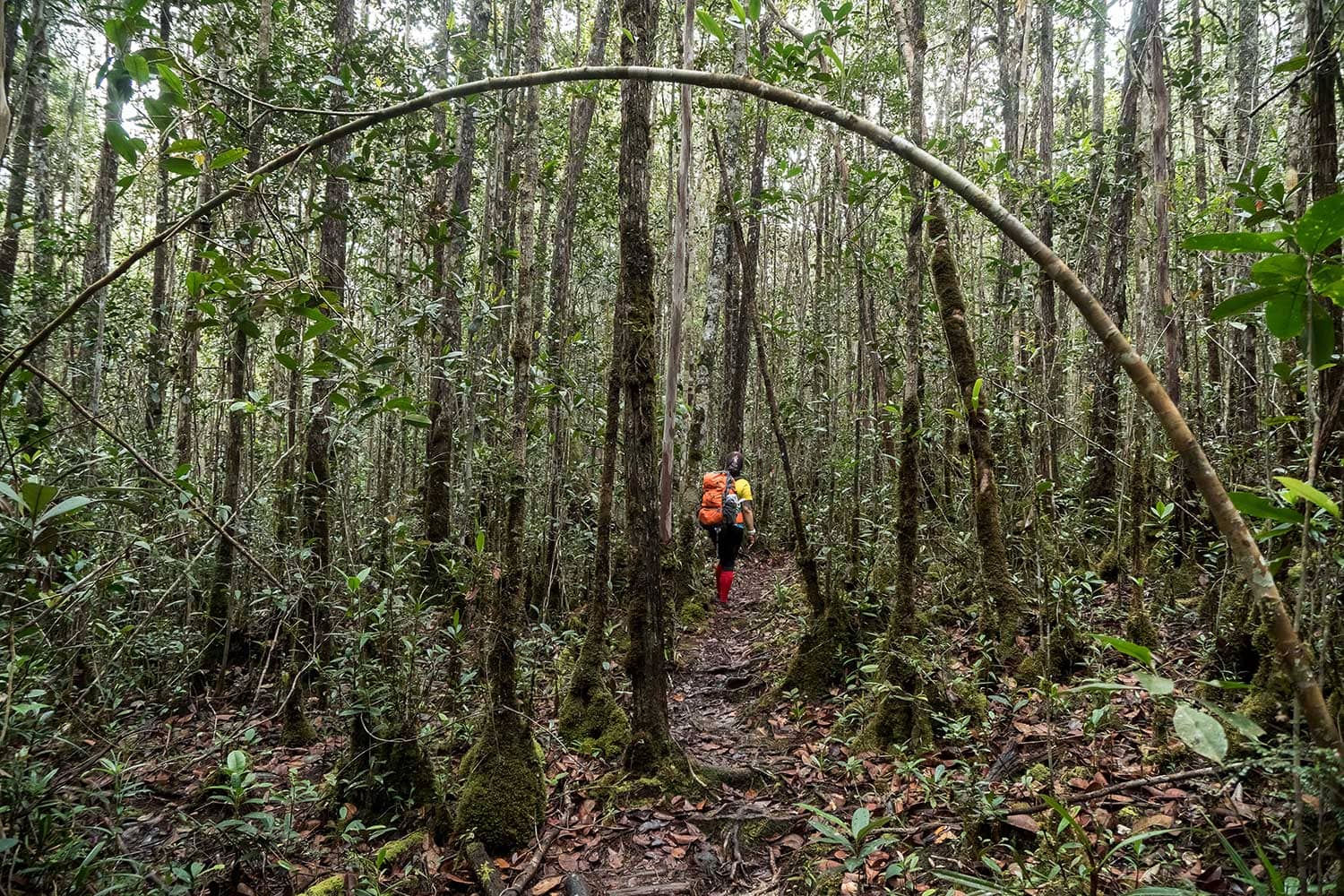
You may find treasures when exploring at any time of the year and each season (wet or dry) offers a slightly different special perspective. But, a personal preference of mine is to visit when rainfall peaks up and it is true the resident leeches are more ‘friendlier’ when wet, however, the basin’s spectacular waterfalls are in full bloom and they are indeed sights to behold.
As its name suggests, the basin is a remarkable saucer-shaped depression enclosed by a mountainous rim housing untouched flora and fauna, many are rare, endangered, and endemic species making this destination unique. 2019 is my 4th year into the basin and each year it never ceases to amaze. It is safe to say that I have only explored a teaspoon full of its wonders.
From an intimate sharing with one of its r angers, he had described his own experience when standing at the highest peak of the basin. During sunrise, he looked down and as the valley opens up to a blanket of misty clouds, flocks of Hornbill set flight across the top of golden-green tree canopies and peeking limestone rocks – such beauty!
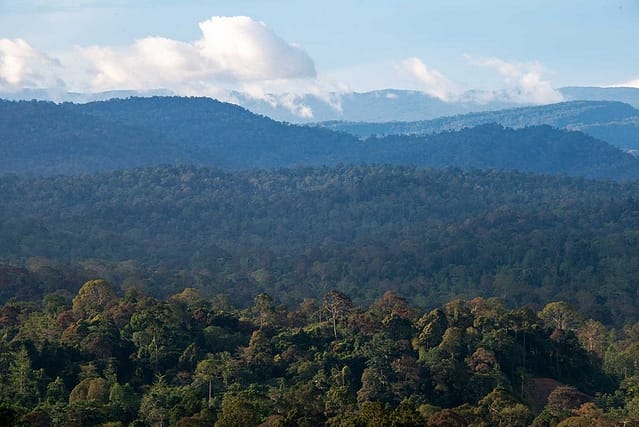
Our journey begins at 7am from Kota Kinabalu City taking the hilly Kimanis Road, a 2-hour drive towards Keningau Town and another 4 hours slow drive reaching Maliau Basin Information Centre / Maliau’s Security Gate with many pit stops along the way. After taking attendance of our arrival, we continued our last 1-hour drive to Maliau Basin Study Centre, stopping for a view of the basin’s rim in the distance. Finally arriving at the study center, we registered, checked into our hostel quarters and re-packed for our 4-day adventure into the magnificent Maliau Basin .
The co-ed hostels are divided into two buildings, each with a large communal sitting area and two sleeping areas accommodating 12 bunked beds (housing 24 people ), each with its own shower and toilet areas. Electricity only ran from 7am to 11pm and we knew that it was our final night in cotton sheets and pillows before heading into more basic living quarters. We met our first ‘wildlife’ lying on the green grass below our stilted hostel – the famous Sus Barbatus , The Bornean Bearded Pig peeking up at us hoping for a free handout of unwanted snacks and some even venture so close finding opportunity to nip at our backpacks!

Maliau Basin Studies Centre
After dinner at 7pm, we had an Introduction to Maliau Basin video presentation at the lecture hall before heading for a short jungle walk around the immediate areas of the center where we spotted wild boars (mom and her babies), deers, sleeping birds, a pair of Binturongs (Bearcat) above a high canopied tree, and various amphibians, and arachnids. As the generator took rest for the night, we headed out for some stargazing along the boardwalks over the lake – thus, concluding our first day.

After a hearty breakfast with the busy rustling of birds and gibbons howling in the background, we departed at 9am towards Agathis Camp, the starting point of our hike. Our porters carefully weighed our food rations, it costs MYR100 for the maximum weight of 12KG and any extra KGs are charged at MYR10 per KG. We carefully strategized our rations and any extra we could carry ourselves we did with our more capable members carrying heavier loads.

At 10am, we took off with on a steady incline up to the rim of the basin – a 7.5-kilometer hike towards Nepenthes Camp for our first-night stay. The initial trail was covered with fallen autumn-colored leaves and large strong-rooted trees with sheltering canopies fighting each other for sunlight. It is beautiful how nature made roots and rocks into steps marking our pathway forward and upon reaching the rim at 3.5-kilometer, Mother Nature greeted us with a steady breeze – the view is great from up here!

From the rim into the basin a sudden change of vegetation is evident as roots and tall trees change into shorter mossy greens, the ground feels more damp and springy, and the climate cooler – welcome to the Primary Rainforest!
Almost there… towards the right a small brown-colored stream starts to form marking that the camp is just 100 meters away and after crossing a bridge and a small hill, we arrived Nepenthes Camp at exactly 1pm for a short rest and to boil some hot ‘tea’ and by ‘tea’ I mean the natural reddish-brown colored water sourced within the basin available for boiling and drinking. According to our ranger the water is reddish-brown due to the high concentration of dark brown humic acids which cause low light penetration and acidic PH values of 4.3 to 5 – this is why after a few days within the basin, using its waters for washing, you are left with smoother skin, and the wonder if you have actually found the mythical ‘fountain of youth’.

With the time and weather on our side, we packed a small day bag and decided to head towards three nearby waterfalls in the area – Giluk Falls (2.7KM), Takob Akob Falls (3.1KM), and Fauzi Falls (2.8KM). The trek towards the junction where the trail splits into three took us 2.5 kilometers from Nepenthes Camp and we visited Giluk first (described as the easiest to get to), then Takob Akob Falls (the most technical to get to) and lastly Fauzi Falls (described as the most romantic and picturesque – we spent most of our time here). Before night fell, we made our way back to Nepenthes Camp for dinner and lights out by 9pm.

The sleeping quarters at the camps within the basin is best described as very basic expedition styled co-ed steel bunk beds with sparse mosquito netting and a thin canvas-covered mattress (no pillows or blankets). It is advised that one is to bring their own sleeping bags – not only for warmth during cold nights but also for hygiene purposes as small rodents do wander around the room in search of food and mattresses may not be wiped down thoroughly. We hung our backpacks on hooks to prevent them from touching the ground and ensuring no rats bite into our belongings at night. The toilet facilities are also very basic and only cold water from the Maliau River is piped into the showers so if you love getting out of your comfort zone and back to basics, you would have no qualms here.

As dawn approached on the third day of our expedition, we packed our bags to head towards Ginseng Camp and as we were having our quick breakfast, a visitor came lurking around the kitchen veranda, a frequent resident of the camp, a shy black and white striped Malayan Civet hunting for scraps of food leftover from the night before. It gave us a few seconds to enjoy its presence before speeding into the thick bushes surrounding the camp.

The hike took us across 6.5 kilometers through the Nepenthes Garden and over Microphone Hill to reach Ginseng Camp where we will spend our final two nights. We departed at 8am and had a wonderful leisurely stroll at the Nepenthes Garden (just 500 meters from Nepenthes Camp) learning about the various trees, ferns, orchids, and pitcher plant species found in the natural wild garden. About 9 Nepenthes species can be found here with the most famous one being the Nepenthes tentaculata – the smallest one found within the basin, measuring as tiny as your littlest fingernail. The trails around the garden are a labyrinth of different passageways filled with fresh wild boar and deer hoof prints so it is best to stick with your guide as to not get lost.

After a good hour of exploring the garden and taking over a hundred pictures, it started to rain and what a wonderful experience it was when the canopy of tall trees start to cover itself with a blanket of mist creating a mystic atmosphere and the smell of fresh dew drops on the mossy forest floor steam up to engulf your senses – I was certain that this is why they called Maliau Basin the Lost World of Borneo!

At 1pm, we arrived at the T-junction between Ginseng Camp, Maliau Falls, and Nepenthes Camp and making a right we reached Ginseng Camp within 15 minutes. Refreshed and headed towards the nearby Ginseng Falls (just 10minutes walk / 300meters away from camp) – this is by far my most favorite as water sprouted at two sections of this enclosed multi-tiered cliff cove providing one with an exceptional view and Instagram-able photo opportunity.

The bedding facilities at Ginseng Camp is the same as Nepenthes Camp but with a more open concept communal sleeping area. The toilet and shower facilities are bigger with more rooms available to accommodate more visitors, and the grounds and communal areas are bigger and more spacious. Comparing the two camps, my group and I agree that Ginseng Camp is by far better. We took our rest after 9pm and woke up at 3am to observe and photograph the Milky Way shining over the silhouette of trees and our camp.

Our fourth day started at 8am and this was our longest hike yet at about 10 kilometers plus a return trip to Maliau Falls – the famous seven-tiered falls of the basin, usually seen as an icon of Maliau Basin featured on the cover of magazines, calendars, books, and brochures. The trail comprises of flat and few hilly terrains with many opportunities to gather more plant portfolios.
A rare and spectacular experience happened along Kilometre 3 to Maliau Falls, we had noticed a steady rustling of trees in the distance and as we tread quietly we noticed that this became more and more prominent – all of a sudden we heard the call of howling Gibbons and as we looked up towards the branches above, we beheld a rare sighting of one staring right back at us with its arms stretching out over the trees as beguiled to see us as we were to see it. No time for photographs, we thought, for this moment only comes once in a lifetime and is to be embraced by our eyes alone. As swift as it came, it left swinging over the canopy.

We reached Maliau Falls at around 11am and as we came across a sign stating ‘Maliau Falls – No Swimming’, we made our way towards a small passageway towards the right and the forest opened up to a view out of the movie Jurassic Park – a flock of Egrets were surprised by our arrival and took flight following the flow of the river which provided an even bigger ambiance impact. Maliau Falls magnanimously stands as one of the biggest / widest accessible waterfalls in the basin to date. During the low water levels, one may also carefully venture behind the fall to experience what it’s like to be sitting on the mossy floor behind a curtain of flowing water.

On our final night at Ginseng Camp, we compared photographs and shared our individual experiences and we all agreed that there is something very special about Maliau Basin. As we hiked on our final 9 kilometers back to Agathis Camp the next day, with a heavy feeling in my heart as I bid farewell to the mossy primary rainforest of the basin back to civilization. I was left with a profound appreciation of the wonders of mother nature and the important part we play in ‘her’ sustainability.

Our venture into Maliau Basin was not just a mere journey or a beautiful expedition, it was in all its rightful glory, a REBIRTH.
Photography by Charles Ryan & Nasier Lee.
Follow our Instagram Feed
Contact info.
Sticky Rice Travel 3rd Floor, 86 Jalan Gaya, 88000 Kota Kinabalu Sabah, Malaysia
+(06) 88 706 737 (Office Phone Number) +(60)10 952 9005 (Operations Hotline)

Copyrights © 2022 Sticky Rice Travel . All Right Reserved.

IMAGES
VIDEO
COMMENTS
The journey takes about 5 to 6 hours. Depart Tawau in the far south-east of Sabah. The journey takes about 4 to 5 hours. In both cases, most of the trip can be made by a standard 2WD standard car. It's once you pass the Maliau Basin Gate and make the 27 kilometer (1 hour) trip to the Maliau Basin Studies Centre that a 4WD is definitely required.
A great Trip To Maliau Basin. Jan 2022. We drove to Maliau Basin in Jan 2022. We were fascinated with the field centre. The accomodation is off the ground and all the walkways are connected which means you are at eye level with trees . It gave us a great opportunity to observe wildlife. The canopy walk is also worth a visit.
Trip notes ; Maliau Basin. I arrive in Tawau, East Sabah, after an hour's flight from Kota Kinabalu. A bumpy six-hour drive delivers me to Maliau Basin, a protected reserve more than twice the size of Kuala Lumpur. My three-day trek, covering approximately 13mi (21km) in Maliau Basin begins. As part of an ecological research team, I have the ...
Welcome to the glorious Maliau Basin, a circle of lush forest and waterways rimmed on all sides by steep cliffs and embankments. Our 8-day trekking expedition takes you into this protected, restricted-access area to discover wild orchids and cascading waterfalls set in forest so green it seems to glow. With a homestay in a historic village and ...
Sabahs Lost World - the Maliau Basin. This is a nine-day journey into Borneo rainforest to visit remote Murut communities, climb the limestone pinnacle rising above the tree canopy and trek into the depths of the Maliau Basin to the heart of what is Sabah's Lost World and cross the rest of Sabah through the Danum Valley reserve and fly out from Lahad Datu or Tuwau.
The Maliau Basin expedition tour is usually packaged for 4 days 3 nights or 5 days 4 nights with physical requirement range from medium to strenuous. ... Trip to Maliau Basin, Sabah's Lost World. Article last reviewed: February 5, 2024. Other Attractions around Tongod. Imbak Canyon Conservation Area.
One of the most popular attractions in the area is the Maliau Basin Skybridge, a 400-meter-long suspension bridge that offers stunning views of the rainforest canopy, and of course the 'Great Maliau Falls' If you're planning a trip to Borneo and are looking for an off-the-beaten-path adventure, Maliau Basin is a must-see destination.
Reaching Maliau Basin requires the use of 4X4 vehicles, and the expedition will require an accompanying forest ranger, as well as our nature guide and porters. A trip here is a true jungle adventure with very low visitor numbers throughout the year. Accommodations and meals are basic, but if you yearn for a remote, challenging, and unique ...
Nestled amongst Borneo's interior lies Maliau Basin, aptly named Sabah's Lost World due to its isolation and the fact that it was unexplored by outsiders until the early 1980's. The unique geological bowl formation of the basin creates a massive water catchment with all water sources leading to the Maliau River, the only point at which ...
Maliau Waterfalls are a spectacular seven-tiered waterfall cascading over and over into Maliau River, with the highest fall reaching a magnificent height of 28 metres. Stop for lunch and rest. 1400hrs: Depart Maliau Waterfalls and return to Ginseng Camp via the same trail. 1700hrs: Expected arrival at Ginseng Camp.
Maliau Basin, also famously known as the lost world of Sabah, is a wetland ecosystem with diverse biodiversity, and an important site for the conservation of orangutans. The area was first discovered by British paleontologist Dr. Charles Hose in 1910 and given its name by him in 1912. At the time, it was considered an ancient lake bed and was ...
Wake up early for breakfast and at 8:00 AM, depart to Maliau Falls on a 4.8km hike per way (average duration 2-3hours). Spend the entire afternoon at Maliau Falls, the most famed and undisputed jewel of all the waterfalls in the Maliau Basin - swim, eat lunch and take in the beautiful surroundings.
Overview. Crave for an experience of an adventure jungle trekking with the natural beauty and astounding scenery of Borneo's last great wilderness, is Sabah's Lost World Maliau Basin. This awe-inspiring biological wonderland is arduous to reach, and well suited for those who do not mind being away from the city comforts and are adequately fit.
The trip begins in quaint Kota Kinabalu and voyages into the wild in the Maliau Basin. +1 (212) 518-1618 +1 (212) 518-1618 Home +1 (212) 518-1618 Search. No results found for: ... Travel into the stunning Maliau Basin and discover a whole new side to nature on this six-day Borneo's Lost World itinerary. The trip begins in quaint Kota Kinabalu ...
The 390 km2 (39,000 hectares) Maliau Basin (Sabah's Lost World) was originally part of a 10,000 km2 (one million hectares) timber concession belonging to Yayasan Sabah (the Sabah Foundation), an organization formed in 1966 through an Enactment by the State Legislative Assembly with the purpose of improving the standard of living and education of Malaysians in Sabah.
About Maliau Basin. Maliau Basin is in the interior of Borneo and is commonly known as Sabah's lost land because it was isolated and unexplored by outsiders until 1980. The geological bowl creates a big water catchment area with water sources leading to Maliau River, the only place the water can escape to. Maliau basin is an important ...
A 5-day, 4-night stay at Maliau Basin costs RM2730 nett for 2 pax adults (Malaysian) and RM3610 nett (non-Malaysian). For a group of 8 to 12 people, the rate for adults is RM1450 nett (Malaysian) and RM2270 (non-Malaysian). The rates in Ringgit Malaysia (RM) are inclusive of meals (breakfast, lunch and dinner), returned transfer (overland ...
Why Maliau Basin? A 6-day-5-night "Full Loop" tour package to Maliau Basin costs me about RM2,000 (about USD$630) even after deep discount and exemption of some fees. Wow, with RM2,000, I can go to China, Bali, Thailand, Vietnam and other foreigner countries already. Going to Maliau Basin is like paying $ to buy suffering, as the trip ...
(Updated: May 2016) A few years ago, a road trip to Maliau Basin required 4-Wheel Drive because of the gravel road in bad condition. Now most of the road from Keningau Town to the gate of Maliau Basin is paved and highly accessible by sedan and small cars. 99% of the road from Keningau town to Maliau Basin (gate) is paved, like the photo above.
Maliau Basin is one of very few places in the world that has never been inhabited by humans. The basin, around six hours' drive south of Kota Kinabalu, is a saucer-shaped area covered in thick rainforest in excess of 390 square kilometres, enclosed by a steep escarpment that rises to a formidable 1,600 metres high.
Day 2: Maliau Basin Studies Centre - Agathis Camp - Ginseng Camp (9km/6 hours) From the MBSC to Agathis Camp, we took the 4 wheel drive and because of the vastly improved road conditions, we took only 30 minutes compared to 1.5 hours in the past. At the start of our trek proper, Agathis Camp.
Maliau Basin Conservation Area. Maliau Basin conversation Area is one of Malaysia's finest remaining wilderness areas. Bounded by formidable escarpment reaching over 1,675 metres above sea level, the almost circular Basin encompasses 390 km of pristine forest, a virtually self-contained ecosystem, never permanently inhabited and with large areas still remaining to be explored and document.
The ever so stunning primary rainforest of Maliau Basin. Our journey begins at 7am from Kota Kinabalu City taking the hilly Kimanis Road, a 2-hour drive towards Keningau Town and another 4 hours slow drive reaching Maliau Basin Information Centre / Maliau's Security Gate with many pit stops along the way. After taking attendance of our ...
5 likes, 0 comments - rresq_sly on July 10, 2023: "NEXT TRIP JULY MALIAU BASIN 19 - 23 JULY Max Pax: 12 pax Slot Available: 5 slot Remarks: OPEN TRIP Mt Sinsing & Mt Kain ...